- 1 800 970 7299
- Live Chat (Online) Live Chat (Offline)
- My Wishlist
- Find a Trip
Your browser 'Internet Explorer' is out of date. Update your browser for more security, comfort and the best experience on this site.


Serengeti Safari Tours & Vacations
- Destinations
- Serengeti Safari Tours & Holidays
Time to play The Circle of Life on repeat...
From the Lion King to Toto's "Africa" to countless episodes of Planet Earth, there's a reason the Serengeti draws so much attention – it's one of the most epic destinations in the world. Here, you can set out across the endless grasslands on an unforgettable safari to spot the sought-after Big Five and other iconic African greats like giraffes, cheetahs and hippos. If you're lucky, you could witness one of the seven wonders of the natural world as wildebeest and zebras thunder across the plains during the Great Migration, and you'll truly connect with nature when you camp in the park with no boundaries between you and the wildlife. Plus, after sitting in her shadow on your game drives , you might even be inspired enough to embark on a Kilimanjaro trek .
Our Serengeti safaris
Gorillas & game parks, 16 days from 3995.
Encounter the wildlife of Kenya and Uganda on this adventure including a gorilla trek...
East Africa Highlights
10 days from 3148.
Travel through East Africa from Kenya to Tanzania, stopping at the Masai Mara, the...
Kenya Wildlife Safari
8 days from 1404.
Experience Kenyan wildlife on an eight day trip travelling from Nairobi to Lake...
East Africa Safari & Coast
13 days from 3964, road to zanzibar, 12 days from 2288.
Experience the beauty of the Ngorongoro and Serengeti, Usambara Mountains and Zanzibar...
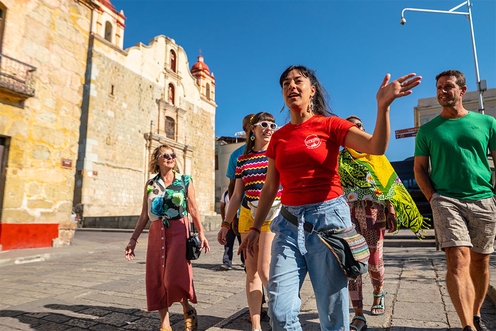
Tailor-Made trips
Take four or more on an exclusive trip and tailor your itinerary
The Masai Heartlands
15 days from 3996.
Uncover Kenya and Tanzania on a 2 week trip with Serengeti safaris, Ngorongoro, Nakuru,...
Serengeti Trail
8 days from 1887.
Roam the Serengeti, Ngorongoro Crater, and Amboseli National Park to spot Africa's Big...
Gorillas, Game Parks & Beaches
27 days from 6592.
Go deep in East Africa on this epic trip, including Kenya, Uganda, Tanzania and Zanzibar.
Gorillas & East Africa Safari
18 days from 9104.
This 18-day tour hits Rwanda, Uganda, Kenya and Tanzania for tracking gorillas in...
Tanzania Family Safari
8 days from 2142.
Experience the people, culture and wildlife of Kenya and Tanzania on a small group...
Best of East Africa
20 days from 4469.
Step out onto the Serengeti and keep your eyes out for rhinos, lions, leopards and a...
Serengeti & Kilimanjaro
15 days from 6084.
Explore the wonders of Tanzania and Kenya, including a trek to the summit of Mt...
Cycle Tanzania
13 days from 3576.
Discover the best of Tanzania on this cycling adventure. Safari through the Serengeti,...
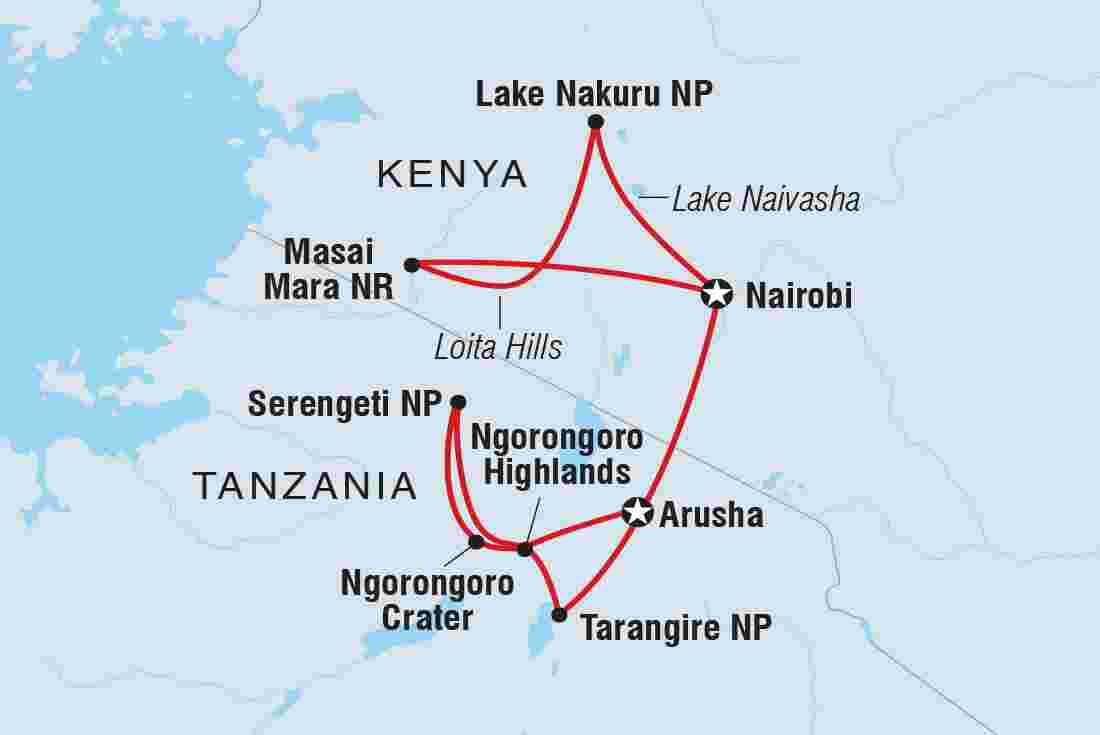
Premium Kenya & Tanzania
15 days from 12550.
Discover the best of Kenya and Tanzania on a Premium adventure through the Masai Mara,...
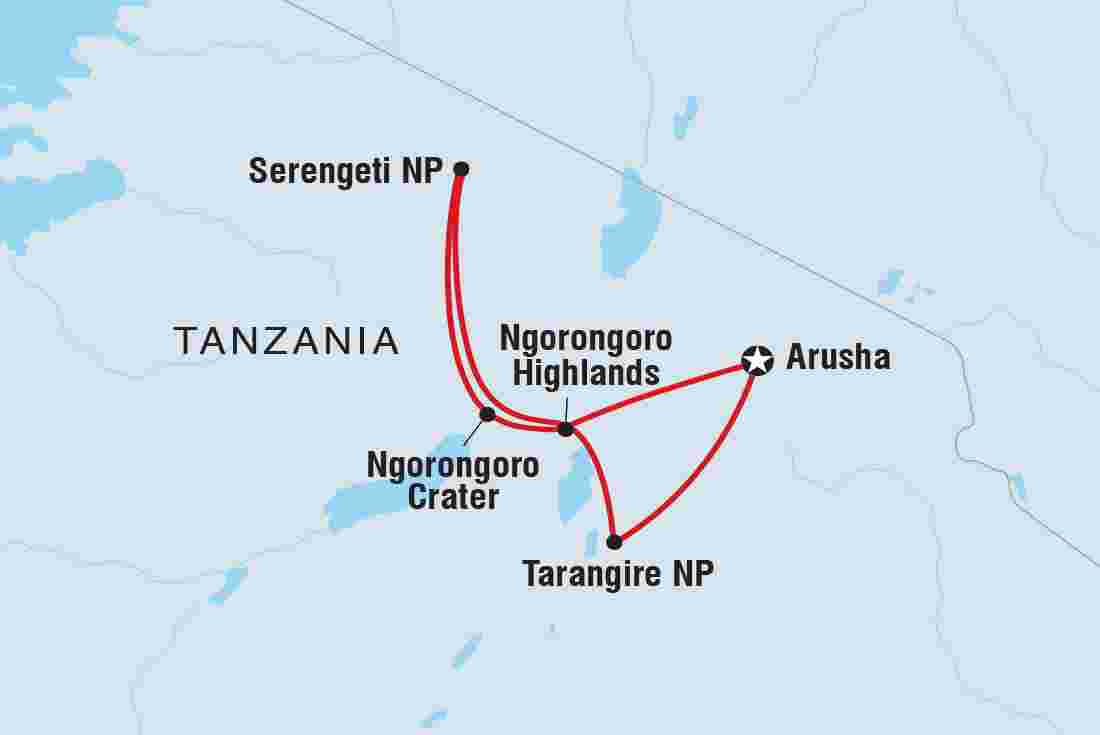
Premium Tanzania
8 days from 5785.
Journey through the highlights of Tanzania on a Premium adventure covering Tarangire...
Nairobi to Stone Town
9 days from 1572.
Marvel at East Africa from Nairobi to Stone Town on this epic trip with safaris, hikes...
Kenya Family Safari
8 days from 2830.
Track your way across the plains of Kenya on this thrilling safari, covering Nairobi,...
Essential East Africa
10 days from 1684.
Hit the (dirt) road through Kenya and Tanzania. Safari in the Serengeti, Ngorongoro...
Africa Encompassed Northbound
64 days from 12940.
This epic journey with explores Southern Africa in detail including Botswana, Kenya,...
Johannesburg to Kenya
37 days from 6959.
Travel the waterways of Botswana, the beaches of Zanzibar and the savannahs of the...
Premium East Africa in Depth
21 days from 18199.
Search for Gorillas in Uganda, uncover the history of Rwanda, explore the wild plains...
Cape Town to Kenya
49 days from 8230.
Experience the ultimate African adventure on this epic trip including Kenya, Botswana,...
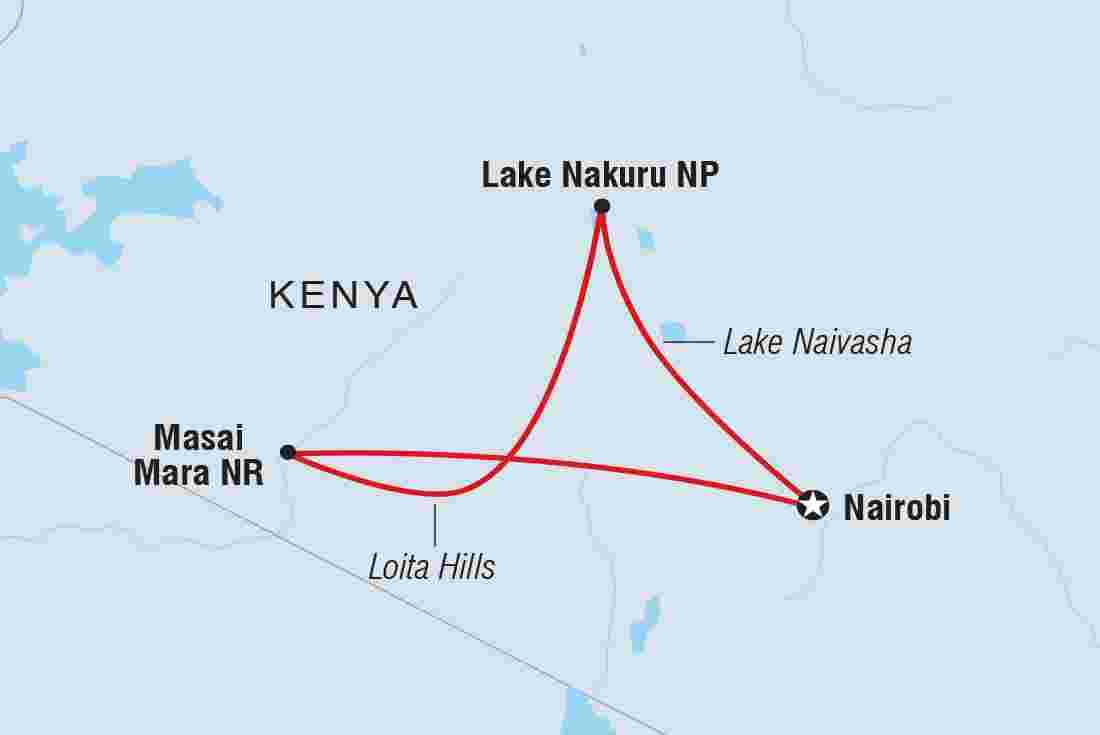
Premium Kenya
7 days from 4667.
Embark on a seven-day Premium journey through Kenya’s wild grasslands and vast plains...
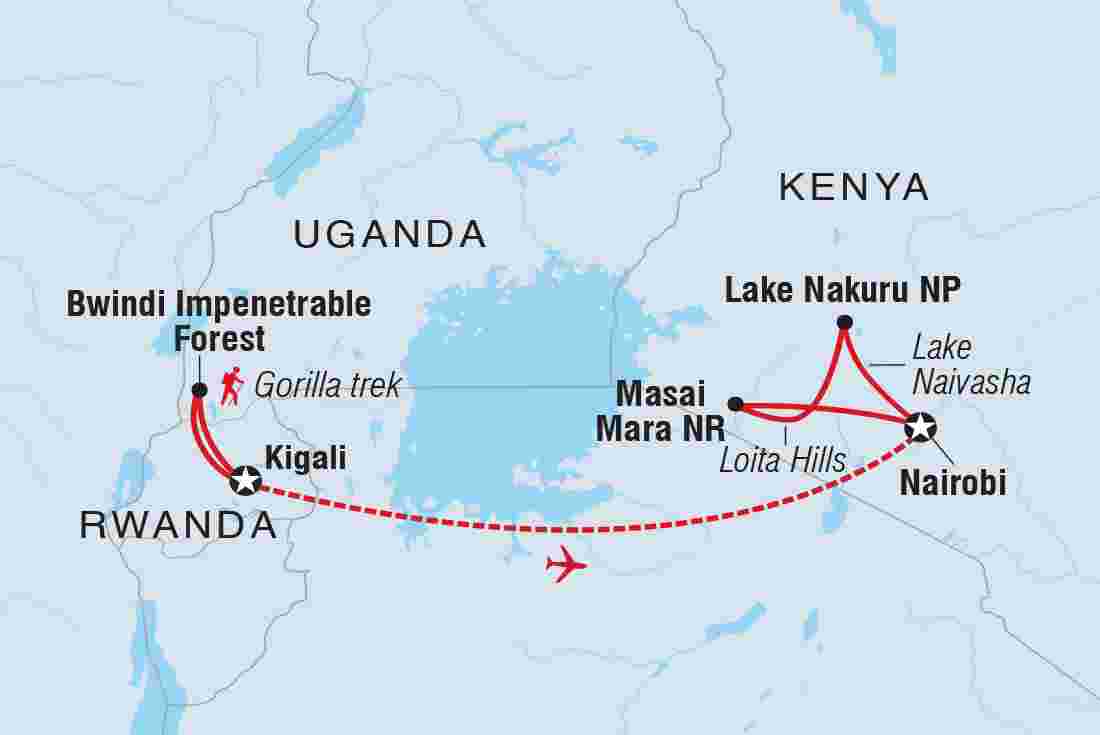
Premium Uganda, Rwanda & Kenya
13 days from 10583.
Search for Gorillas in Uganda, uncover the history of Rwanda, and explore the wild...
Serengeti safari highlights
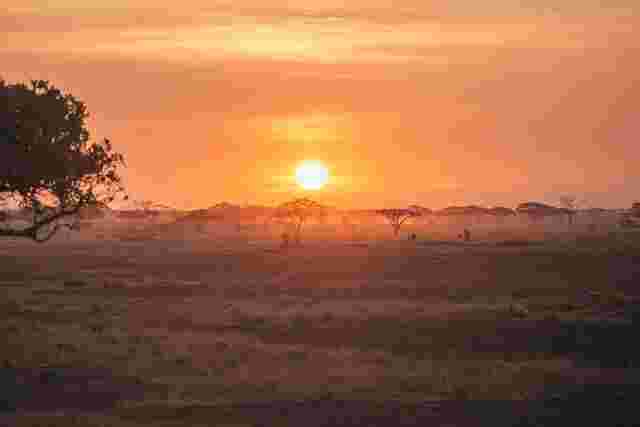
Marvel at never-ending plains
The wide-open plains of the Serengeti are one of the most recognizable African landscapes. Think endless grasslands dotted with umbrella trees and set beneath a backdrop of the towering Mount Kilimanjaro. The name Serengeti is thought to have come from the Maasai word "siringit", which means the place where the land moves on forever. It's impossible to get it...until you do. Watching the sun set over grasslands that appear to stretch to the edges of the earth is an experience you won't soon forget.
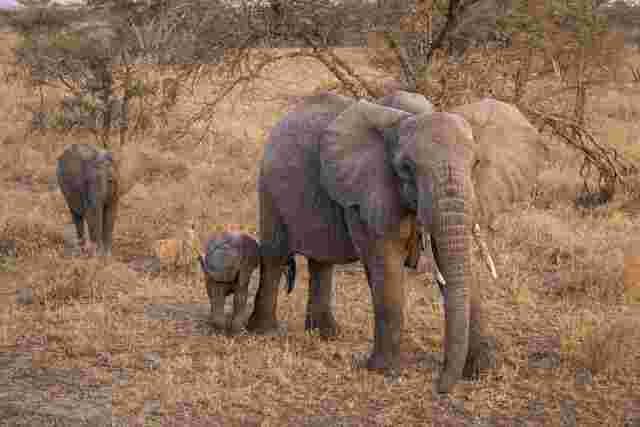
Wave ''hi'' to the Big Five
Serengeti National Park is renowned for its wildlife, and clocking in at over 5,500 sq. miles, there are plenty of predators in residence. From the safety of your vehicle, keep your eyes peeled for Africa's iconic Big Five: lions, elephants, rhinos, leopards and buffalo. Some animals, like the endangered black rhino, can be elusive, and many are active at different times of day, so both early morning and late afternoon game drives are on the itinerary, giving you the best chance of spotting as many species as possible.
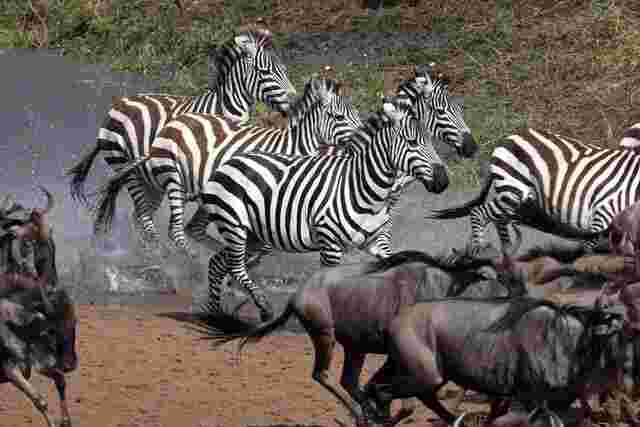
Witness the Great Migration
The Great Migration is one of the world's most spectacular displays of wildlife. Between April and May, over two million wildebeest, plus herds of zebras and antelope, travel across the Serengeti in search of water and greener pastures as the dry season sets in. The animals thunder across the panoramic plains and through rivers — an impressive sight you won't witness elsewhere in Africa.
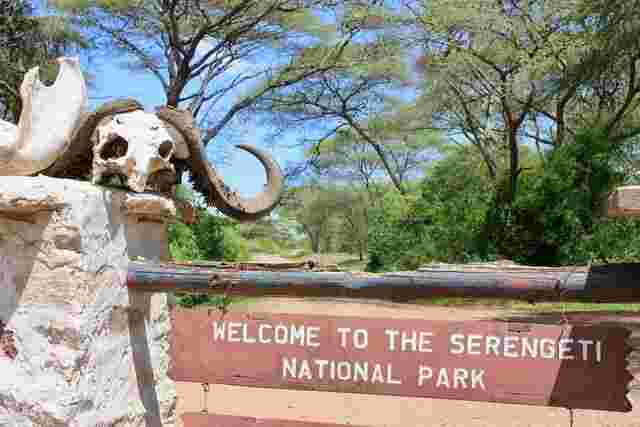
Be a good neighbor
Many of the campsites within the Serengeti are fenceless, meaning you'll have no separation between yourself and the animals. After sundown, you may experience buffalo and hyenas sniffing curiously around your tent, which is quite the experience. Don't worry, though; our experienced local leaders will give a detailed safety briefing, and you'll come to enjoy falling asleep to the ambient sounds of your wildlife neighbors.
Serengeti tour reviews
Serengeti faqs, do i need a covid-19 vaccine to join a serengeti safari.
Trips from 1 January 2023 onwards
From 1 January 2023, Intrepid will no longer require travelers to provide proof of vaccination against COVID-19 (excluding all Polar trips and select adventure cruises). However, we continue to strongly recommend that all Intrepid travelers and leaders get vaccinated to protect themselves and others.
Specific proof of testing or vaccination may still be required by your destination or airline. Please ensure you check travel and entry requirements carefully.
Learn more about Intrepid's COVID-19 policy
When's the best time to go on a safari in the Serengeti?
The Serengeti is located in Tanzania and has fairly consistent, moderate temperatures year-round, with cool mornings and evenings and not-too-hot days, making for a fantastic year-round safari destination. While there are technically two rainy seasons, the “short rains” from November to December and the “long rains” from March to May, rains usually consist of a once-daily thunderstorm, and rarely a total washout.
Read more about the best time to go on safari .
Am I guaranteed to see animals?
We can’t guarantee you’ll spot the Big 5, but you’d have to be seriously unlucky to see no animals at all. On our safaris, you’ll explore some of the best game parks and national reserves in the world. These protected areas are filled with a huge variety of species and your expert driver and local leader will be on hand to point you in the right direction (literally).
What are the "Big Five"?
The “Big 5” used to refer to the five big game animals that were the most difficult to hunt. Now that most shooting is done on a camera, the Big 5 are the most exciting animals to spot while on safari: the lion, leopard, rhinoceros, elephant, and Cape buffalo.
What should I pack for a Serengeti safari?
Loose, light layers in neutral colors are the best attire for a safari (dark colors will get hot in the sun and can attract the Tsetse fly). You’ll also want a sun hat, some good walking shoes, a camera, sunscreen and bug spray. For more details, check out our ultimate Africa packing guide .
What type of food will be served on a Serengeti safari?
It depends on the trip style you've chosen. On our Basix trips, you’ll have a cook traveling with you who'll whip up a variety of local and Western-style dishes. Along your route, your cook will stop to purchase fresh, locally sourced food for your meals. You can expect a variety of things for breakfast like fruit, eggs, toast and cereal; lunch is often sandwiches and salads; and dinner is usually a hearty meal like pasta, curry or a BBQ.
On our Original and Comfort trips there'll be more meals at camps and lodges along the way. One thing's for sure: you definitely won't be going hungry on safari!
What are the toilets and showers like on safari?
Most of the permanent tented camps will have private bathrooms with flushing toilets and showers with warm water.
Many of the campsites we stay at have communal facilities with flushing toilets and showers with warm water. However, in some of the more remote areas, there may only be basic facilities (toilets and cold running water).
Will I be able to use my cell phone on safari?
Some of our hotels and campsites will have Wi-Fi, however, internet and phone access may be limited in more remote areas. But you won’t think twice about emails and social media when you’re watching a pride of lions prowl through long grass or enjoying a drink around the campfire with your group.
Are Intrepid's Serengeti safaris accessible for travelers with disabilities?
We are committed to making travel accessible to everyone, so we will work with you to assess whether you will be able to complete an existing itinerary, or whether we will be able to make reasonable adjustments to meet your needs before you book. Please see our accessible travel page for more information.
Read more about travel in Tanzania

+255 762 468 213
We are a top operator, an operator with experience, expertise and most importantly your best interest at heart.
- Why Choose Us
Great value deals
we put in extra work to ensure our clients get full value of the price paid & the best deals through their stay. Remember price is what you pay, value is what you get.
100% Safari customization
tell us about your trip requirement & we’ll work together to tailor your trip to meet your exact requirement so you have a trip of your dreams.
Constant support
we provide assistance in information & insights from the planning phase of your tour and overall through your stay in the country
Flexible payment options
we accept all forms your payment method be it credit cards, bank transfer to cash, we also have favorable cancellation policy to both parties.
Recommended Local operator
we are 100% locally owned, middle-men free offers and a trusted licensed company you can depend on
Eco & ethical
we follow standards & codes of conduct, are keen and considerate of our clients, staff, environment and community
Deals and Discounts
Our Best Selling Tanzania Tours & Safaris
2 days tanzania budget safari.
- Price: $500 per person
- Tour Type: Budget Safari, Joining Groups
- Place Visited: Arusha, Tarangire, Ngorongoro Crater
3 Days Safari Serengeti & Ngorongoro Crater
- Price: $750 per person
- Place Visited: Arusha, Serengeti, Ngorongoro Crater
3 Days Tanzania Big 5 Budget Safari
- Price: $650 per person
- Place Visited: Arusha, Tarangire, Lake Manyara, Ngorongoro Crater
3 Days Tanzania Safaris, Waterfalls And Coffee Tour
- Price: $620 per person
- Place Visited: Arusha, Tarangire, Ngorongoro Crater, Materuni Waterfalls & coffee tour
4 Day Taste of Tanzania Budget safari
- Price: $900 per person
- Place Visited: Arusha, Tarangire, Serengeti, Ngorongoro Crater
4 Days Serengeti Tanzania Safaris
- Price: $850 per person
5 Days Tanzania Budget Safari With Serengeti
- Price: $1050 per person
5 Days Tanzania Safaris, Waterfalls And Coffee Tour
- Price: $1000 per person
- Place Visited: Arusha, Tarangire, Serengeti, Ngorongoro Crater, Materuni Waterfalls & coffee tour
5 Days Serengeti Experience Budget
- Place Visited: Arusha, Tarangire, Serengeti, Lake Manyara, Ngorongoro Crater
6 Days Highlights Of Africa Vacation Tour Package Tanzania
- Price: $1250 per person
6 Days Tanzania Safari, Culture, Materuni Waterfalls Coffee Tour
- Price: $1200 per person
- Place Visited: Arusha, Tarangire, Serengeti, Lake Manyara, Ngorongoro Crater, Materuni Waterfalls & coffee tour
Most popular Tanzania vacation itineraries
2 days safari to tarangire & ngorongoro – midrange lodge.
- Tour Type: Lodge Safari, Joining Groups
3 Days Safari Serengeti & Ngorongoro Crater Midrange lodge
- Price: $1100 per person
3 days Tanzania big 5 safari-Midrange Lodge
4 days serengeti tanzania safaris- midrange lodge.
- Price: $1450 per person
5 Days Perfect Family Getaway Tour To Tanzania-Midrange Lodge
- Price: $1700 per person
5 Days Tanzania Lodge Safari With Serengeti
- Price: $1800 per person
6 Days Tanzania Lodge Safari With Serengeti
- Price: $2200 per person
7 days safari to Tarangire, Serengeti, Lake Manyara & the Ngorongoro crater
- Price: $2300 per person
- Tour Type: Joining Groups, Lodge Safaris
Private Lodge Safari
A private safari is all about traveling with the people you choose. We can make any existing itinerary private for you. Choose your accommodations,
2 days Lodge safari to Tarangire & Ngorongoro Private
- Tour Type: Lodge Safaris, Private Safaris
2 DAYS OL DOINYO LENGAI MOUNTAIN CLIMBING
- Tour Type: Private Safaris, Camping Safaris
- Place Visited: Arusha, Lake Eyasi, Ol Doinyo Lengai
2-Day Fly-in Zanzibar to Mikumi National Park Safari
- Tour Type: Lodge Safaris, Private Safaris, Fly In Safaris
- Place Visited: Zanzibar, Mikumi national park
2-Day Photographic Fly in & out Ngorongoro Crater
- Price: $1300 per person
3 Days Fly-In & Out Ngorongoro and Materuni waterfalls Coffee Tour
- Price: $1500 per person
- Place Visited: Tarangire, Ngorongoro Crater, Materuni Waterfalls & coffee tour, Zanzibar
3 Days Serengeti and Ngorongoro Crater Fly in Safari
- Price: $1850 per person
- Place Visited: Serengeti, Ngorongoro Crater, Zanzibar
3-Day Fly in Luxury Enjoyable Honeymoon
- Price: $2100 per person
- Tour Type: Lodge Safaris, Luxury Safaris, Private Safaris, Fly In Safaris
4 Days Safari Serengeti & Ngorongoro Crater
4 days ndutu migration safari calving season.
- Place Visited: Arusha, Ngorongoro Crater, Southern Serengeti (Ndutu Area)
- Price: $1600 per person
4 Days Serengeti, Ngorongoro and Tarangire Fly-In Lodge Safari From Zanzibar
- Place Visited: Tarangire, Serengeti, Ngorongoro Crater, Zanzibar
4 Days Serengeti, Ngorongoro Fly-In Lodge Safari From Zanzibar
- Price: $2400 per person
5 Day Ndutu Calving Season Serengeti Migration Tanzania Safari
- Price: $2000 per person
5 Day Luxury Romantic Honeymoon Safari
- Price: $3000 per person
- Tour Type: Luxury Safaris, Private Safaris
- Place Visited: Tarangire, Serengeti, Ngorongoro Crater
5-Day Great Migration Fly in from Zanzibar
6 days tanzania serengeti wildebeests migrations.
- Price: $2600 per person
6-Day Safari with Night Game Drive Tanzania
- Price: $2800 per person
7 days safari to Tarangire, Serengeti, Lake Manyara & the Ngorongoro crater- Private
- Price: $2650 per person
Perfect Destinations
Tanzania is the perfect destination for first-time and returning safaris as the wildlife viewing and African landscapes in the northern circuit are all you could hope for – and more.
- Serengeti National Park
Selous Game Reserve
Lake natron, mikumi national park, kilimanjaro mountain, zanzibar beach, lake manyara national park, the ngorongoro crater.
- Tarangire National Park
Materuni Waterfalls
Mountain Climbing and Trekking
Mount Kilimanjaro Climbing Tour Packages
Customer reviews.
Tanzania Safari Experience We Can Offer
Hike the Majestic Kilimanjaro, Mount Meru and Oldonyo lengai and enjoy your Tanzania adventure
Camping safaris Tanzania are more popular on Northern Tanzania than in the Southern.
Discover Zanzibar's best beaches with its spectacular sunsets, palm-fringed beaches, turquoise waters & colourful coral reefs
Lodge safaris are for the discerning traveller who wishes to experience Eastern Africa's wilderness in comfort and ease.
Tanzania Canoeing Safaris · is the ultimate in relaxing excitement to enjoy the astonishingly beautiful scenery.
Cultural experience
We offer a blend of both Tanzania's wildlife and its cultural heritage safaris
We are pioneers in making bike safaris. Our experience and hard work have made us able to offer unusual routes.
Walking safari
Walking safaris are a great way to meet the magic of the bush. Encountering animals by stepping into their world awakens your senses.
Visit our blog, learn valuable information as you research & plan your Tanzania's experience
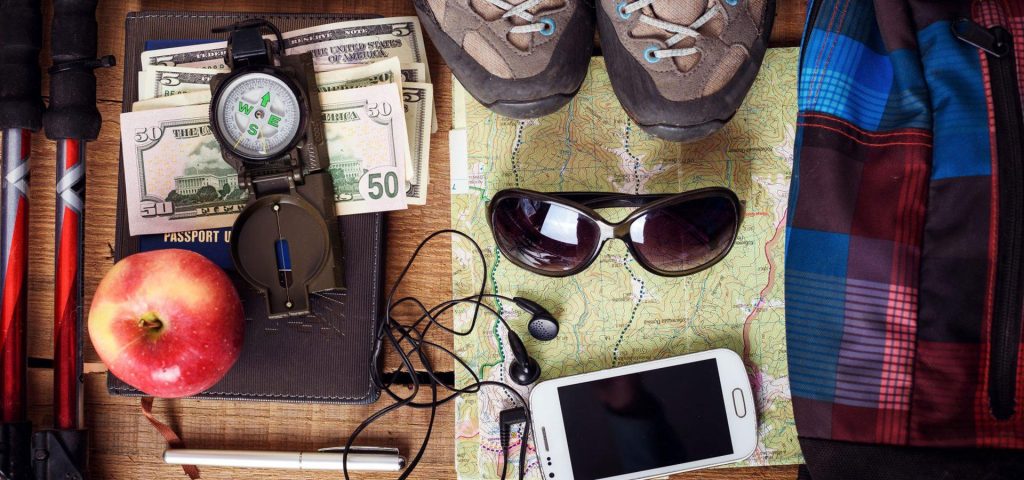
What To Pack For A Tanzania Safari (Safari Packing List)
Whether you are experienced when it comes to safari tours or it is your first time, it is important to know exactly what you need to bring with you in order to not only get the most out of your safari in Tanzania but also to make sure that you- and
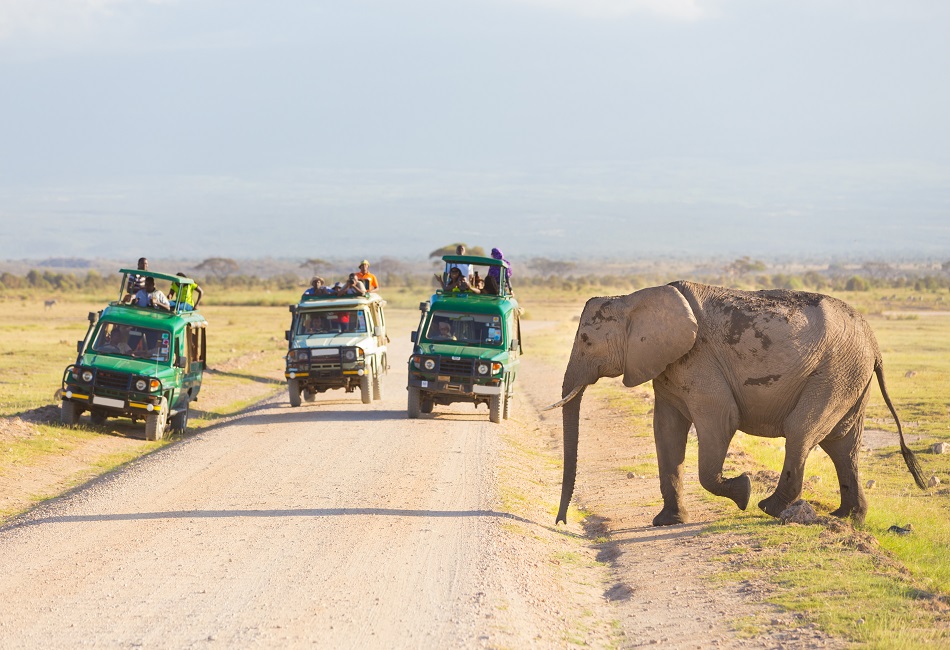
Why a Tanzania Safari is Africa’s Best Safari
Tanzania is arguably the best safari destination in the world, this view is shared by many who have had the opportunity to visit this great country but echoed with great attractions found in the country,
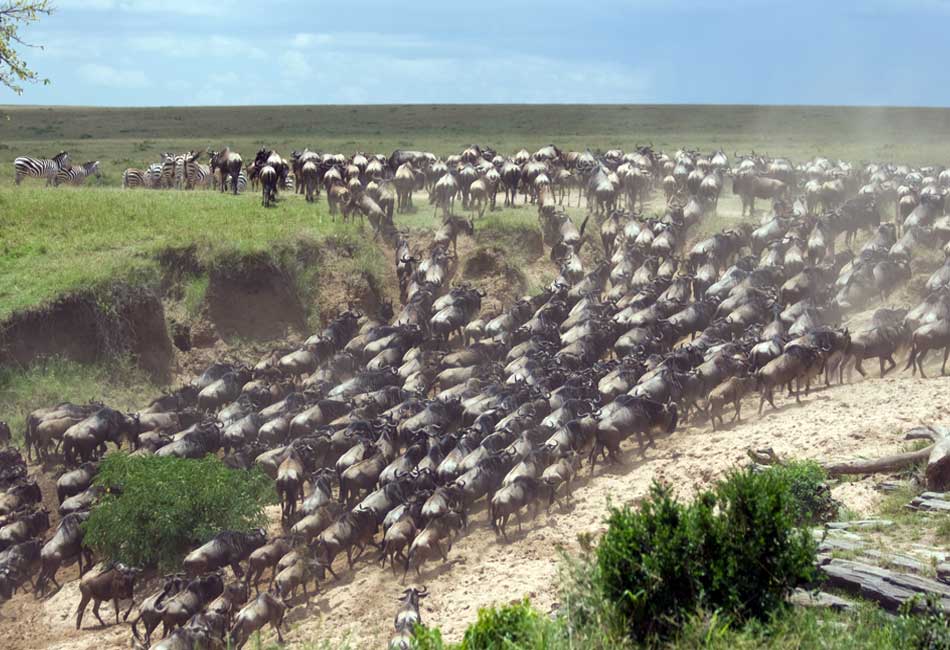
Best Time to Visit Tanzania for Safari and Adventure
Like many other travellers, you are out to have the best experience on your vacation and great timing does the trick, so you now have this question in your mind “when is the best time to visit Tanzania?”
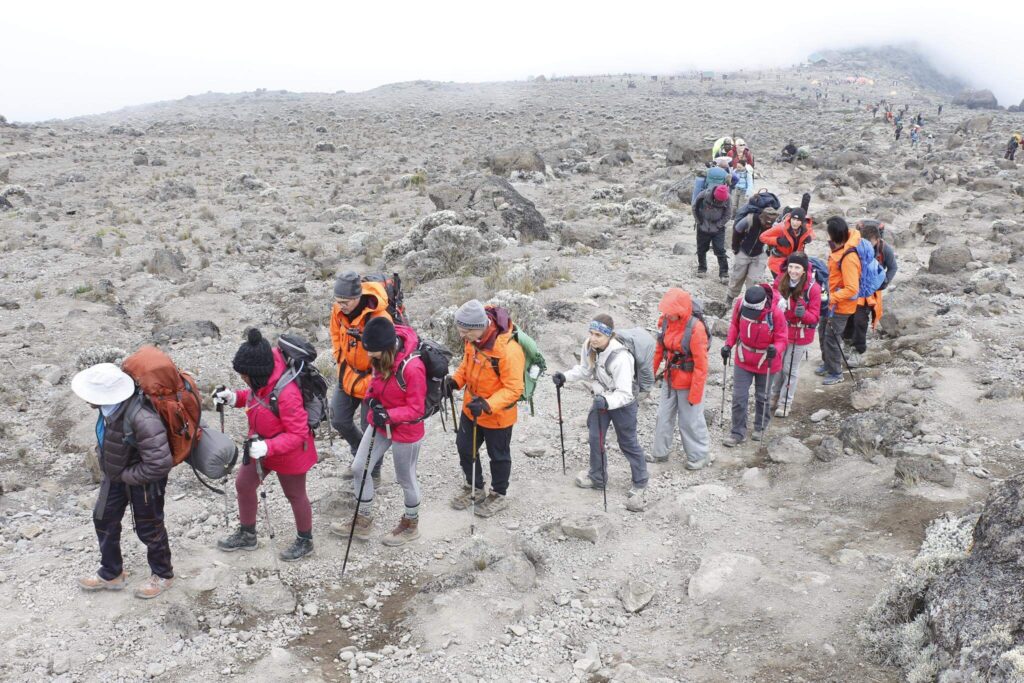
10 Reasons Why You Should Hike Mt Kilimanjaro
Why do 40,000 people a year seek to hike the world’s highest freestanding mountain and highest in Africa?. The mountain is so popular, now well known as “Everyman’s Everest”.
KILIMANJARO CLIMB & WILDERNESS SAFARI FAQ's
Frequently ask questions.
Below are a few general FAQs that you need to know before traveling to Tanzania. In case there is anything you can’t find then please send us an email and we will get back to you with the answer.
We would recommend bringing USD (United States Dollars) with you and withdrawing some Tanzanian Shillings once you arrive. There are ATMs in Arusha/JRO Airport. Most places that you will visit accept USD but it's always good idea to have local currency.
Kilimanjaro International Airport (JRO) is approximately 60km (60 min) from Arusha city centre. Kilimanjaro International Airport is the closest International Airport to Arusha.
Arusha Municipal Airport (ARK) is on the outskirts of Arusha but only operates domestic flights (Dar es Salaam, Zanzibar, Serengeti).
Other options include flying to Dar es Salaam and then catching a domestic flight to Kilimanjaro or Arusha. You can also fly to Nairobi (Kenya). International flights to this destination are often cheaper. You can then fly from Nairobi to Kilimanjaro or take a bus from Nairobi Airport to Arusha (approximately 7 hours).
- Cash in USD before the tour start.
- Pay by card before the tour starts with a 5% card processing fee. (Applicable throughout Tanzania)
- Pay by bank transfer at least 4 weeks in advance.
Waterproof, windproof, breathable pants and jacket with hood Goretex is excellent. packs (like Camelbaks) also work well, although the hose can freeze on the summit climb. Headlamp with extra batteries You might also consider a backup flashlight in case your headlamp fails.
Kilimanjaro and Safaris Packing List You can hire the required gear on the spot when you arrive in Tanzania.
There will be basic First Aid Kit in the Safari Vehicle, also we have it for the Kilimanjaro climbing, but still we recommend bringing a personal First Aid Kit. This is a suggested list of supplies: Sun Screen, Antihistamine cream & tablets,
The weather varies greatly, depending on where you are. Whatever time of year you come, please bring some warm clothes! It gets really cold in some places because of the high altitude, especially in June, July and August. It can also get very hot during afternoon. We advise dressing in layers. Typically, the long rains are March, April, and May. The short rains are in November / early December.
Tipping is highly expected in Tanzania. There is a well- established culture of tipping.
Guides: If you feel you have received good service, a typical tip is U$D 10-15 per person, per day. The guides work extremely long hours and tips supplement their income significantly. Anything you can afford is appreciated.
Tipping in accommodation is also discretionary. Most accommodation will have a tip box in Reception. We would recommend putting something in at the end of your stay, rather than giving individuals money. Depending on the level of service, we recommend $10 per day (for a group of 2).
The crews for one person for Kilimanjaro climbing include: => 1 Guide => 1 Chef Cook => 1 Waiter => 1 Toilet Porters => 4 Supporting Porters
Don’t wait any longer. Contact us!
- [email protected]
- +255 762 468 213 - Tanzania
- +34 632 636 948 - Spain
Serengeti African Tours
- Privacy Policy
- Payment Details
- Terms & Conditions
- Our Booking Process
More Information
- Visa Tanzania
- Tipping Guideline
- Tanzania Safari Packing List
- Best Time to visit Tanzania
- Safety Measures & Guarantee
Tanzania Safari Destinations
- Ngorongoro Crater
- Zanzibar Beach Holliday
- Kilimanjaro Mountain Climbing
Online Payment

BOOKING INQUIRY
We are true experts when it comes to Tanzania. We live, work and travel here. Serengeti African Tours arranges lodge and camping safaris, trekking and hiking tours and beach holidays. We carefully select our well-trained guides, drivers, cooks and porters.
TOP DESTINATIONS
- Kruger Park
- Okavango Delta
- Serengeti National Park
- Victoria Falls
TOP COUNTRIES
- South Africa
TRAVEL DEALS
View All Travel Deals
SOUTHERN AFRICA
East africa, indian ocean islands, top experiences.
- Beach Holidays
- Family Safaris
- Honeymoon Safaris
- Desert Safaris
- Luxury Rail Safaris
- Multi-Generational Safaris
- Positive Impact Safaris
Photographic Safaris
Walking Safaris
WILDLIFE SAFARI
Big Five Safaris
Birding Safaris
- Gorilla Trekking Safaris
Migration Safaris
- Mobile Camping Safaris
- Horseback Safaris
FEATURED EXPERIENCES
Comfort levels, property types.
- Tented Camps
- Boutique Hotels
Featured Safari Collections
- Time & Tide
- Great Plains
- Imvelo Safaris
- Natural Selection
GET TO KNOW US
- Meet The Team
- Pricing Explained
- Traveller Reviews
- Traveller Stories
- Why Book With Us?
- HerdTracker
- Safari Cost Calculator
- South Africa In 360
- Trusted Safari Partners
What are you looking for?
- Safaris & Tours
- Destinations
- Experiences
- Accommodations
- Why book with us?
Hello traveller!
It's in Cape Town now.
We're sorry. Our safari planners aren't available now. Our office hours are 08:00 - 19:00 (GMT+2).
Call us to speak to an experienced safari planner.
Alternatively, we recommend...
Schedule a phone or Zoom call with one of our safari planners
Complete our travel enquiry form to connect with a safari planner
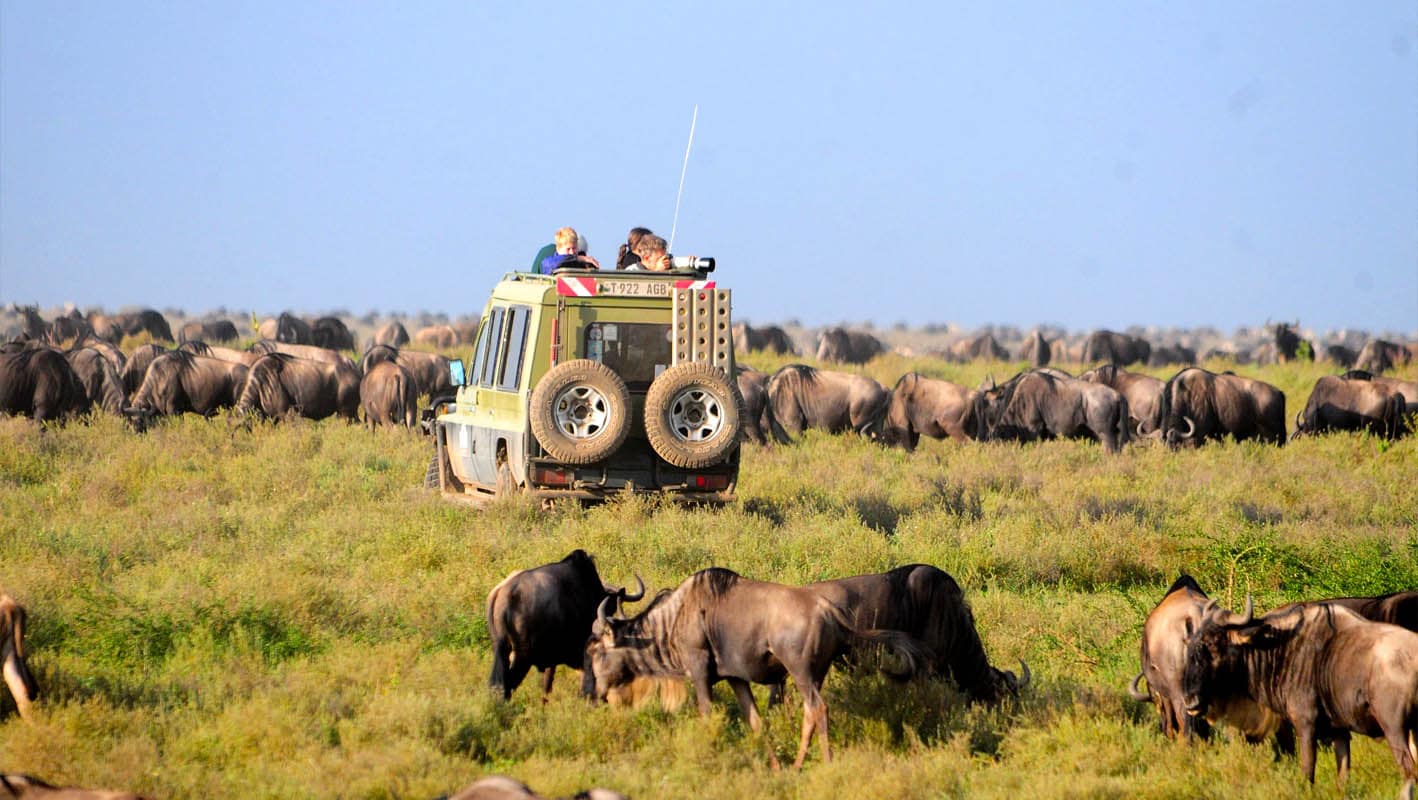
- Serengeti National Park Safari
The ultimate guide to your next Serengeti National Park Safari
Get to know serengeti national park.

By Lana Goodwin
Safari Travel Planner
Abundant game in this World Heritage Site makes it a must-see for anyone interested in the natural world.
Serengeti is arguably the world’s most famous national park – for good reason. This is where the Great Wildebeest Migration takes place each year and where some 3 000 lions and 1 000 leopards control the 15 000 square kilometres of plains and savannah woodland. This unique ecosystem is the only place on earth that can sustain the wildebeest migration, where an annual population explosion of up to 8 000 ungulates are born every day. Here, the circle of life and the survival of the fittest are followed with passionate interest by safari operators, journalists, photographers and other visitors year after year.
Serengeti National Park Video
How it Works
View our recommended safaris for inspiration and get ready to plan your dream safari
Contact us or fill out an enquiry form and one of our travel experts will help you tailor make your perfect safari
Enjoy an authentic African experience.
Why Serengeti?
- Incredible sightings, up to a hundred lion in one day
- Great Migration all year round
- You can still get lost and get away from the crowds
- Space and endless plains
Where to go in Serengeti
- Central Serengeti & Seronera Valley
- Eastern Serengeti
- Ndutu Region
- Northern Serengeti
- Southern Serengeti
- Western Corridor and Grumeti
The Central Serengeti, lying at the heart of this spectacular national park, is the most popular region in the reserve for its abundant wildlife, large numbers of big cats and quintessential Serengeti landscapes of acacia-studded savanna. Resident wildlife makes this part of the Serengeti a fantastic year-round destination, but the months of April to June and October to December, when the herds of the Great Migration pass through the area, are when it’s at its peak.
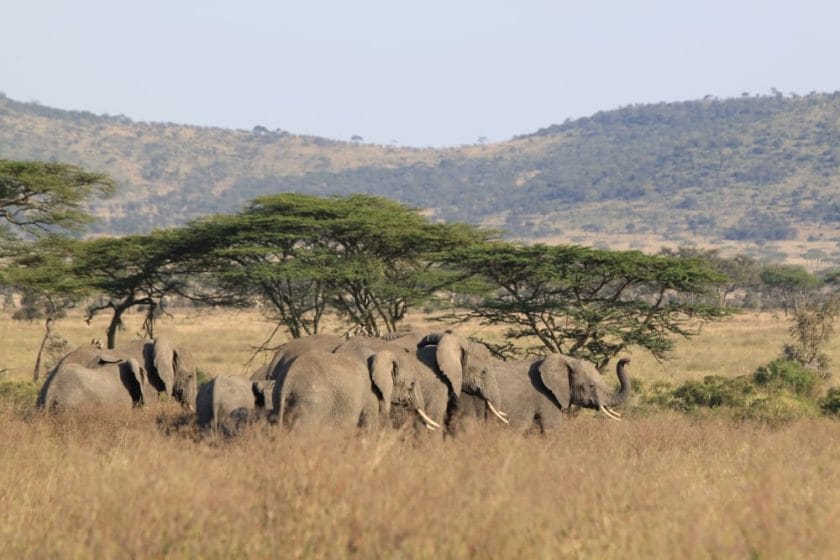
The Seronera River Valley, located in the south-central region of the park, is one of the most popular areas in the entire reserve. Known as the Big Cat Capital of Africa, the Seronera is rich in lion, leopard and cheetah – and people often spot all three in one day of game drives. Look for leopard around the Seronera River, which is home to one of Africa’s densest populations of the big cats, while lions can often be seen on the kopjes (rocky outcrops). The Serengeti Plains – the open savanna south of the Seronera River – are prime cheetah territory. Other animals to spot in the area’s varied habitats of rivers, swamps, kopjes and grasslands include elephant, hippos and crocodiles in the rivers, buffaloes, impala, topi, jackals and bat-eared foxes.
While the year-round supply of water from the Seronera River means that the area is excellent for wildlife spotting throughout the year, April to June is the peak season for game viewing in the Seronera, as this is when the plains are full of migrating wildebeest, zebra and gazelle as they’re making their way up north. The central location of the Seronera means that it’s one of the best places to see the Great Migration in action, as the animals are moving through the area for months.
The Central Serengeti is a fantastic area to see the Great Migration in action: the herds move through this section of the park from April to June as they travel northwards, and then they come back again heading south from October to December. Some of the best locations in the Central Serengeti to see the herds include the Seronera Valley and Seronera River, Moru Kopjes, Simba Kopje and Maasai Kopjes.
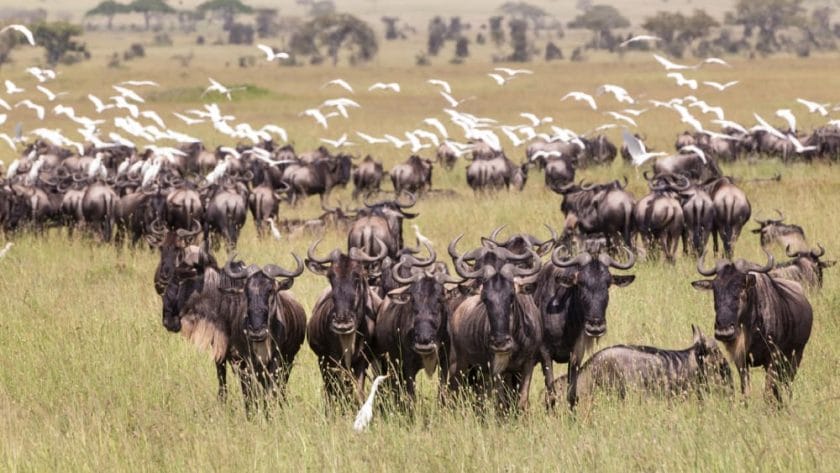
If you’re after Big Cats, the Seronera area in the Central Serengeti is your best bet: this region is hailed as the best place to see predators – particularly lion, leopard and cheetah – on thrilling hunts.
The Central Serengeti is studded with many rocky granite outcrops, known as kopjes, which are where you should look out for lions and cheetahs. There are also some particular kopje highlights, such the Simba Kopje, or Simba Rocks – the place that inspired Pride Rock in the Disney film The Lion King. The film link is not the only reason to visit this pile of granite boulders however – it’s great spot to see lions, which are often lying on the rocks under the sun. At Moru Kopjes, south of the Seronera River, you can try and search for some of the last remaining black rhinos in the entire reserve – as well as see some old rock art paintings. Then there’s a visitor’s centre for the Serengeti Rhino Project, where you can learn about the important rhino conservation work that’s being done to protect this highly endangered species. Moru Kopjes is also one of the very few areas of the park where you can do multi-day walking safaris.
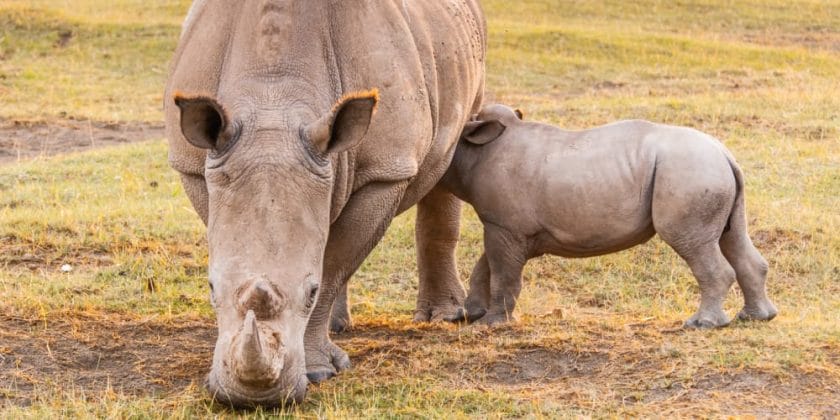
Hot air ballooning is a must-do when you’re visiting the Serengeti. Floating gently above the grassy plains in the golden light of dawn, spotting animals from your suspended basket is an experience you’ll never forget. If you’re staying in the Central Serengeti, you can get a transfer to and from your lodge or camp to the hot air ballooning launch site near the Masai Kopjes. A champagne breakfast once you land is the cherry on top of an amazing activity.
Many lodges and camps offer a visit to a Maasai village so that you can learn more about the famous semi-nomadic pastoralist tribe who have long lived in the area that is now the Serengeti and the Masai Mara national parks. At the Maasai village you’ll be treated to members of the village singing and dancing, with the male warriors doing a traditional jumping dance. You’ll also be able to buy beautiful jewellery and handmade crafts, which make great souvenirs – and also support the local economy.
Travel Tips
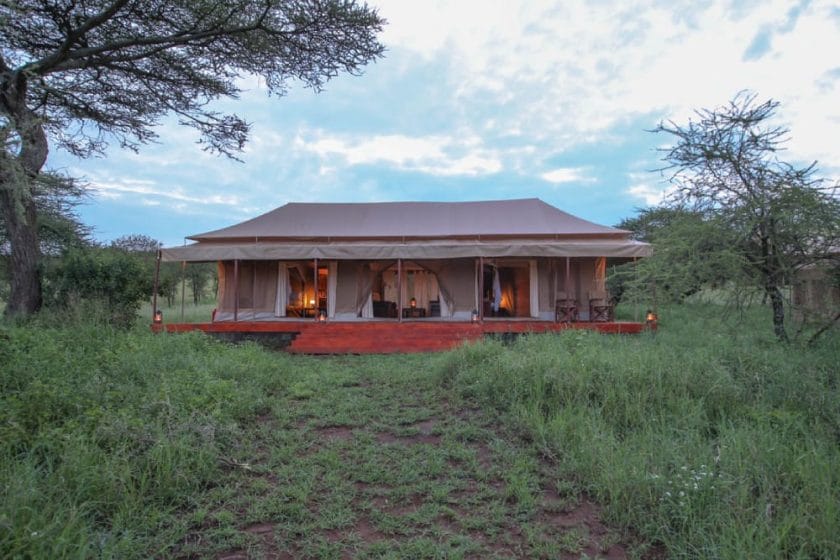
The Seronera region, as the most popular area of the park, has a wealth of lodging options ranging from budget-friendly through to mid-range and up to all-out luxury, with some of the park’s best high-end properties. Budget travellers can camp under the stars at the rustic Seronera Campsite, while travellers looking for mid-range options will find affordable lodges and camps – many of which are family friendly and offer the full range of amenities such as WiFi. You’re spoiled for choice when it comes to luxury camps: there are mobile camps which move with the Great Migration herds (and don’t scrimp on comfort, with proper beds, hot bucket showers and private butlers), beautifully designed lodges with private infinity pools and activities such as guided meditation sessions in the bush, bush picnics and stargazing.
The park headquarters are also based in Seronera (close to the airstrip), where there’s a visitor information centre, a curio shop and a café.
The Seronera gets particularly busy during the most popular months of June and July and October to April and sightings can be overpopulated. If escaping the crowds is your priority and you’re travelling in these months, consider booking your lodging in another part of the park.
Seronera is accessible by road on a six-hour drive from both Arusha and Mwanza, but the easiest option to access this part of the park is to fly into the Seronera airstrip and stay at a lodge that caters for fly-in travellers: they’ll come and pick you up from the airstrip and provide game drives in their vehicles.
Some of the lodges and camps offer short walks in the bush of two to four hours with Maasai guides, who’ll teach you about the smaller creatures and the plants that you miss on game drives. If walking is something you’d like to experience, do some research on lodges that offer this activity.
The Eastern Serengeti is one of the most beautiful regions of the park: mountains, valleys and sweeping grassy plains with are lush in the green season dotted with granite outcrops and sliced through by meandering rivers. It’s one of the more remote regions of the park, which makes it perfect for adventurous travellers who prefer their safaris off the beaten track.
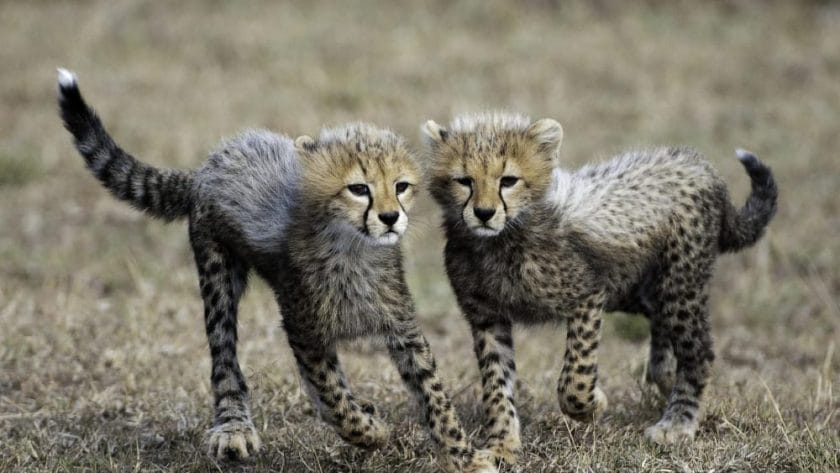
The region can be visited year-round for wildlife sightings, but November to February are the best months to see the Great Migration herds passing through towards the Southern Serengeti. The green season of December to May sees the plains become lush and verdant, which attracts abundant game. Home to the biggest concentration of cheetah on the continent, the Gol Kopjes is the most famous landmark in the Eastern Serengeti, while the area is also known for its lion and leopard sightings.
Under two hours’ drive from the Central Serengeti, the Soit Le Motonyi region, which opened in 2014 after being closed for two decades for cheetah conservation, is drawing visitors for its pristine, totally undeveloped landscapes of grassy plains and acacia woodlands, completely secluded camps – and for cheetah.
Spotting cheetah is a big highlight of a safari to the Eastern Serengeti, and the prime area is Gol Kopjes. Known as the world’s largest Japanese rock garden, the Gol Kopjes – huge granite rock formations – are home to the highest concentration of cheetah on the continent, and offer some of the best game viewing opportunities in the Serengeti during the rainy season from January to June, when the Great Migration herds are passing through the area.
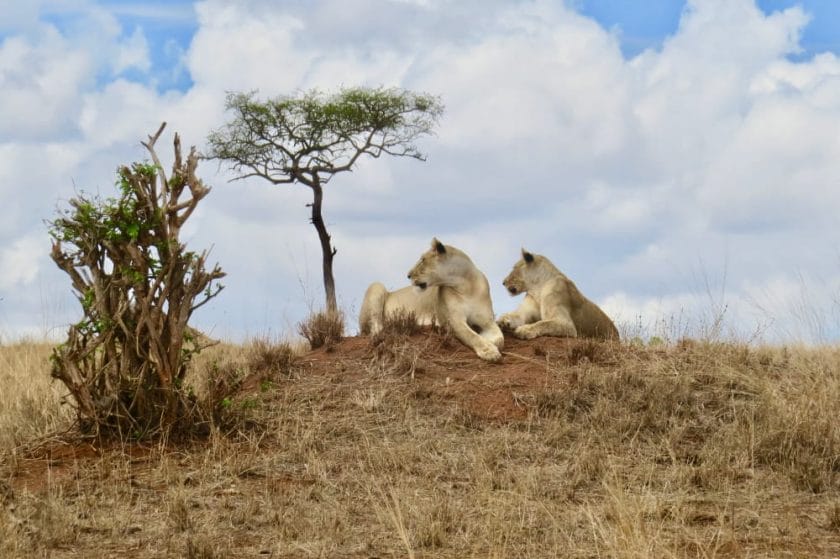
To experience rugged wilderness with very few other visitors, the newly re-opened Soit Le Motonyi region, where short grassy plains meet acacia woodlands, is one of the most remote and least developed corners of the Serengeti. The area was inaccessible to the public for twenty years for cheetah conservation, and now it’s the best place in the Serengeti to see a huge concentration of cheetah undisturbed by other cars and tourists. The Great Migration herds pass the area between November and April (with the “long rains” period of March to May attracting a huge number of feasting hyena), and leopard and lion can be spotted on the rocky outcrops, while there’s other wildlife to spot year-round thanks to a permanent water supply. There are only two camps in the Soit Le Motonyi area, and activity highlights include walking safaris and spending time with a cheetah researcher learning about conservation strategies and helping to collate data on cheetahs that you spot.
If you’re staying in the Eastern Serengeti, consider making a side trip outside of the park to visit Lake Natron, a brightly hued lake with a pinkish crust that attracts millions of flamingos between June and November. You can swim in the lake, and explore the surrounding scenery, which is remarkable – think volcanic craters, waterfalls and gorges. Close by to the southern end of the lake, the active volcano Ol Doinyo Lengai (“Mountain of God” in Maasai) looms over the Rift Valley. Adventurous travellers who are up for a bit of a challenge can tackle the 2962-metre ascent of Ol Doinyo Legai over three days.
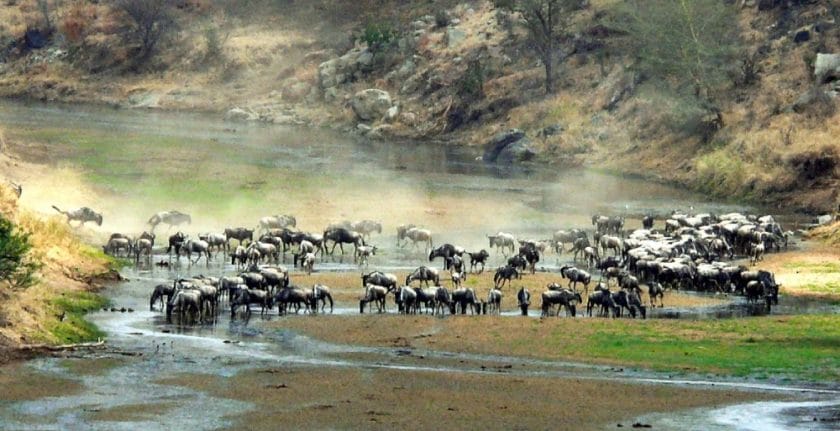
There’s a limited amount of lodging in the Eastern Serengeti, which is perfect if you like seclusion and privacy, but it does mean that you need to book far in advance.
If you’re staying at a camp in the Soit Le Motonyi region, then the closest airstrip is Seronera, which is around one and a half hours’ drive away. Note that there are only two camps in Soit Le Motonyi, so you’ll need to book in advance for the high seasons of December to February and June to October.
The Ndutu Region forms part of the northern section of Ngorongoro Conservation Area and stretches to the unfenced southern reaches of the Serengeti National Park, a meeting point between these two incredible wilderness areas. This section of the park is made up of rolling grasslands peppered with alkaline lakes that attract flocks of flamingos, as well as acacia woodlands.
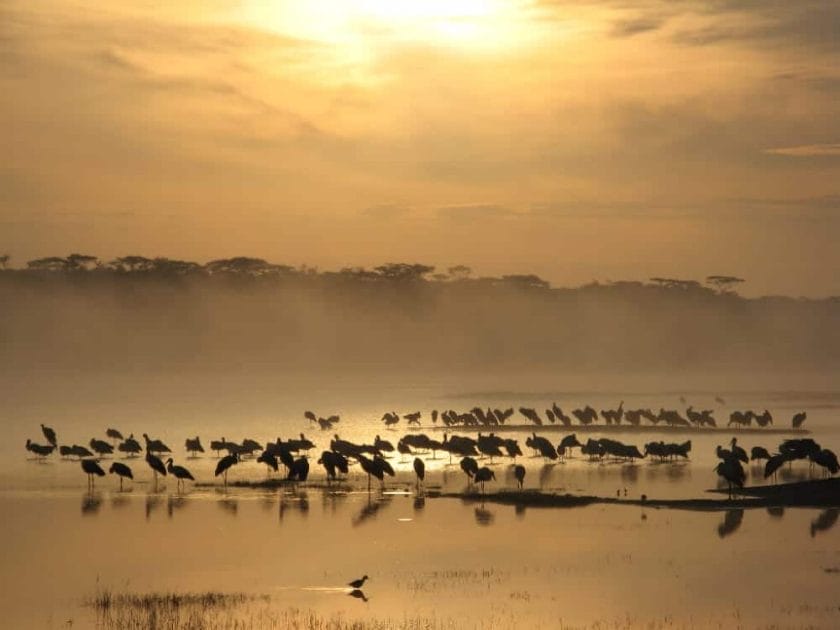
There’s year-round resident wildlife (such as giraffe, elephant, hyena and various antelope species) in the Ndutu Region, and you can spot animals around the waterholes during the dry season from June to November. Look out for the six cat species – lion, cheetah, leopard, serval, African wild cat and caracal – that are present throughout the year.
The best months to visit the Ndutu Region are from December, when the Great Migration herds start to arrive from the north, until April when the millions of wildebeest, zebra and gazelle have trekked northwards again. In the early months of the year – with a peak in February – the wildebeest herds are calving on the verdant grassy plains: thousands upon thousands of baby animals are born every day, attracting the attention of cheetah, lion and hyena.
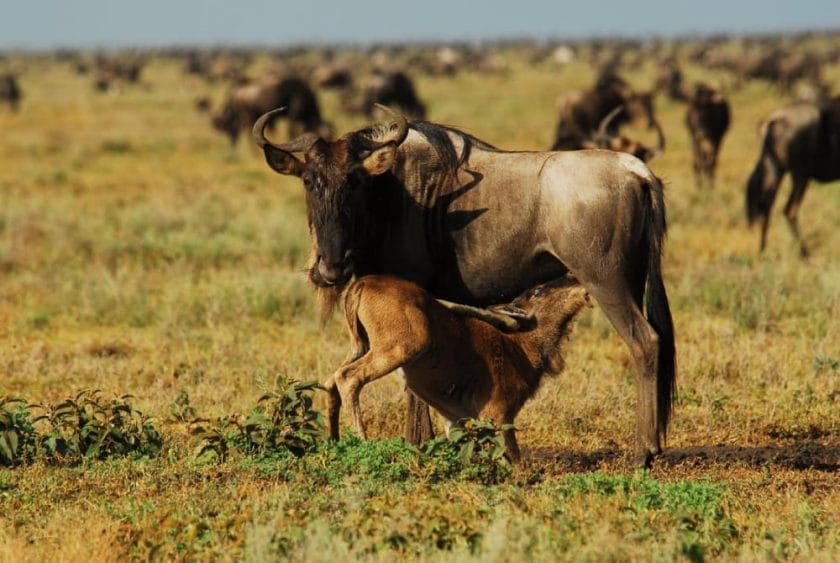
A big draw of the Ndutu Region is to see the full circle of the Great Migration, from the return of the herds to graze in December, and then the calving which takes place in January and February, and then the departure of the herds again in April as they start making their journey northwards. Calving season is particularly dramatic: a million wildebeest give birth to 8000 babies every day, and as these newborns take their first steps, they’re targeted by lion, leopard, cheetah and hyena.
The prime game viewing spot in the Ndutu Region is around Lake Ndutu, where enormous herds congregate between December and April to graze and calve. The forests and granite kopjes around Lake Ndutu are also home to lots of game outside of the migration months.
Sightings of six species of cats – leopard, lion, cheetah, caracal, African wildcat and serval – are a big highlight of visiting the Ndutu Region. You can spot the cats throughout the year, but the best viewing is during the calving months of January and February, when these predators pick on the fledgling baby animals.
A trip to Ndutu is not just about wildlife and landscapes – there’s incredible cultural heritage to explore too. Lying within the Ndutu Region, Olduvai Gorge (also known as Oldupai – the correct Maasai spelling of the word) is one of the world’s most significant paleoanthropological sites, thanks to the discovery of the earliest evidence of the existence of our human ancestors. Visit the dramatic ravine and spend some time in the museum to learn about the fascinating excavations and discoveries that have taken place here. A visit to Olduvai Gorge should be combined with a stop at the nearby Shifting Sands: mysterious and beautiful dunes formed of volcanic ash that move with the winds.
For adventurous travellers, you can do multi-day walking safaris starting in the Ndutu Region and heading into the highlands of the Ngorongoro Conservation Area, and for the very intrepid, you can combine the walking safari with an ascent up the active volcano of Ol Doinyo Lengai.
Day trips to the Ngorongoro Crater are a highlight of staying in the Ndutu Region. The remains of a massive volcano, the Ngorongoro is one of the most superb wilderness areas on the continent, and boasts some of the greatest populations of animals – particularly predators – found in Africa.
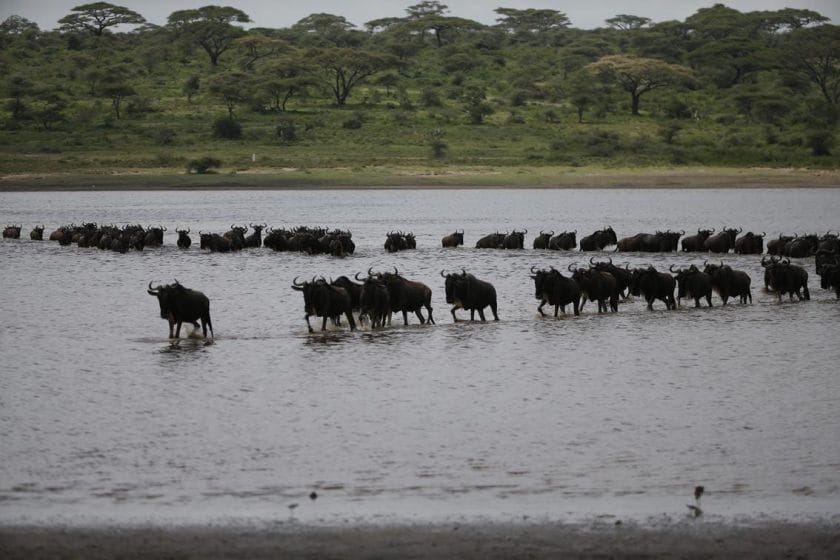
With no public campsites, Ndutu isn’t the best region for budget travellers. Your best budget-friendly option would be to stay at one of the mid-range mobile tented camps that operate in the area.
As with most areas of the Serengeti, camps and lodges are mainly in the upmarket range. Due to the seasonal nature of wildlife, lodges tend to only open for the peak season from November to March.
Camps and lodges in the Ndutu Region can either be located in the Ngorongoro Conservation Area or in the Serengeti National Park, so keep in mind that you’ll need to pay park fees for each park if you’re staying in one park and doing game drives in the other.
You can reach the Ndutu region by road from Arusha, which is around six hours’ drive away through the Ngorongoro Conservation Area. A quicker way to reach your lodge if you’re not self-driving is by air: the Ndutu Region is served by several airstrips, and it’s a quick flight from Arusha.
The Northern Serengeti offers a chance to escape the crowds: this region of the park – wedged between the Central Serengeti and Kenya’s Masai Mara National Reserve to the north – is remote and relatively inaccessible, which means it sees fewer visitors. Travellers who make it to this corner of the Serengeti will be rewarded with gorgeous landscapes of green rolling hills, granite outcrops and acacia woodlands dotting open savanna, incredible wildlife, and most importantly, with massive herds of wildebeest and zebra making dangerous crossing of the croc-infested Mara River during the Great Migration in June and July and again in September, October and November. This sector of the park is also home to the greatest concentration of elephant in the Serengeti, as well as good numbers of lion, leopard, cheetah and hyena and diverse resident animals such as giraffe, topi, eland and hippo.
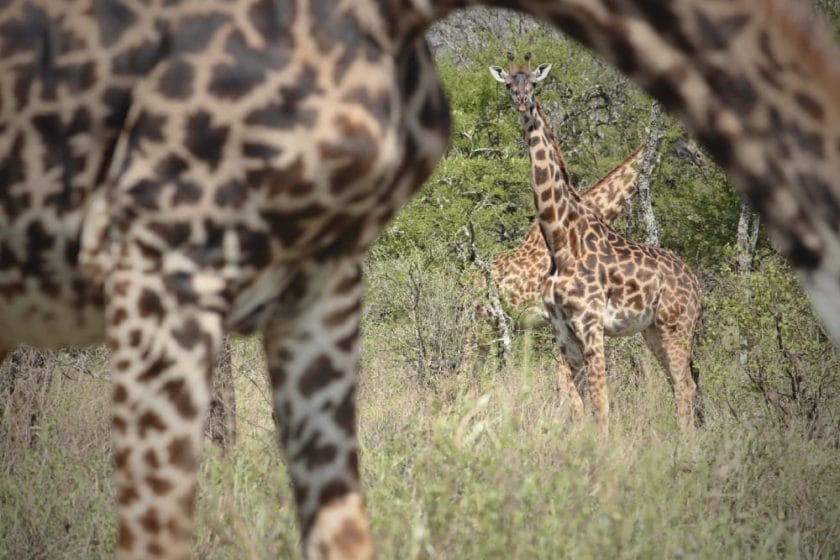
Lying in the park’s north eastern corner, the remote Lobo Valley is a particularly beautiful part of the park, encompassing open plains, rolling hills, dramatic kopjes and woodlands. It’s known for large elephant herds and the second largest lion pride in the Serengeti, and it’s not unusual to spot lion, leopard and cheetah on one game drive. The Lobo Valley is also home to year-round resident game such as giraffe, hartebeest, topi and buffalo, while the herds of the Great Migration pass through the valley in July and August moving north, and then return on their southwards journey between September and November.
Outside of the park’s boundaries to the east and bordering Kenya’s Masai Mara National Reserve and the Ngorongoro Conservation Area, the Maasai-owned Loliondo Game Controlled Area is nearly a third of the size of the Serengeti itself. This private concession is an important wildlife corridor and the herds of the Great Migration pass through here on their southwards march from Kenya in November and December. The benefit of staying in lodges in the Loliondo is seeing all of the wildlife of the Serengeti but with the activities that are not permitted in the national park: night drives and off-road driving. Lodges also offer walking safaris and cultural activities with the Maasai.
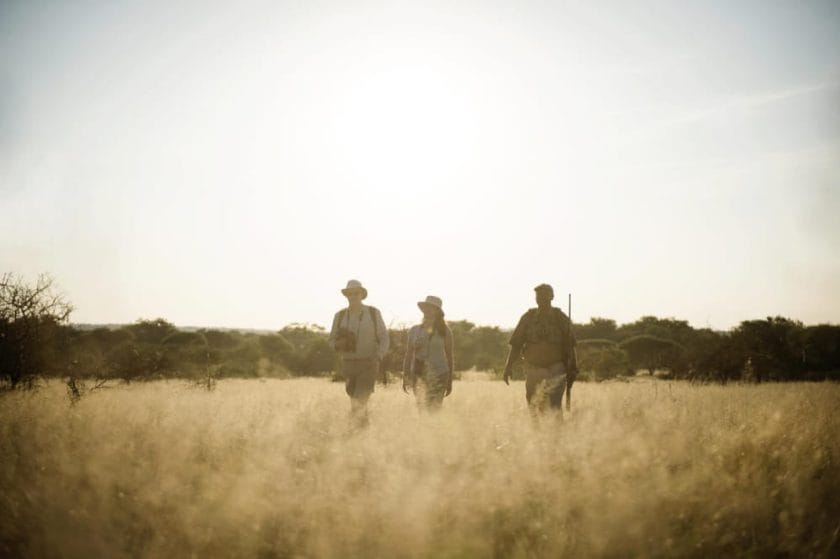
The Mara River, which courses its way through the Northern Serengeti and then into Lake Victoria to the west, is undoubtedly the highlight of this remote region of the Serengeti. The river is home to giant pods of hippos and attracts an abundance of game, from giraffe and elephant to leopard and lion. Between July and September, the Mara River becomes the site of thousands upon thousands of wildebeest and zebra battling currents and huge Nile crocodiles to reach the opposite bank, where they make their way north into the Masai Mara in neighbouring Kenya. These thrilling river crossings are a big highlight of seeing the Great Migration in action, and while across the border in Kenya these sightings can become crowded with game drive vehicles, there are far fewer tourists on the Serengeti side of the river.
Walking safaris are a recent addition in the Serengeti, and there aren’t many places in the park where they are offered. One location is from Kogatende, near the Mara River. On a multi-day adventure, you’ll just carry a day pack, staying at temporary camps with comfortable beds and delicious meals prepared for you by camp staff. Walking in the wilderness is the ultimate way to experience the Serengeti’s wildlife and scenery, and going camping in the bush and sleeping under the stars definitely takes the usual safari experience up several notches.
Go hot air ballooning one morning during your safari in the Northern Serengeti to be treated to sunrise views over the plains and 360-degree wildlife spotting from the air. The magical dawn flight ends with a lavish champagne breakfast when you land on the plains.
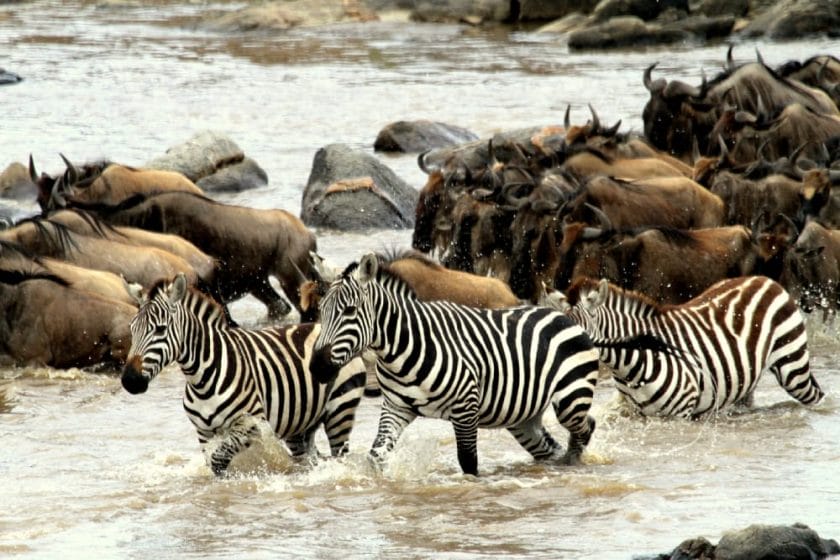
The best months to visit the Northern Serengeti are June until October, while for Mara River crossings the peak months are from July to September.
Lodging options are limited in the Northern Serengeti, as there is only a handful of permanent lodges in the area. During the peak months of the Migration, from July to October, mobile camps move into the area to provide the perfectly located places to stay to catch the exciting Mara River crossings. There are a few mobile camps and lodges in the Loliondo Game Controlled Area on their own private concessions. Lodging is largely in the high-end category, but there is one option for budget travellers – the Lobo Campsite – which is the only public campsite in the north.
If you need to head south through the park after a stay in the north, a scenic – and adventurous off-the-beaten track – alternative to driving through the park is to head out of Klein’s Gate, drive through the Loliondo Game Controlled Area to the beautiful flamingo-dusted Lake Natron, the looming volcano of Ol Doinyo Lengai and the Crater Highlands, before entering the park again.
Grassy plains studded with granite kopjes extend endlessly across the scenically beautiful Southern Serengeti, which stretches from the bottom of the Central Serengeti to the Ngorongoro Conservation Area and Maswa Game Reserve. It’s one of the best areas to see the animals of the Great Migration: visit between December and May to see the huge herds of wildebeest, zebra and gazelle arriving to calve, and then at the beginning of the dry season making their way northwards again in search of green grass. February is a particularly good month to visit the Southern Serengeti to see thousands of baby wildebeest taking their first steps on the savanna – and being targeted by hungry lion, cheetah and hyena, which are in abundance in the region.
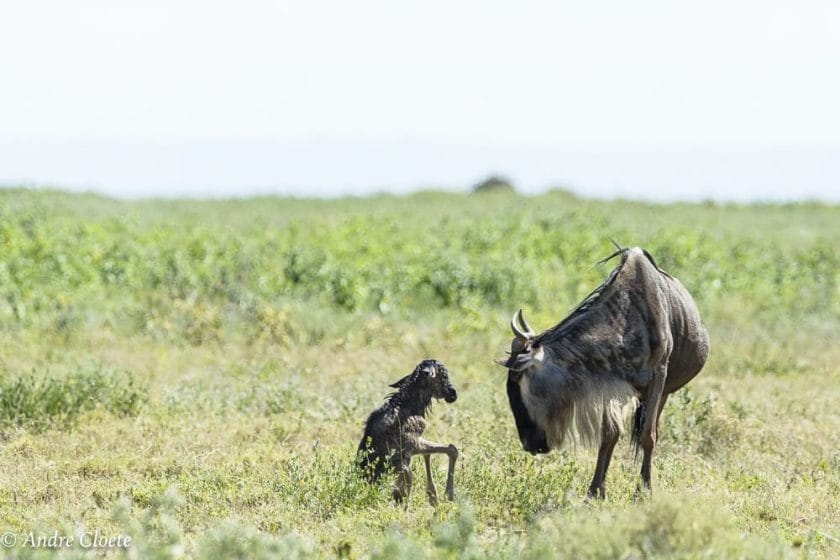
The Southern Serengeti is a seasonal region, as during the dry season, from May to October, when the plains are parched and there’s not much left to graze, most of the herds have left the area.
Because much of the Southern Serengeti lies outside the national park, lodges and camps permit off-road driving, which is not allowed in the rest of the park.
A safari in the Southern Serengeti is all about seeing the Great Migration in action on daily game drives, whether it’s baby wildebeest being born and taking their first steps on the lush green plains in the early months of the year, or watching the vast herds on the move as they track their course northwards towards the Masai Mara. The Southern Serengeti is one of the places where you can see the full circle of the Great Migration: the herds returning to graze in December with the start of the green season, the birth of the babies in January and February, and the departure of the herds as the grass starts to dry at the end of the rains.
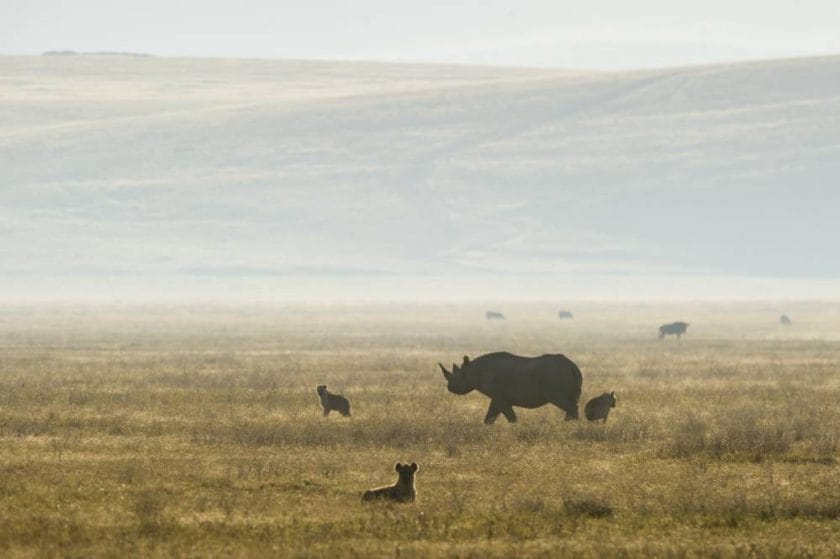
The Southern Serengeti is one of the few places in the Serengeti where you can do walking safaris. Exploring the bush on foot is one of the best ways of immersing yourself in the wilderness, and learning about the smaller creatures that you miss on game drives. And then there’s seeing large game on foot: truly thrilling encounters that make for an exceptional safari experience.
Hot air ballooning is offered in the Southern Serengeti, with a launch site located in the area. A gentle sunrise flight will give you incredible views over the vast plains, and a totally different kind of wildlife spotting. February is an excellent month to do a hot air balloon safari in the Southern Serengeti to see baby wildebeest being born on the savanna.
The Serengeti Cheetah Project, located in the Southern Serengeti, is monitoring cheetah numbers in the hopes of helping to conserve this very vulnerable species. Some camps in the area help the cheetah conservation by asking guests to collaborate in cheetah research by submitting photos and any details about the cheetahs they’ve spotted on game drives.
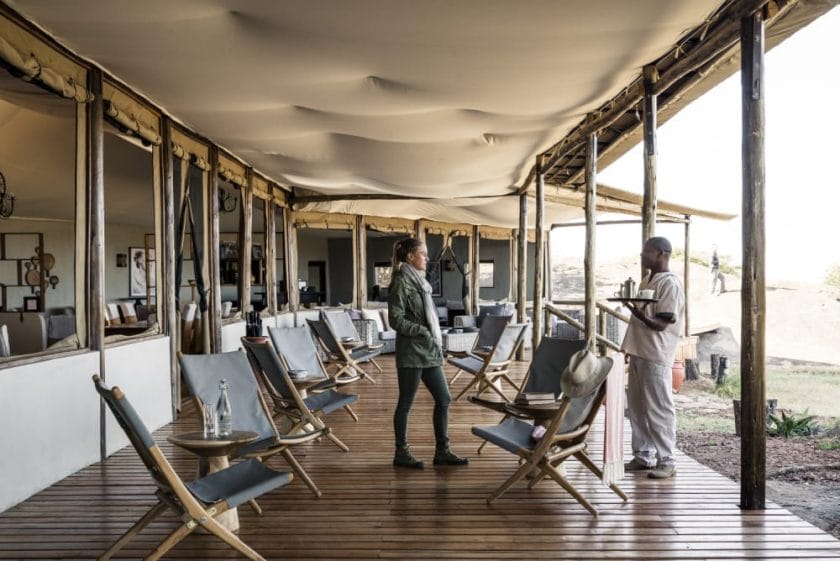
Due the seasonality of game viewing in the Southern Serengeti, there are only a few permanent lodges in the region, as well as one permanent tented camp. There are several mobile camps, ranging from affordable to luxury, that are open during the months of the Great Migration. Other options include lodges situated on private concessions bordering the Southern Serengeti.
Be sure to reserve far in advance for a trip to the Southern Serengeti during the Great Migration months of December to May, as the few lodging options get booked up.
The Southern Serengeti is an excellent area to base yourself in if you’d like to combine your Serengeti safari with a few days in the nearby Ngorongoro Conservation Area.
Stretching across to Lake Victoria, the Western Corridor (or West Serengeti) is a remote, little-visited area of the national park famed for the thrilling river crossings of the Grumeti River during the Great Migration between May and July. A huge valley bordered by hills that ends in Lake Victoria, the Western Corridor is made up of open savanna, woodlands, floodplains and riverine forest which are home to a great diversity of year-round wildlife, including elephant, giraffe, hippo, giant Nile crocodiles, rare Colobus monkeys and the localised kongoni antelope.
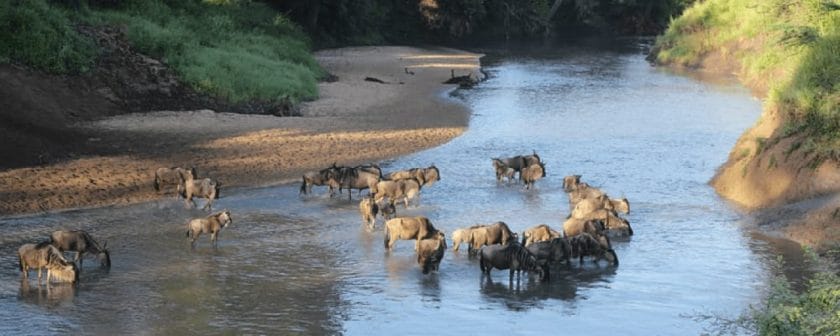
Flanking the Western Corridor is the unfenced Grumeti Game Reserve, a 138 000-hectare private concession which serves as a wildlife corridor for the animals making the migration between the Masai Mara and the Serengeti in June and July. The concession not only offers superb migration sightings with few other vehicles around but also lush, green landscapes of woodlands, rivers and rolling hills, as well as year-round leopard and lion populations.
Seeing the enormous herds of the Great Migration making crossings of the Grumeti in June and July is an excellent reason to visit this part of the Serengeti. While these river crossings are less well known than the Mara River crossings to the north – where the river is more dangerous, wider and has more viewing points – the Grumeti River, which is the first big obstacle for the herds to tackle, still offers some exciting sightings, with the added benefit of fewer tourists at the crossing points.
There are only a few places where you can do walking safaris in the Serengeti, which makes the walking safaris offered in the Grumeti Game Reserve particularly special. Spend hours on foot in the bush with a guide, not only tracking animals and learning about birds and insects, but also discovering fascinating medicinal and cultural uses for indigenous plants.
Visit a local Maasai community to see how people from the tribe live on the edges of the Grumeti Reserve. You’ll get to meet with subsistence farmers and their families and learn about what daily life is like – such as how villagers need to invent non-invasive ways to prevent elephants from trampling their crops.
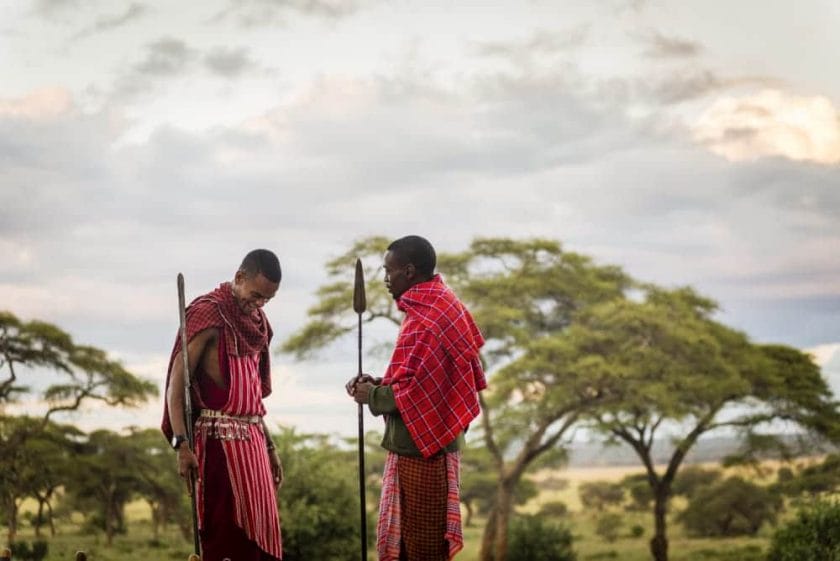
Hot air ballooning is offered seasonally (from the beginning of June to the end of August) in the Western Corridor. A magical sunrise flight in a gently gliding balloon is an unforgettable way to see the Serengeti’s spectacular landscapes and wildlife from a bird’s eye perspective.
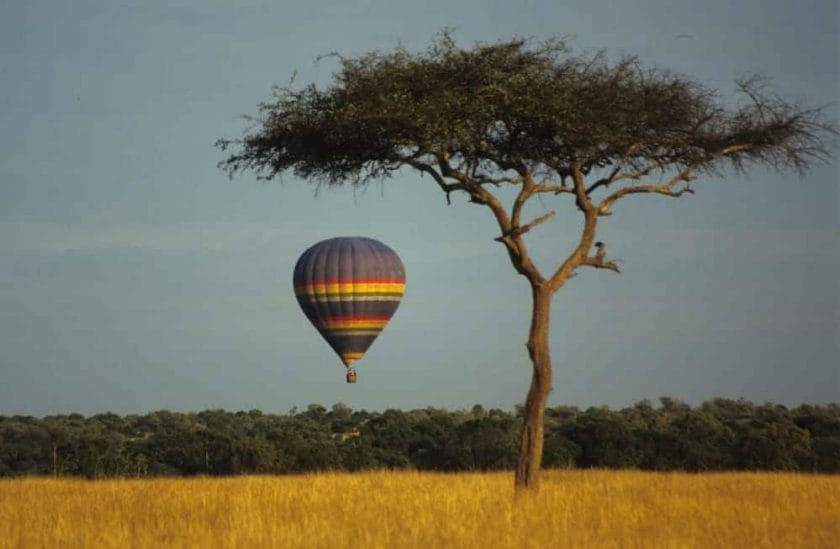
Budget travellers are best off staying in the Central Serengeti, as the Western Corridor and the Grumeti are more geared towards higher end travellers, however there is a campsite located at a lodge near the Ndabaka entrance gate, and a public campsite at the gate itself. Mid-range options in the sector include camps located just outside the park boundaries, while the region is most famous for its superb, intimate luxury lodges and mobile camps – some of which are completely exclusive.
June and July are the most popular times to visit the Western Corridor and the Grumeti to see the Grumeti River crossings and the herds on the move, but September and October are also great months to see the remaining herds of zebra and wildebeest, along with other resident wildlife such as elephant, leopard and lion. If you’re travelling during June and July, you’ll need to reserve lodging far in advance, as there aren’t many places to stay in the region.
Many people choose to fly into their lodge or camp’s private airstrip. Self-drivers hiring a car should pick up their vehicle and supplies from Mwanza, which is just over 130 kilometres from the Ndabaka Gate.
Travel with Confidence
With over 20 years of experience, our team will help you tailor your itinerary to your perfect adventure., 24/7 support, personalized, popular serengeti national park safaris, these recommended tours for serengeti national park can be tailor-made to match your budget..
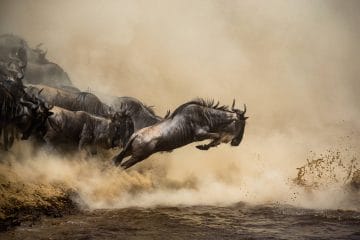
July/October Great Wildebeest Migration Safari
Tanzania Tarangire Ngorongoro Crater Serengeti
From $ 8240 /USD
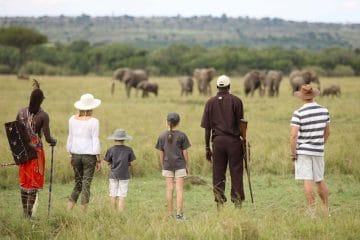
Walking Safari in the Serengeti
East Africa Tanzania Serengeti Lake Manyara
From $ 5850 /USD
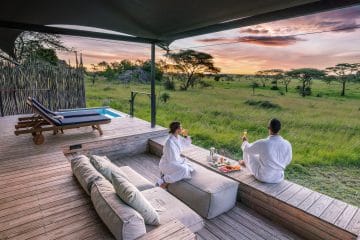
Honeymoon Safari in the Serengeti National Park
East Africa Tanzania Ngorongoro Crater Serengeti
From $ 6240 /USD
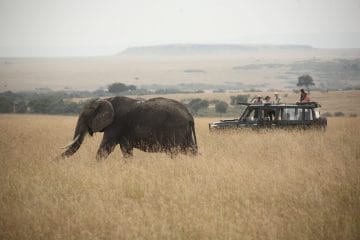
Kenya & Tanzania Safari
East Africa Kenya Chyulu Hills Maasai Mara Tanzania Tarangire
From $ 15600 /USD
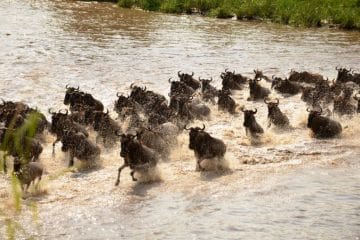
Migration Safari in Kenya and Tanzania With a F...
East Africa Kenya Maasai Mara Tanzania Serengeti Ngorongoro Crater
From $ 7250 /USD
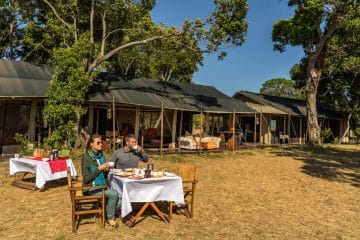
Ngorongoro Crater Game Viewing and Calving Safa...
East Africa Tanzania Arusha Ngorongoro Crater Serengeti
From $ 6790 /USD
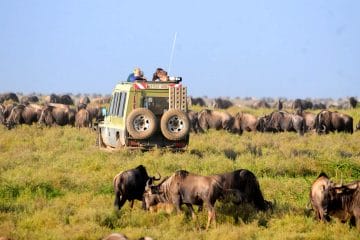
40 Serengeti Safaris to choose from
Stay for 4 - 17 days
Experience our Tailor-made Tours in Serengeti National Park
When is the best month to travel to serengeti national park.
- Serengeti in January
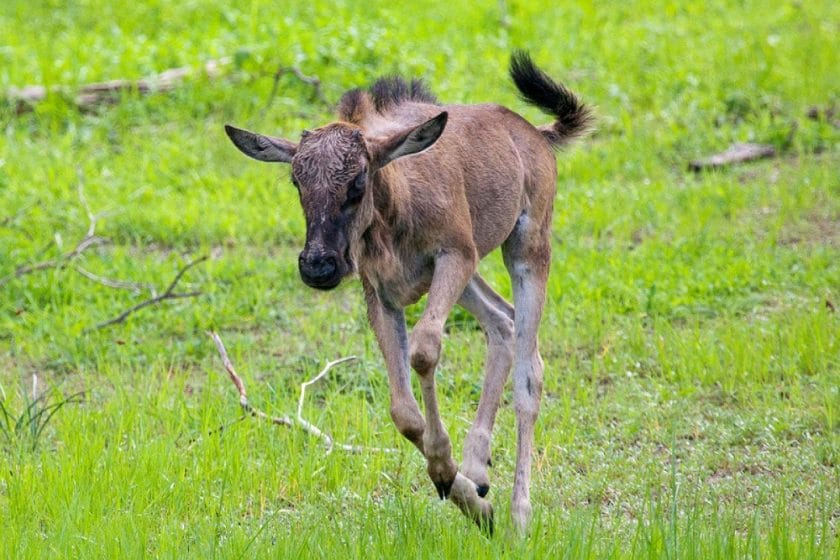
January falls during the green season, and receives an average of 14 days of rain in the month. It’s one of the warmest months of the year, with day time highs reaching 29C.
The Southern Serengeti and Ndutu Region are the best places to be in January, when the herds have congregated on the lush green plains to graze and to calve.
- Falling between the “long” and “short” rainy seasons, January sees lush, green, beautiful landscapes in the Serengeti, which make for amazing photos. However, the thicker vegetation makes game viewing more challenging.
- January is the start of the calving season in the southern Serengeti and Ndutu region, when thousands of baby wildebeest are born on the plains every day.
- Another bonus of travelling in January is the chance to see numerous migratory bird species in the park.
- Serengeti in February
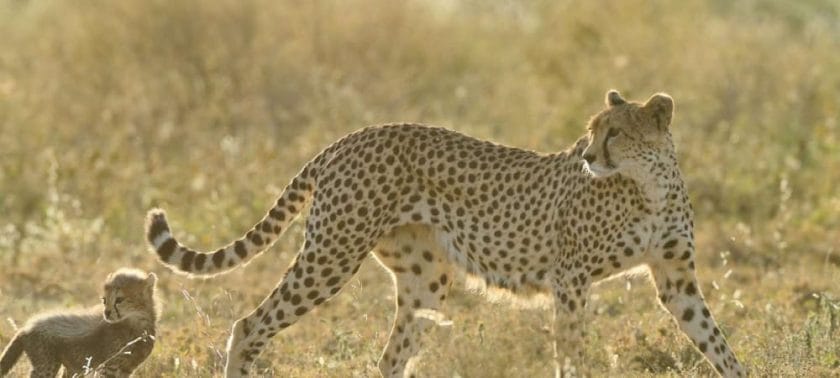
February has the same climate as January – warm days with highs of up to 29C, and some rain – an average of 14 days a month.
February is the best month to see wildebeest calving in the Ndutu Region and Southern Serengeti.
- February is peak wildebeest calving season, so if you want to see baby animals being born – as well as lots of predator action – then this is the month to travel.
- The landscapes are lush and verdant, although this does make seeing animals harder than in the dry season.
- February is one of the best months for birdwatchers in the Serengeti, as the migratory species are in the park.
- Serengeti in March
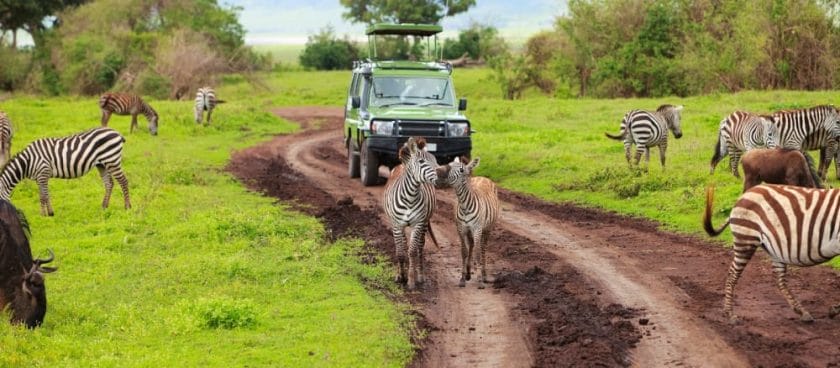
March is the start of the “long rains” season – the three wettest months of the year. It rains most days of the month, although it doesn’t usually rain for the entire day. Average day time highs are 29C, while nights go down to a cool 16C.
The Ndutu Region is the best region of the park to stay in March, when the wildebeest herds have their new calves, and there’s lots of predator action as the cats pick on the vulnerable baby animals.
March has lush, beautiful landscapes and great birdwatching, but the thick vegetation and rain can make game viewing more challenging. However, if you’re staying in the Ndutu Region, you will be able to see the massive herds of the Great Migration with their baby animals (and exciting scenes of predator kills).
- Serengeti in April
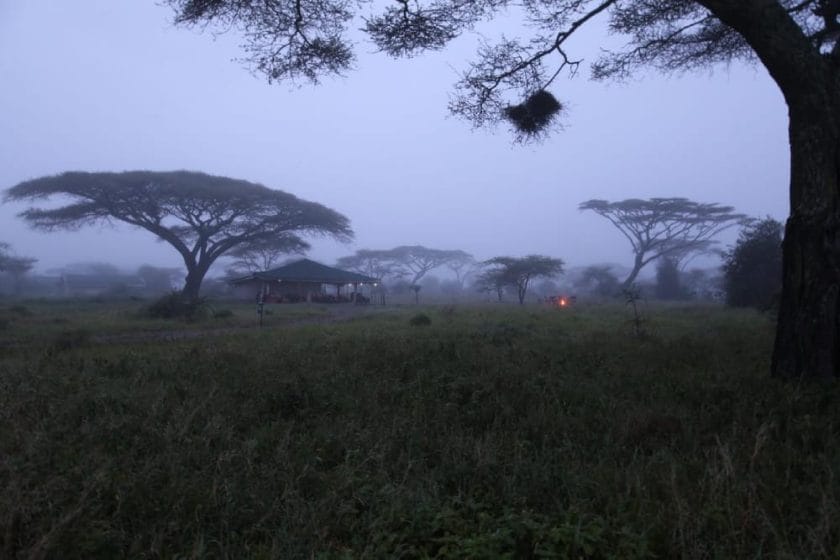
April is the wettest month of the year, and even though there’s rain almost every day of the month, it rarely rains all day. April is slightly cooler than March, but it’s still warm during the day, with average highs of 28C.
While calving season has ended, the herds of wildebeest are still in the Southern Serengeti and Ndutu Region, sustained by the lush grass on the plains. However, the herds have also started moving northwards, so you can catch them on the move in the Seronera/Central Serengeti region too.
Because of the amount of rainfall that April receives, it’s one of the least popular months to visit the park, which means that you can get discounted rates on lodging and packages. A plus is that the park is very quiet, so you’ll have sightings without any crowds.
- Serengeti in May
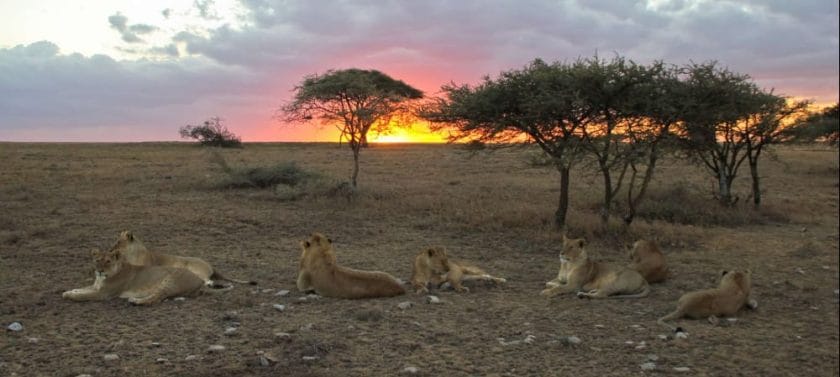
May is less rainy than April, but still one of the wettest months of the year, receiving an average of 18 days of showers in the month. It’s slightly cooler than April, with a maximum average of 27C during the day.
The Central Serengeti is the best region to base yourself in for the month of May, as the Great Migration herds are on the move through the heart of the park this month. Towards the end of the month, the herds have moved into the Western Corridor.
May is very quiet in the park, and it’s a good month to travel if you want to get discounted rates at lodges and camps. Game viewing is not its best this month because of the rain and the lush vegetation, but you can still see epic scenes of the herds on the move.
- Serengeti in June
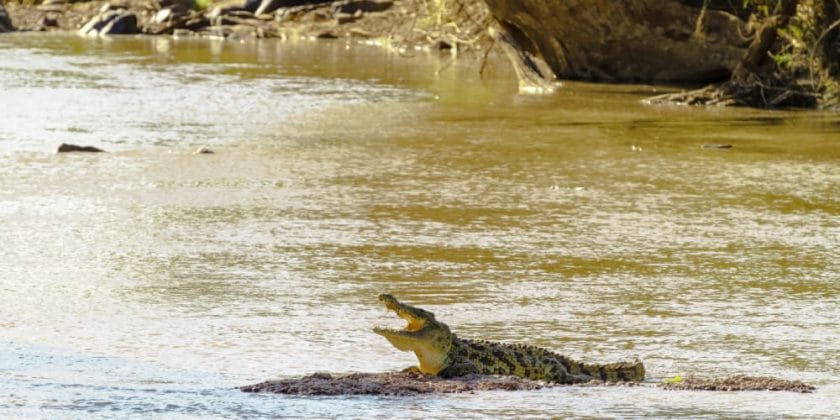
June marks the beginning of the dry season – the peak time to be in the park. There’s little rain, and temperatures range from 27C during the day to 15C at night.
In June, the herds move from the Western Corridor into the Grumeti (making the crossing of the Grumeti River) so either of these areas would be a good base.
Dry weather, lush landscapes, clear skies and the Great Migration herds’ crossings of the Grumeti River makes June a wonderful month to visit the Serengeti. Tourist numbers pick up this month after the low season of April and May, so the park is busier.
- Serengeti in July
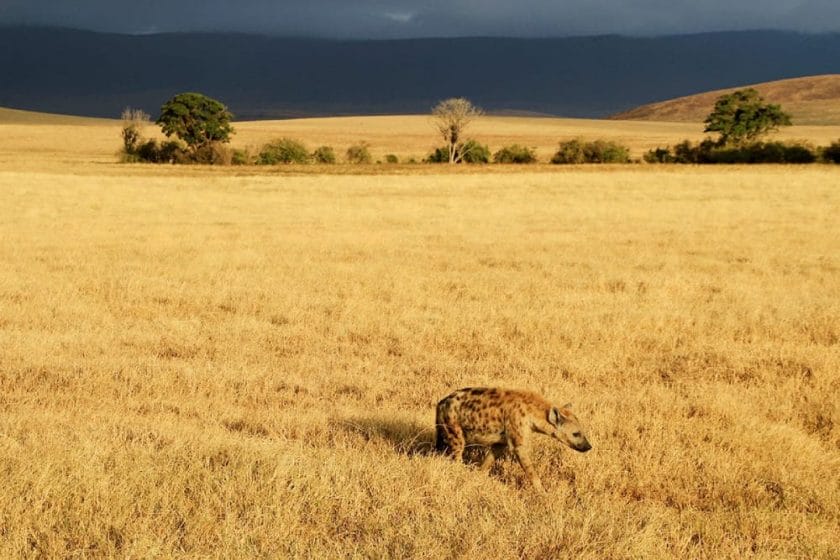
July is the driest month of the entire year, and also the coolest. While day time highs peak at 26C, night time averages are 14C – and can sometimes be even colder so be sure to pack warm clothing for the evenings and early morning game drives.
The Great Migration herds are continuing their move northwards, crossing the Grumeti River in the west of the park in the beginning of the month, and then starting to make the dramatic crossing of the Mara River in the Northern Serengeti towards the end of the month.
- River crossings are some of the most dramatic scenes of the Great Migration, and if you travel in July, you’ll be able to catch Grumeti River crossings, as well as the more dramatic Mara River crossings in the north of the park.
- The dry vegetation at this time of year makes wildlife spotting easy, and the weather is ideal. It’s one of the most popular months to visit the Serengeti, so parts of the park – especially the Seronera area – can be very busy.
- Serengeti in August
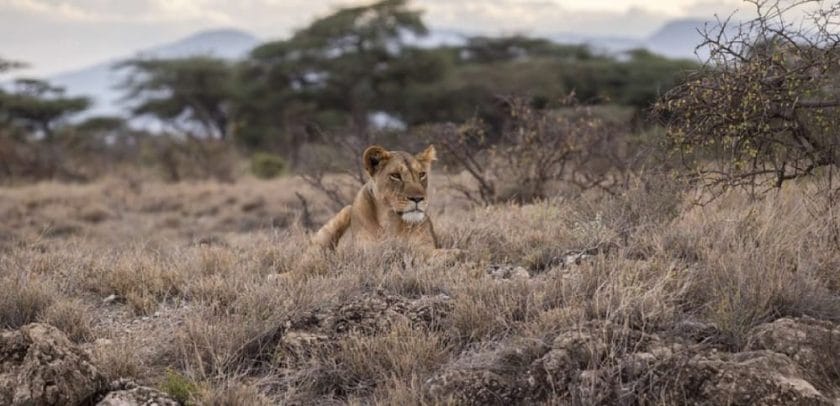
August is slightly warmer than July, and it’s also another dry month, with an average of only seven days of rain in the month.
Stay in the Northern Serengeti to see the thrilling scenes of thousands of animals making the crossing over the Mara River as they move across the border into Kenya’s Masai Mara National Park.
Mara River crossings are among the most dramatic moments of the Great Migration, and August is the best month to travel to the Serengeti for the chance of seeing river crossings. It’s one of the most popular months of the year for travel to the park, which means that river crossing viewing points can be very busy with other cars.
- Serengeti in September
September falls within the Serengeti’s dry season. It’s slightly warmer than August, with day time averages of 28C, but nights are still cool, falling down to 15C.
The Northern Serengeti is the best region to travel to in September to see the Great Migration herds crossing the Mara River into Kenya.
September offers the chance of exciting Mara River crossings in the Northern Serengeti, with fewer tourists than August. It’s also one of the best months of the year to see resident game in other areas of the park.
- Serengeti in October
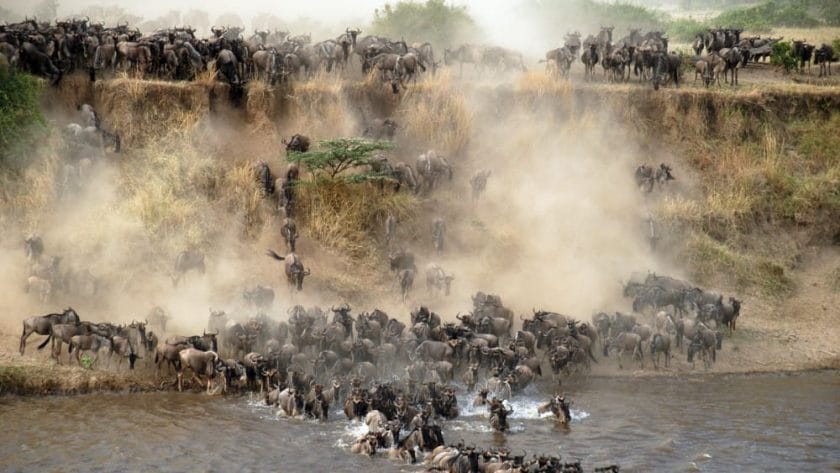
October marks the end of the dry season, and the “short rains” can sometimes start this month. It’s one of the warmer months of the year, with day time highs averaging at 29C.
Some of the Great Migration herds are still in the Northern Serengeti (and still making Mara River crossings), but sometimes this month (depending on when the rains start), the herds start to move back down into the Serengeti from the Masai Mara this month, passing through the Loliondo Game Controlled Area (a concession outside of the park’s northern section).
- Depending on when the rains start in October, the herds of the Great Migration will start to make their way from the Masai Mara back down south into the Serengeti, however the exact timing of this movement is unpredictable. There is a chance that you can still catch the last of the river crossings in the Northern Serengeti this month.
- Falling at the end of the dry season, October’s very dry and thin vegetation means that this is an excellent month for seeing resident game.
- Serengeti in November
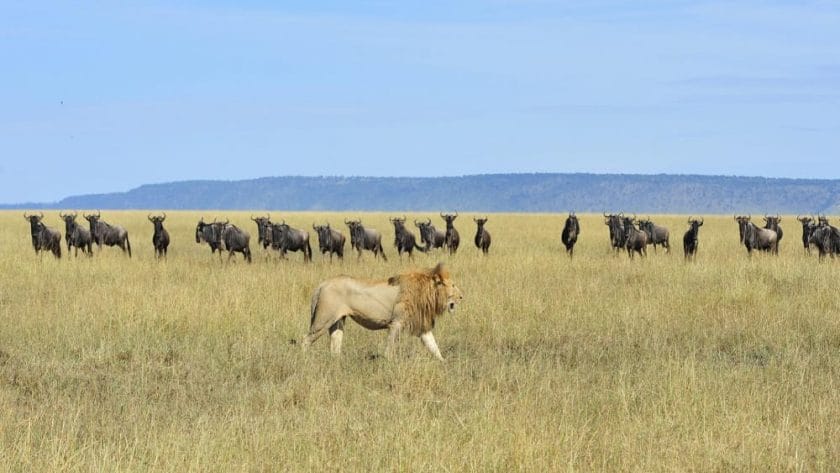
The short rains usually begin this month, bringing fresh green grass to the plains. November is one of the rainiest months of the year, receiving an average of 17 days of rain in the month.
There may still be some animals crossing the Mara River in the Northern Serengeti at the start of the month. However, to see the big herd movements, stay in the Seronera Valley in the Central Serengeti, where the animals are on the move en masse towards the fresh grass in the south of the park.
While November is a rainy month, it usually only rains in the afternoons, so you will still have superb game viewing opportunities. It’s a quieter month, so some lodges offer low season rates. November is a great time to travel to the Serengeti if you want to see the full spectacle of the Great Migration herds on the move.
- Serengeti in December

December falls during the “short rains” period in the Serengeti, and receives just a bit less rain on average than November. Day time highs are 28C and nights go down to 16C.
At the start of the month, the Great Migration herds are in the Seronera region of the Central Serengeti, while towards the end of the month they are concentrated in the Southern Serengeti and Ndutu Region.
December is a good month to catch the herds on the move from the Central to Southern Serengeti. Depending on the rains, the calving season may also begin towards the end of the month. While December falls during one of the rainy seasons in the Serengeti, the afternoon thundershowers usually clear up quickly, so they don’t tend to cause much disruption to a safari. The rains have turned the plains of the Serengeti lush and green, and the skies are dust free, which makes for great photos.
Our Recommended Tours in Serengeti National Park
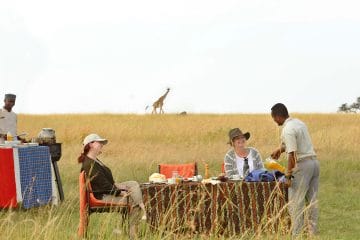
Migration Serengeti Safari Short and Sweet
East Africa Tanzania Arusha Serengeti
From $ 4990 /USD
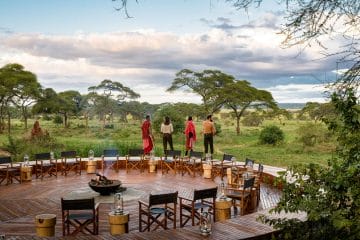
Witness the Great Migration from June to Octobe...
Tanzania Arusha Tarangire Lake Manyara Ngorongoro Crater Serengeti
From $ 10600 /USD
Looking for Something Unique?
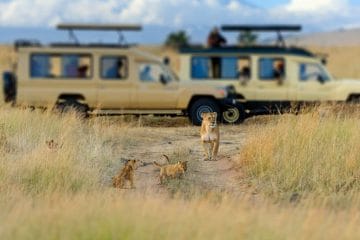
Big Cat Safaris
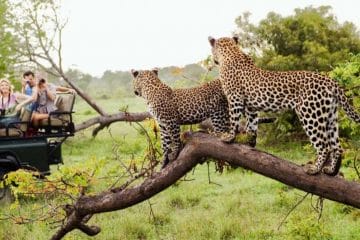
Why travel with us?
Recent reviews from travellers who planned and booked their africa trips with discover africa safaris, superstar lana.
8 Day Timbavati & Kapama Safari Review
Leah, Australia 12 Oct 2023
Trip of a lifetime.
15 Day Kenya & Tanzania Safari Review
George and Tara, United States 01 Oct 2023
Two peak challenge.
13 Day Climbing Mount Meru & Mount Kilimanjaro Review
Kevin, United Kingdom 20 Mar 2023
Great knowledge, experience and insight combined to make a great safari.
Botswana & Zimbabwe Review
Alan , United Kingdom 08 Aug 2022
Going above & beyond, discover africa created our trip of a lifetime..
South Africa Trip Review
Jim Blachman , United States 03 Jul 2022
Hassle free and very professional service from start to finish..
Motswari Game Reserve & Cape Town Tour Review
Debbie, Australia 16 Mar 2020
Ready to plan your tailor-made safari.

Vihann Van Wyk, Safari Travel Planner
Free safari planning advice from destination experts
Faqs about serengeti.
- Safari lodges have guest rooms similar to a hotel with en-suite bathrooms. They are comfortably furnished with facilities normally associated with a hotel rooms, except your rooms are normally set in beautiful wilderness settings, with nature and wildlife around.
- Tented lodges have rooms which are tents on a platform and with a roof and also have en-suite facilities with showers, flush toilets and hot water. Basically all the amenities of a hotel room, except canvas walls and roof.
- The boutique lodges and camps can be very stylish and smart in terms of design and decor, often with very spacious rooms and even going so far in some cases as having plunge pools for each room.
- Eco-camps and smaller tented camps have insect-proof tents with en-suite facilities including a safari shower and flush toilet. They give a more authentic safari experience but the tents are comfortably furnished with proper beds and you don’t need to bring your own sleeping bag! The emphasis is usually on having excellent guides and great wildlife viewing away from the crowds. Guests often eat together and people travelling alone usually say that they found the atmosphere friendly and enjoyed meeting other like-minded travellers around the campfire in the evening or at dinner.
- The Adventure Camps are a budget option with guests bringing their own sleeping bags and towels. Accommodation is in small dome tented with a mattress on the floor. Each tent has its own nearby cubicle with a flush toilet, safari shower, and wash basin. The Adventure Camps are suitable only for those who don’t mind “real camping” and can put with some degree of “roughing it”. Apart from the accommodation in simple dome tents, the meals and the guiding are the same standards as the higher quality camps and game drives are in 4x4 safari vehicles. For those on a limited budget, the Adventure Camps are a good alternative to the big tourist lodges and minibus tours for those for whom the safari experience is more important than hotel accommodation.
- A Grumeti safari is rewarding throughout the year. However, the best time to visit Grumeti Game Reserve is during the migration months of June and July - when massive herds of wildebeest arrive to cross the crocodile-infested Grumeti River on their way back to Kenya’s Masai Mara.
- For many, the post-migration months of September and October are seen as the best time to visit the Grumeti Reserves - large herds of zebra and wildebeest remain in the area along with elephant, topi and Thomson’s gazelle. However, it's also easy to spot predators moving through the short grass.
- If the weather causes unforeseen problems on the day of your hot air balloon safari, we will try to move it to another day or you will be refunded.
See Serengeti in Your Comfort
- Affordable Safari in the Serengeti
- Budget Serengeti Safari
- Luxury Serengeti Safari
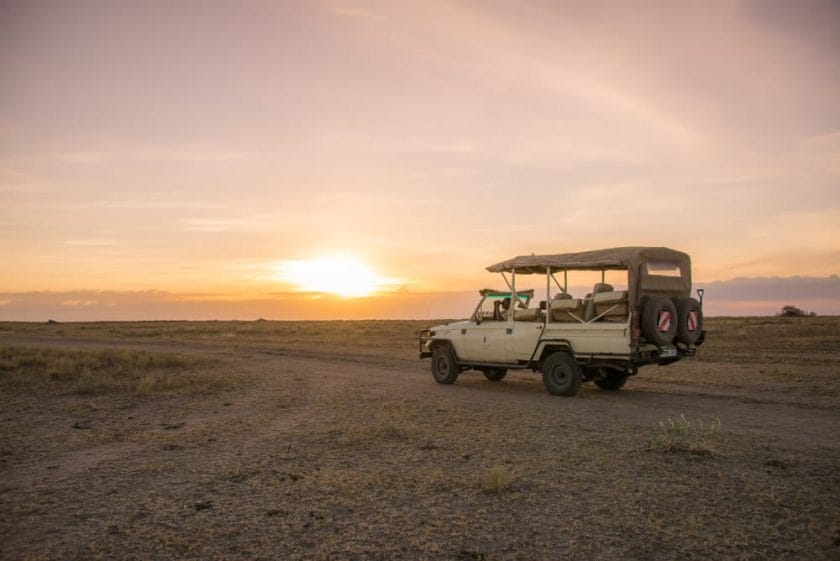
The most affordable way to visit the Serengeti is to book a holiday package which includes transport from Arusha, lodging, meals, park fees, as well as game drives and other activities at the safari lodge. You can also hire your own 4×4 and self-drive in the park, although you can often get better value for money with packages.
While the Serengeti has a concentration of exclusive and luxury camps and lodges, there’s a good choice of mid-range lodging options both inside the park and outside the park gates. The benefit of staying outside of the park boundaries is that you don’t pay park fees for your days of travel to and from the Serengeti, and there are activities on offer – such as night drives – that aren’t permitted in the park.
For discounted rates on lodges and on safari tours, book your trip during the rainiest months of April and May, which are the least popular months to visit the Serengeti. While you’ll have heavy rains, the wildlife viewing is still good, and you’ll get better value for money, as well as fewer other tourists in the park.
While most lodging options in the park cater to high-end travellers, and park fees are pricey (US$60 per person per day), there are a few options available to budget travellers. The most affordable way to do a safari in the Serengeti is to join an overland tour, which will include transport, a guide, the cost of camping, food and park fees.
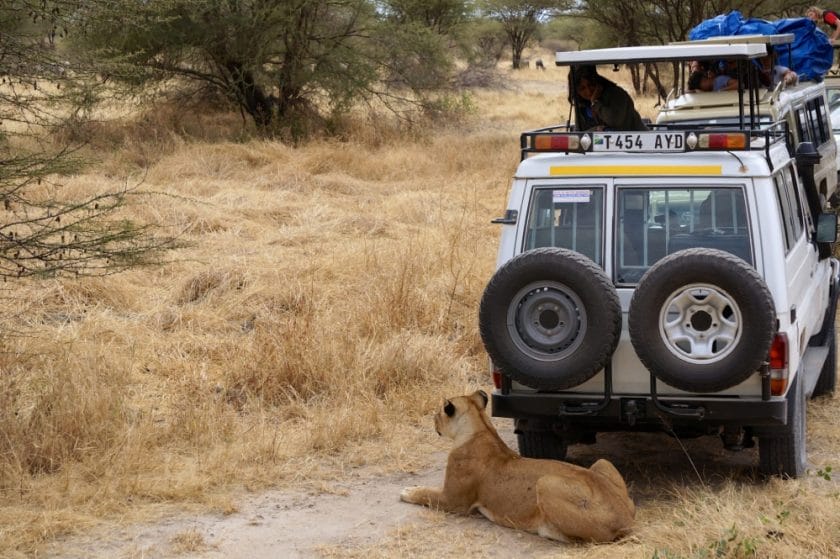
Self-guided independent travellers will need a car to explore the park: you can hire a 4×4 from Arusha or Mwanza, as well as camping equipment, and stay at one of the campsites outside the park gates or at one of the nine public campsites inside the Serengeti: there are six in the Seronera area in the heart of the park, one at Lobo, one at the Fort Ikoma Gate and one at Ndabaka Gate (you can book and pay for these campsites when you enter the park gates). There are also special campsites which you’ll be able to use exclusively for your group. These you’ll need to book in advance through a tour operator or through the Tanzania National Parks Authority. You’ll need to be entirely self-sufficient if you’re camping, so stock up on provisions in either Arusha or Mwanza before you enter the park and bring your own firewood. Many travellers prefer not to drive themselves on the Serengeti’s challenging roads, and instead hire a driver although this will cost a lot more than driving yourself.
The alternative to staying inside the park is to book an affordably priced lodge on the outskirts of the park where your meals and game drives are included in the rate, and spend some time on game drives outside of the park, so you don’t have pay park entrance fees for every day that you’re in the bush.
Travel during the rainy season from January to March, when the Serengeti is at its wettest, to get discounts on lodge rates and safari packages for the best budget deals.
The Serengeti has much to offer high-end travellers, with a wealth of luxury lodges and tented camps scattered across the reserve and on its outskirts. Permanent lodges – which can be small or have dozens of rooms – have the full range of amenities, from tennis courts and gyms to spas and swimming pools where you can watch wildlife drink from water holes while you cool off. Tented camps, which give you a taste of sleeping under canvas without sacrificing any comforts (think king-sized beds, ensuite bathrooms, antique furniture and butler service). Then there are minimal-footprint seasonal bush camps which are only open during the months of the year when the migration is passing through the area, and exclusive, intimate mobile camps, which move a few times during the year with the movement of migrating herds. Mobile camps are an excellent choice for a Serengeti safari, as they get you close to the action in remote, untouched areas, and you get an experience of being immersed in the bush – but this is a long way away from rustic camping. Luxury mobile camps come with hot bucket showers, flush toilets, private butler service and gourmet cuisine served in dining tents, and some offer private and exclusive game drive vehicles and guides for each part of guests.
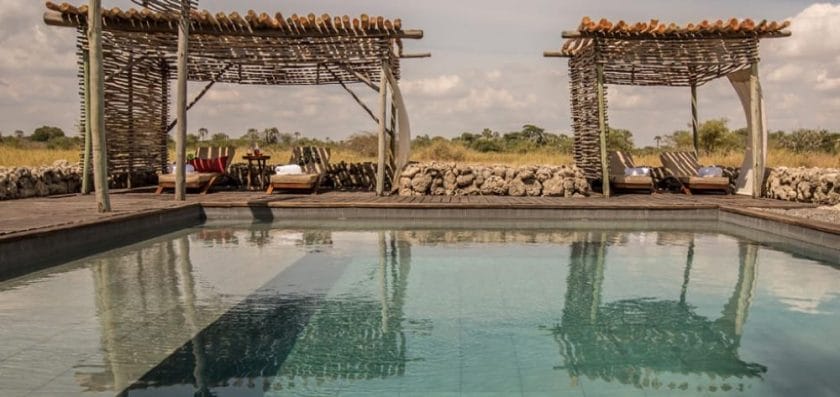
Picking your lodge or camp is a question of when in the year you’re travelling, as the park is vast and there are different attractions in each region at different times of the year. If your priority is seeing the Great Migration, then you’ll need to book a lodge that closest to the action in the month you’re travelling.
You can hire a car, a driver and a private guide from Mwanza or Arusha and travel to the park on your own, or, the much easier and more hassle-free option is to do a fly-in safari, taking a small plane from Arusha to one of the many airstrips located across the Serengeti. Some lodges have their own private airstrips, and a vehicle will be waiting to collect you when you arrive – so your first game drive will be the journey to your lodge. You can also hire a car and a driver and still do a fly-in safari: the driver will travel from Arusha and meet you at the airstrip in the park.
Who is Travelling to Serengeti with you?
- Serengeti Family Safari
- Serengeti Honeymoon
- Solo Travel in the Serengeti
Having the perfect family holiday in the Serengeti is all about picking the right lodges: while some don’t allow children under the age of 12, others are particularly family-friendly, offering a host of fun kids’ activities such as learning to use a bow and arrow, getting cooking lessons, roasting marshmallows over the campfire. And then there are some camps and lodges allow children under the age of 10 to sleep and eat for free. When choosing your lodge there are a few things to take into consideration, such as picking a place that has a swimming pool so that your kids have something to do during the long hot afternoons in between safari activities.
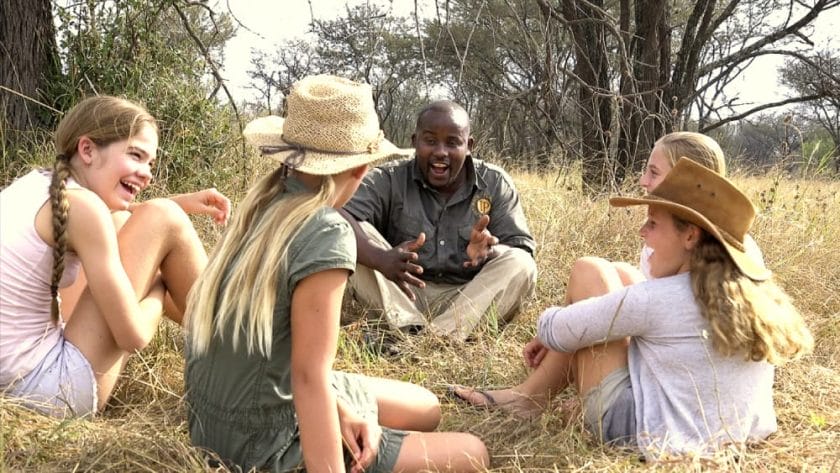
There are family-friendly lodges, camps and mobile camps in all the different regions of the Serengeti, but the wealth of lodging options lies in the Seronera region of the Central Serengeti. If you’re looking to get more off the beaten track, then try the Western Corridor and the Grumeti Game Reserve, or the Eastern Serengeti, while staying in the Northern Serengeti during the months of the Great Migration gives you the chance to catch the exciting and dramatic crossings of the Mara River – thrilling scenes that will keep the kids on the edge of their seats.
In terms of safety, be aware that lodges and camps are unfenced in the Serengeti and you’ll need to keep careful watch over your children, as wild animals can enter the camp at any time. Children should not be allowed to walk around camps on their own. An alternative is to stay at a lodge outside of the park, where children will have more freedom to run around.
While you can fly into the park and get transfers to and from your lodge (and many lodge stays include twice daily game drives), you can also hire a car and a driver for your family, as this gives you more freedom to run on your own schedule and do shorter game drives if you have small children who get restless in the car on long drives.
The Serengeti is the ultimate romantic safari destination: a magical combination of breathtaking landscapes, superb wildlife viewing and the drama of Great Migration sightings, as well as truly memorable luxury lodges and camps situated in remote reaches of the wilderness make for a very special holiday.
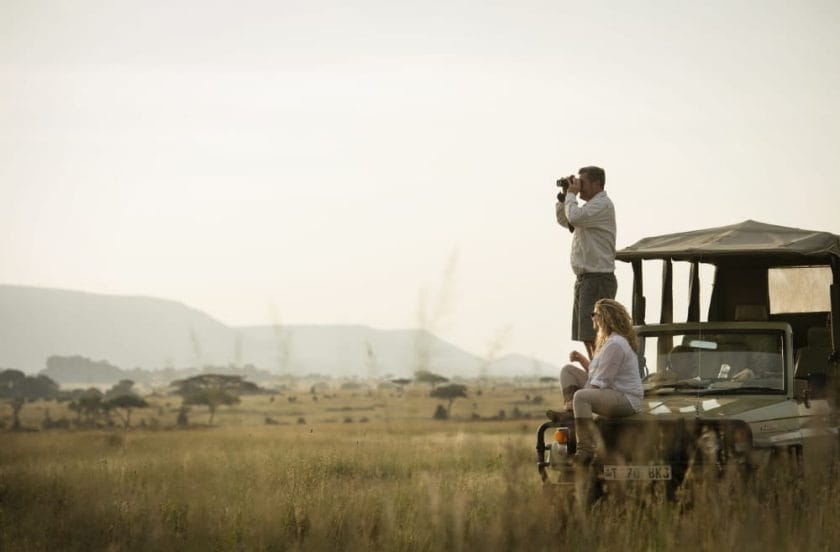
Choosing which region to stay in the Serengeti on your romantic holiday is all about what time of year you’re travelling, as wildlife movements are seasonal and many lodges and camps are only open for certain months of the year. Every region of the park has superb upmarket lodges and camps that cater for romantic safaris – and each region has its benefits, depending on what kind of experience you’re looking for. The Central Serengeti has the biggest array of choices, with the Seronera region in particular boasting the largest concentration of places to stay. For exclusivity, stay at one of the lodges or camps in the Grumeti Game Reserve in the western Serengeti. If you really want to get off the beaten track, stay at one of the few camps in the Soit Le Motonyi region at the far east of the park, which was closed for two decades and only re-opened a few years ago.
Choose to stay in a permanent lodge, which will have a wide range of facilities such as gym, swimming pools and spas, or stay in a more intimate tented permanent camp where rooms may be under canvas but feature king-sized beds, stylish antique furniture and spacious ensuite bathrooms. On the other hand, mobile tented camps are a wonderful choice if you want the feeling of really being in the wild: you can experience giant herds of wildebeest grazing just metres away from your tent. There’s no electricity or running water (although you can expect hot bucket showers) but luxury mobile camps are far from rustic: think large, beautifully decorated tents with ensuite bathrooms and outdoor seating, communal lounge and library areas and gourmet meals.
Many lodges offer special romance or honeymoon packages that include activities such as bush picnics for two, couples’ massages, private sundowners and exclusive candlelit dinners in the bush or on your private deck. For the ultimate romantic safari, book a private safari vehicle through your lodge, so that you’ll be able to go on game drives where it’s just you, the driver and your guide.
The beauty of solo travel in the Serengeti is having the option to be with other travellers, or to enjoy this vast wilderness on your own private game drives.
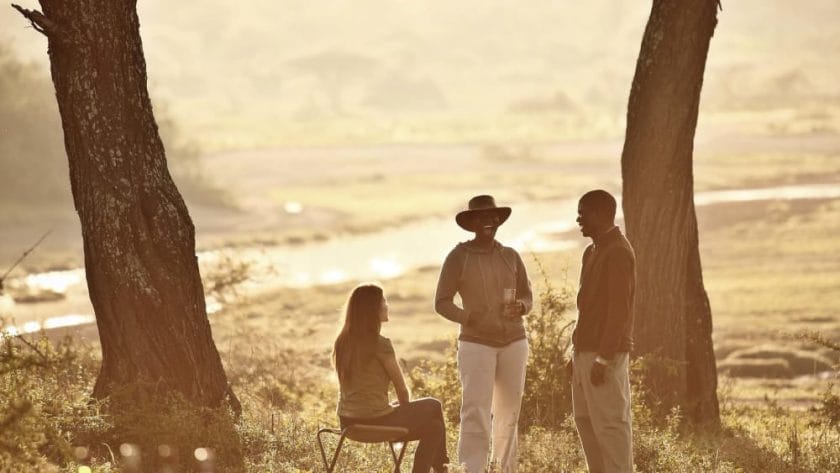
The best option for solo travellers to the Serengeti in terms of getting to meet other travellers and have a value-for-money trip, is to join a safari tour – an all-inclusive package holiday that covers transport, a guide, lodging, park fees, activities and meals. It’s a hassle-free way to travel, and you’ll have the safety and security of travelling in a group.
Independent travellers can hire a car and a drive from Arusha and Mwanza and stay in a camp inside the park, joining up with fellow travellers on game drives from your lodge or camp, or travelling in their own vehicle. Another option is booking a stay at one of the many all-inclusive lodges across the park’s regions, and doing a fly-in safari: take a small charter plane to the closest airstrip servicing your lodge, and start your first game drive as you’re picked up from the runway in the lodge’s safari vehicle. Many lodges include twice daily game drives as part of an all-inclusive package, as well as other activities such as nature walks and Maasai cultural visits where you’ll be able to join other guests.
What You Need To Know
- Welcome to the Serengeti
- Why Go to the Serengeti?
- Wildlife in the Serengeti
- Why Return to the Serengeti?
Tanzania’s Serengeti National Park is the safari destination that most people dream of. This massive wilderness area, which stretches across 14750 square kilometres, offers one of the continent’s best wildlife viewing experiences, as well as classic East African scenery of vast savanna (Serengeti means “endless plains” in the local Maasai language), and the dramatic spectacle of the most spectacular animal movement on the planet – the Great Migration.
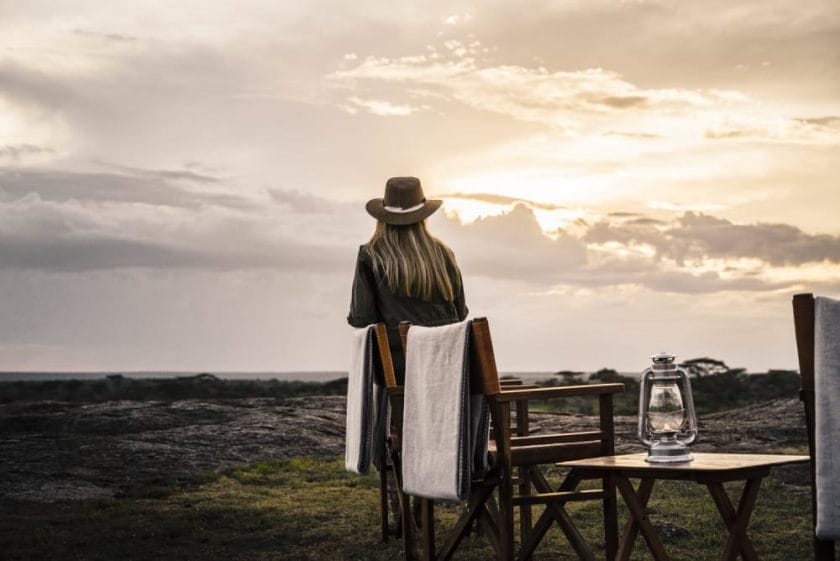
Game viewing is superb year-round in the Serengeti: the park is home to the Big Five (although rhinos are rarely seen), and is particularly renowned for its predators – leopard, cheetah, lion and hyena – which are regularly spotted. The Serengeti also plays host to the phenomenal Great Migration, which sees millions of wildebeest, zebra and gazelle traversing the open plains of the park in search of fresh grass from seasonal rains, moving northwards into the neighbouring Masai Mara National Reserve in Kenya, and then returning south to the Serengeti again. The dramatic scenes of huge herds on the move, crossing rivers and vast plains and pursued by predators looking for their next kill, are the stuff nature documentaries are made of. Experiencing the Great Migration is definitely a once-in-a-lifetime event that most safari travellers have at the top of their bucket list.
Apart from thrilling game drives, there are plenty of other activities to enjoy during your safari in the Serengeti, including sunrise hot air balloon rides over the plains, newly-introduced walking safaris in some sections of the park, visits to Olduvai Gorge – the most important paleoanthropological site in the world – Maasai cultural experiences, birdwatching, and making a filmic pilgrimage to see the rocky outcrop that inspired Pride Rock in The Lion King.
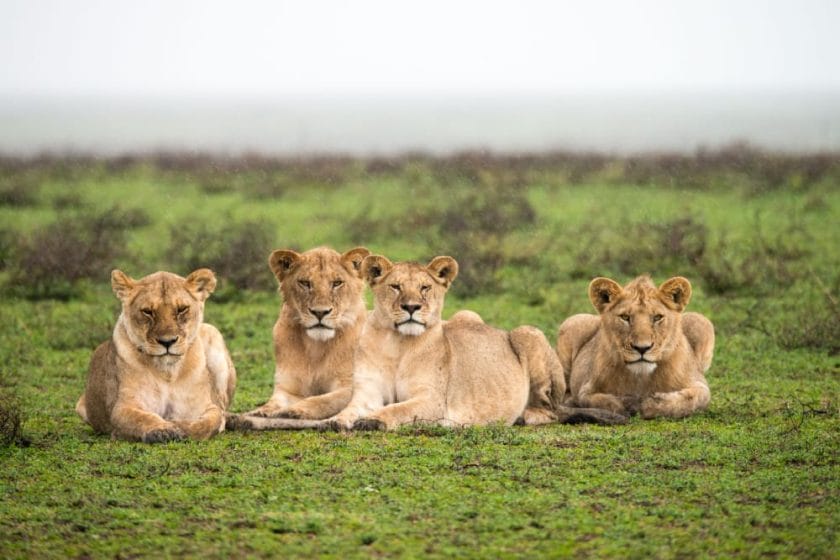
Given the massive size of the reserve, picking where to go in the Serengeti takes a bit of planning. Different parts of the park have different attractions throughout the year, and choosing a region or lodge really depends on what you’d like to experience and when you’re planning on travelling. Each of the Serengeti’s major regions (Central, Northern, Eastern, Southern and the Western Corridor and Grumeti) have varied wildlife attractions, so researching what the different areas have to offer at what time of year will pay off in terms of giving you the best safari experience. There’s also the opportunity of staying on the unfenced private concessions just outside the park boundaries, which offer the landscapes and wildlife of the Serengeti but also extra activities, such as night drives and walking safaris, that are not permitted within the park.
The Great Migration is the most dramatic wildlife spectacle on the planet and there’s only two places in the world where it takes place: the Masai Mara in Kenya and the Serengeti National Park in Tanzania. Every year millions of wildebeest, zebra and gazelle make their way from the Ndutu region in the south of the Serengeti, across perilous river crossings and huge expanses of grassy plains, to reach fresh green grass that comes with seasonal rains as they move northwards. For many months of the year, the vast herds can be seen in different parts of the Serengeti: calving at the start of the year, river crossings in the middle of the year, and the return journey from the Masai Mara at year’s end.
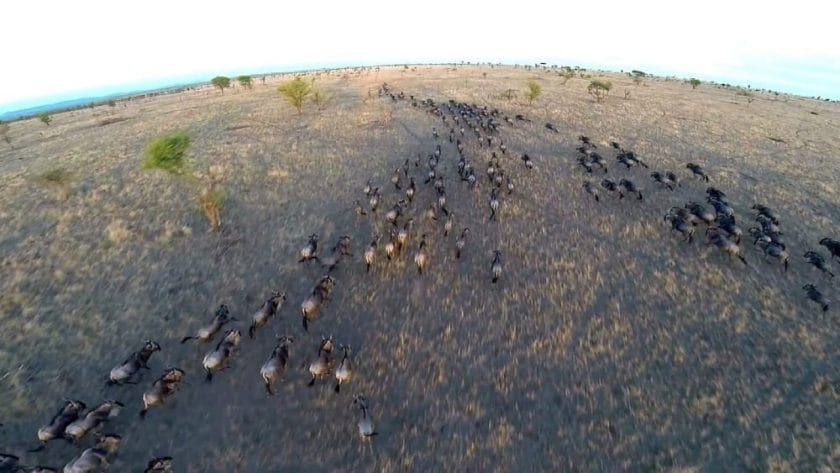
Apart from the drama of the Great Migration, the sheer vastness of the Serengeti makes it stand out from other wilderness areas. Named as one of the Seven Wonders of Africa, the Serengeti is makes up one of the most important ecosystems on the planet, supporting and abundance and diversity of animals and birdlife that is hard to match anywhere else. The national park, which is a designated UNESCO World Heritage Site, is also home to the highest concentration of large predators in the world.
One of the greatest wilderness areas in the world, the Serengeti supports a magnificent diversity and abundance of animals, from the Big Five – lion, leopard, elephant, buffalo and black rhino (although these are rarely spotted) – to giraffe, Grant’s gazelle, impala, kongoni, topi and eland.
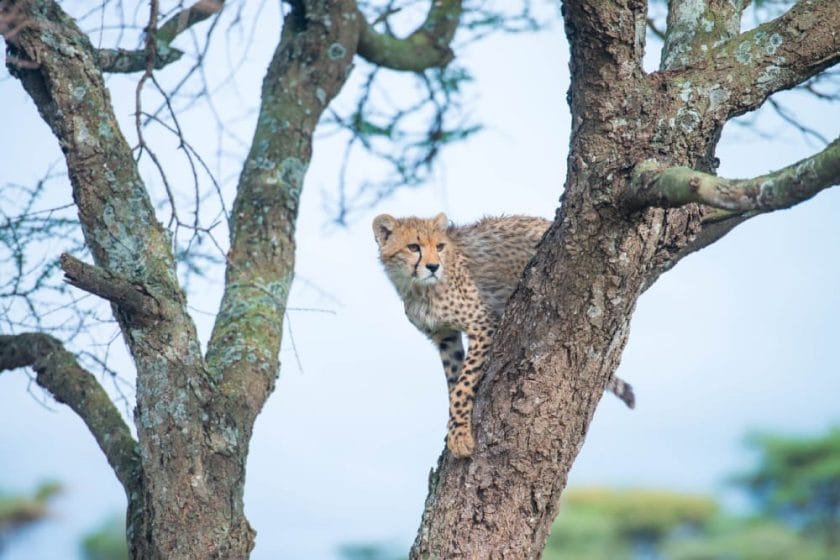
The Serengeti is famous for its predators: you can expect excellent lion and cheetah sightings (and exciting lion kills), and leopards are also regularly spotted. Other predators include serval cats, golden and black-backed jackal, African wild dog and spotted hyenas.
The Great Migration is the stellar highlight of the Serengeti’s wildlife: an annual circular movement of millions of wildebeest, zebra and gazelle northwards into the neighbouring Masai Mara National Reserve in Kenya and back into the plains of Serengeti. This mass movement of animals is accompanied by predators picking off their kills, while the dangerous crossings of the mighty Mara River make for dramatic scenes of struggle and survival as animals battle strong currents and attacks by huge Nile crocodiles.

For birders, there are more than 500 species in the park, including a few Tanzanian endemic species, such as Fischer’s lovebird, grey-breasted spurfowl and rufous-tailed weaver. Other birding highlights include kori bustard, secretary bird, usambiro barbet, yellow-throated sandgrouse, grey-crested helmet shrike, and Hildebrant’s starling.
The Serengeti is so vast that you could never even think of seeing it all on one trip. Each region offers different landscapes and wildlife highlights, as well as varied lodging and activity options. Return visits would definitely make the most of the park’s diversity.
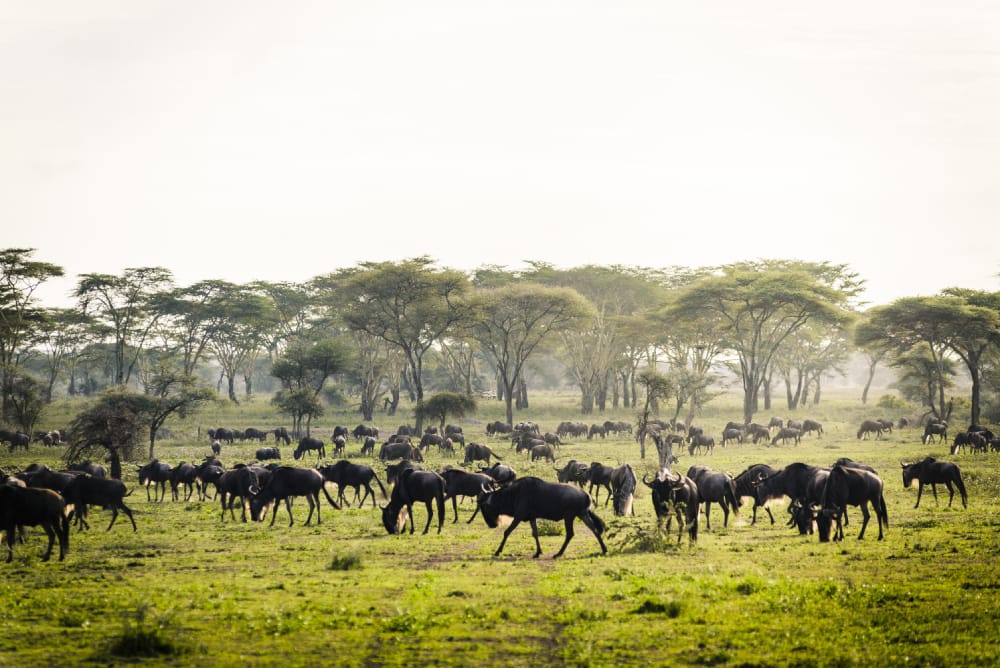
There’s also a lot of seasonality to the park and its wildlife, and different regions of the park have different things going on at varying times of the year. It would definitely be worth visiting in the peak months of the Great Migration, to witness this incredible wildlife spectacle – the vast herds, lion kills and river crossings – and then returning to the park at a quieter (but no less exciting) time of year, such as for wildebeest calving in the south of the park in January and February.
With the varied lodging options, return visits would allow you to experience the breadth of what’s on offer, from permanent lodges to mobile tented camps, as well as multi-day walking safaris where you stay in small camps each night.
- Why Serengeti National Park
Registered Members of these Organizations

USEFUL LINKS
- Safari Tours
- Accommodation
- Why Book with us?
- Safari Cost Estimator Tool
- Wildebeest Migration
- Privacy Policy
- Website Terms of Use
POPULAR COUNTRIES
- View All Countries
POPULAR DESTINATIONS
- View All Destinations
- Cape Town Holidays
- Kruger National Park
- Etosha National Park
- Chobe National Park
TRAVEL BLOGS
- Transformative Journeys: From South Africa’s Red Desert to Antarctica’s Crystal Glaciers
- Travel News Digest, 10 May: Airlines Warned to Cease Greenwashing, Free Wi-Fi at Victoria Falls
- How to Plan a Gorilla Trekking Safari in Rwanda
- AI Trip Planning Tools Making Travel Easier
- Travel News Digest, 3 May: Flooding in the Maasai Mara, Turtles Rescued in Cape Town
OUR LOCATION
2nd floor, Tygervalley Chambers One, 27 Willie van Schoor Avenue, Bellville, Cape Town , 7530
Your Sanctuary in the Savannah
Accommodations, the private villa experience, terrace suite, horizon room waterhole view, savannah room, two-bedroom villa, featured offers.
Stay Longer – Fourth Night Free
Extend your safari with a complimentary fourth night.
Essential Serengeti with Daily Game Drives
Maximize your chance of thrilling animal sightings with daily game drives.
Adventure and Rejuvenation
For the ultimate safari retreat, we've combined the thrill of animal sightings with a tailor-made wellness program.
The Big Five Family Safari Package
With endless activities for children, capture magical family moments during an unforgettable safari adventure.
Serengeti by Four Seasons
Soar above the serengeti.

Connected Souls Photo Safaris
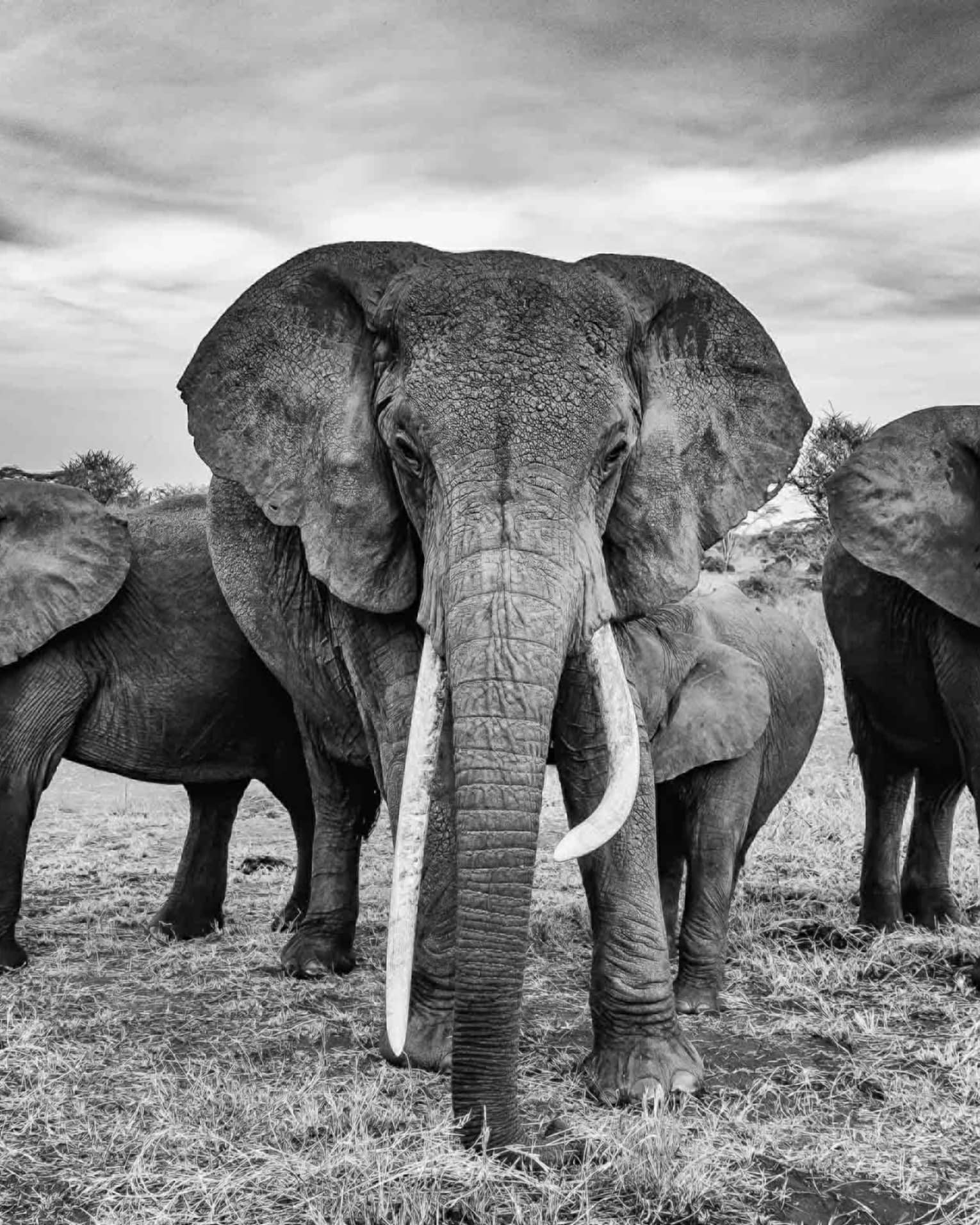
A Walk on the Wild Side

Explore within

Hello, Neighbour

On a walking safari, you have the chance to see the nature in a completely different way than from a vehicle. It is a step-by-step discovery of the Serengeti. Ahmed Attas Discovery Centre Manager

#FSSERENGETI
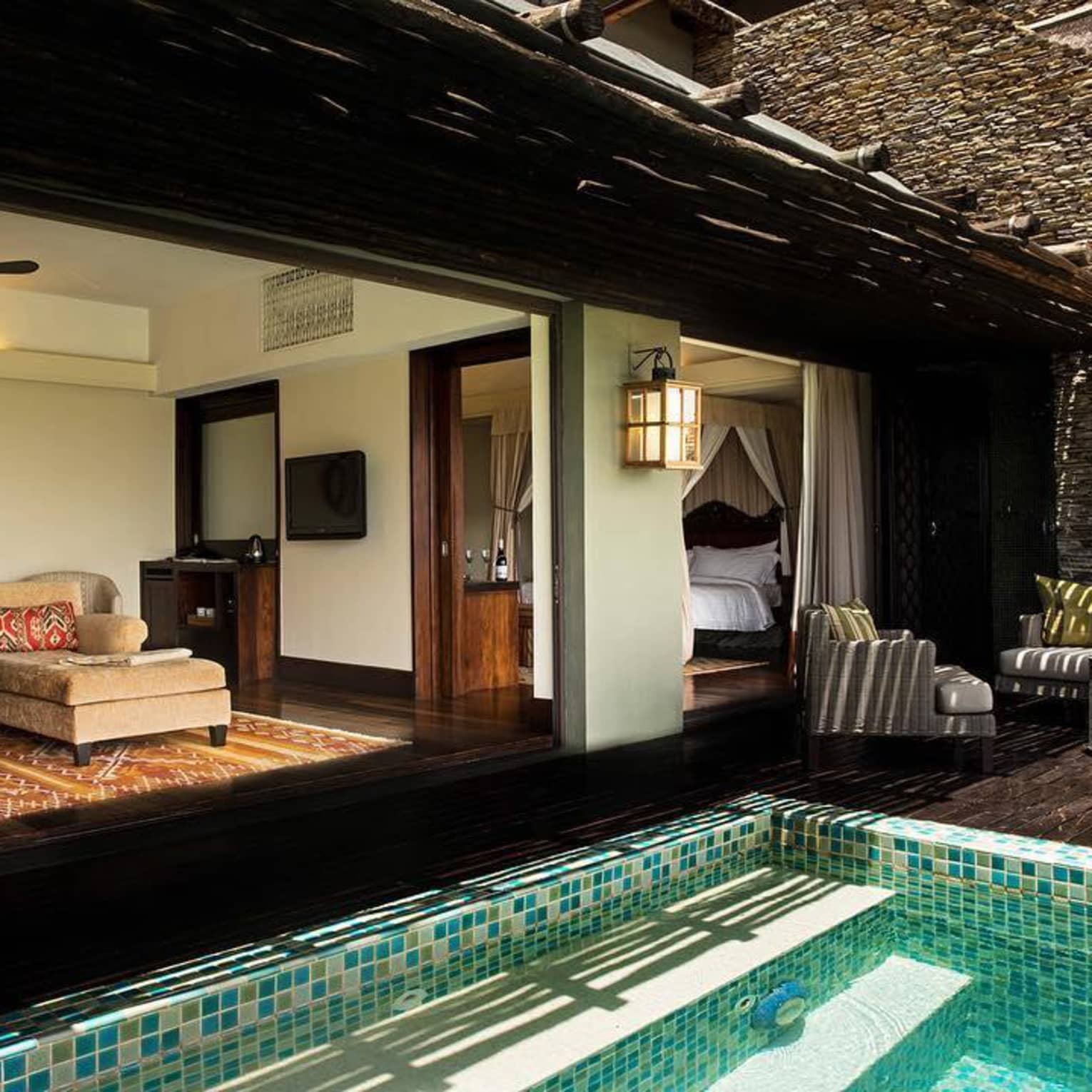
- You are here:
- Tanzania Tours
Ngekewa Tours and Safaris
7-Day Best Serengeti Great Migration Safari

4.9 /5 – 41 Reviews
$1,265 pp (USD)
Your request will be sent directly to the operator
If preferred, you can contact the operator directly
Embark on an unforgettable adventure with the best Serengeti Great Migration safari, where you'll witness one of the world's most awe-inspiring natural phenomena. Join expert guides as they lead you through the vast plains of the Serengeti, where over a million wildebeest and zebras migrate in search of fresh grazing lands.

Tour Features
Budget tour.
This budget tour includes camping and hotels.
Shared tour
On this shared tour, you will join a group of other travelers. Max 6 people per vehicle.
Can start any day
If availability permits, this tour can start on any day.
Cannot be customized
The accommodations and destinations of this tour cannot be changed.
Suitable for single travelers
Single travelers can join this group tour, but it requires a minimum of 6 people to run.
Suitable for all ages
This tour is suitable for children of all ages.
Activities & Transportation
Accommodation & meals.
- Additional accommodation before and at the end of the tour can be arranged for an extra cost
- Day Accommodation Meals
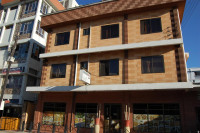
- 3-4 Seronera Public Campsites Budget camping inside Central Serengeti NP – All Meals Included All Meals Included
- 5 Ngorongoro Simba Campsite Budget camping on the crater rim of Ngorongoro Crater – All Meals Included All Meals Included
- 6 Arusha Tourist Inn Hotel Budget hotel in Arusha (City) – All Meals Included All Meals Included
- 7 End of tour (No accommodation) – All Meals Included All Meals Included
Interested in This Tour?
Request a Quote
- We advise requesting quotes from 3 operators ( Learn why )
- Requests are sent directly to the tour operator
- If preferred, you can contact the tour operator directly
Best price guarantee
- This tour is offered by Ngekewa Tours and Safaris , not SafariBookings.
- This operator reserves the right to change rates advertised on SafariBookings.
- This group tour requires a minimum of 6 people to run.
- The exact order, contents and rates of this tour are subject to availability.
- If an accommodation is fully booked, the operator will suggest a comparable alternative.
- What is included in this tour
Get a Free Quote
- More About This Operator
Customer Reviews

Covered every detail for the safari
I had the offer for a 7 day safari from the tour agency, which I have liked the most as seemed that it covered lots of things I wanted to see and was organized very detailed. Overall, all the drivers and helpers were great making sure I had...
Full Review


The complete guide for your Serengeti safari in Tanzania
Without a doubt, Serengeti National Park is the best place to visit for a safari in Tanzania . This UNESCO World Heritage Site is unique for many reasons, but especially because of the Great Migration , the incredible array of wildlife including the Big Five , and the truly wonderful landscapes. Find everything you need to know for a safari in Serengeti, Tanzania.
Why is Serengeti National Park famous?
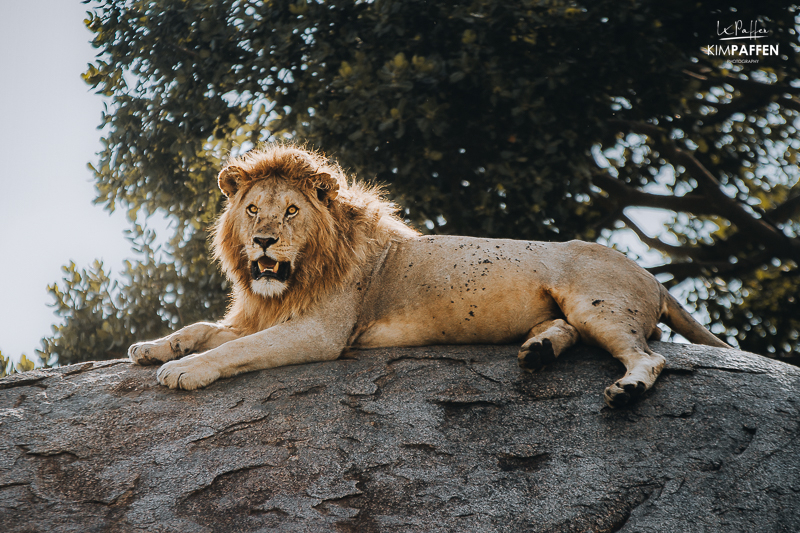
Serengeti National Park is a world-renowned destination for wildlife safaris, famous for its vast grasslands and savannahs, which are home to a spectacular array of wildlife. The park's ecosystem supports one of the largest remaining populations of wildlife in Africa , and is also an important conservation area, with ongoing efforts to protect its wildlife and their habitats.
In 1981, the Serengeti National Park was declared a UNESCO World Heritage Site for its exceptional natural beauty and ecological significance, and for its role in supporting one of the world's largest remaining wildlife populations, including the annual wildebeest migration.
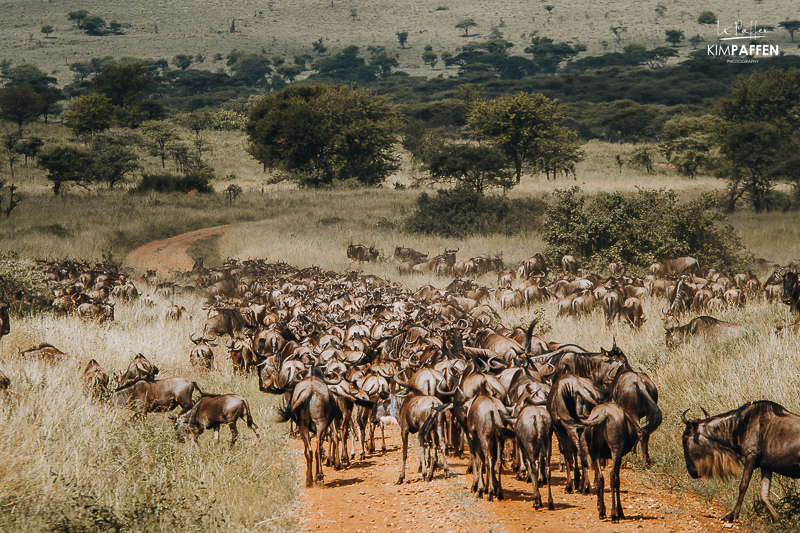
Visitors come from all over the world to experience the park's incredible wildlife, stunning landscapes, and unique cultural and historical heritage. The park's popularity also helps to support the local economy and promote conservation efforts in the region.
The beauty of the Serengeti’s Landscape
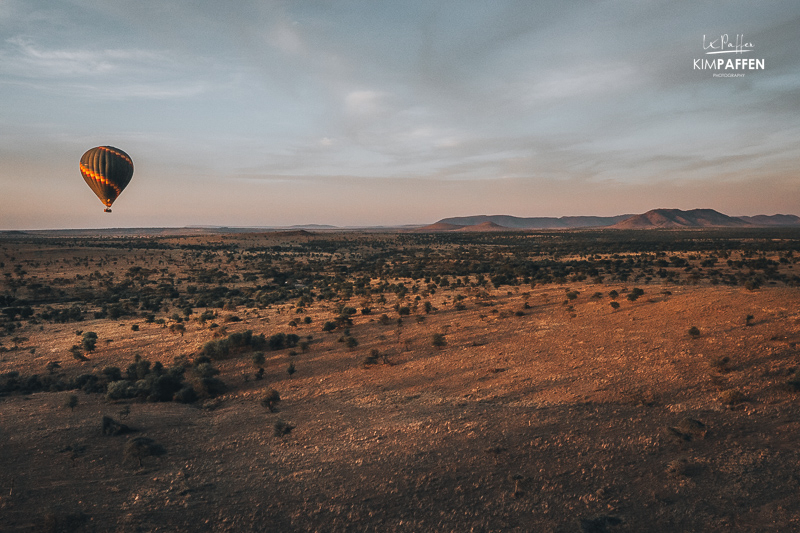
The Serengeti National Park has a diverse landscape that includes vast grasslands, savannahs, woodlands, and riverine forests.
The park's grasslands and savannahs are the dominant landscape, covering approximately 80% of the park's area. The grasslands are characterized by short-grass plains in the south and long-grass plains in the north, and they support large herds of herbivores, including wildebeest, zebras, and gazelles, which in turn attract predators such as lions , leopards, cheetahs, and hyenas. The woodlands and riverine forests are found along the park's river courses and in areas of higher rainfall.
The soils of the Serengeti consist of volcanic rock and ash. For that reason, you will find ancient crystalline rocks in the Serengeti National Park, which are also called "kopjes". Some of them contain African rock paintings. They harbor and are popular resting spots for big cats because they provide shade and drinking water. Can you spot the pride of lions in the image below?
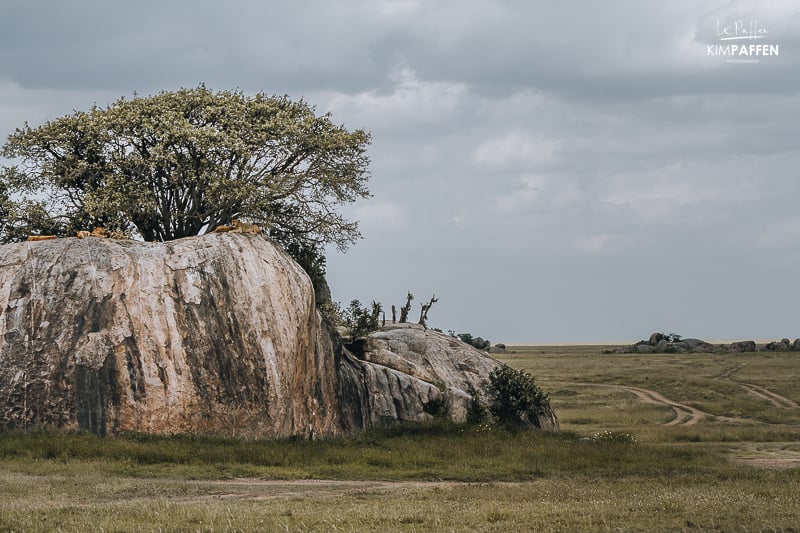
Serengeti Safari Tours
Find popular safari tours in Tanzania that include Serengeti National Park.
Where is the Serengeti National Reserve located?
The Serengeti National Reserve is located in Northern Tanzania , East Africa. It covers an area of approximately 14,750 square kilometers and is part of the larger Serengeti-Mara ecosystem that extends into neighboring Kenya . The Serengeti-Mara ecosystem is one of the largest and most protected ecosystems on earth, spanning 40,000 square kilometers and taking in the Serengeti National Park and Maasai Mara National Reserve in East Africa. Serengeti National Park also borders the beautiful Ngorongoro Conservation Area.
Map Source: African Safaris Ltd
How do you get to the Serengeti?
The nearest city and the city most Serengeti safari tours begin from, is Arusha. The distance between Arusha and Serengeti National Park is approximately 320 kilometers (200 miles) and takes about 7 to 8 hours by car, depending on traffic and road conditions. Alternatively, you can also take a flight from Arusha to one of the Serengeti airstrips . These flights take around 1 to 2 hours depending on the flight route and airline. By far the most popular way to get to Serengeti is by road. You can always choose to fly back from Serengeti to either Arusha Airport, Kilimanjaro Airport, or Dar es Salaam.
Serengeti safari by road from Arusha
Arusha is located in northern Tanzania and is a common starting point for visitors embarking on a safari to the Serengeti National Park. There are many different tour operators and packages available for a Serengeti safari from Arusha , so visitors can choose an itinerary that suits their interests and preferences. Some tours may include game drives , guided walks, and visits to local Maasai villages or conservation projects.
The most popular safari packages in Northern Tanzania include Lake Manyara, Ngorongoro Crater, and Serengeti National Park, for example, these 5-day Tanzania safari tours that include the highlights of the Northern Tanzania Safari Circuit or this 7 to 10-day Tanzania safari including Tarangire National Park, the Ngorongoro Crater, Serengeti National Park, Lake Natron, and Lake Manyara.
Booking a safari tour package can be a convenient option since everything is taken care of, including transportation, accommodation , meals, and activities. This means you don't have to worry about logistics and can focus on enjoying your safari experience. It can often be more cost-effective than planning your own safari plus these safari tours are usually operated by experienced guides.
Many safari tour operators offer customized packages that can be tailored to your interests and preferences. This means you can choose the parks, activities, and accommodations that best suit your needs and budget.
Serengeti by plane
There are several options for traveling to the Serengeti National Park by plane. The main airport that serves the park is the Seronera Airstrip , which is located in the central part of the park.
You can fly to the Seronera Airstrip from Arusha, Kilimanjaro International Airport, Dar es Salaam, or Zanzibar . Several airlines operate flights to the Seronera Airstrip, including Coastal Aviation and Auric Air. If you are visiting other parks in Tanzania, such as the Ngorongoro Crater or Tarangire National Park, you can also fly to the Serengeti National Park via a connecting flight. Many lodges and camps inside Serengeti Park offer transfer services to and from the airstrip.
In addition to the Seronera Airstrip, there are several other airports in the Serengeti region that you may be able to use to access the park. These include:
- Grumeti Airstrip : located in the western part of the Serengeti National Park, near the Grumeti River. It is primarily used by lodges and camps in the western corridor of the park.
- Kleins Airstrip : located in the northern part of the Serengeti National Park, near the border with Kenya. It is primarily used by lodges and camps in the northern part of the park, such as Klein's Camp.
- Kogatende Airstrip : located in the northern part of the Serengeti National Park, near the Mara River. It is primarily used by lodges and camps in the northern part of the park, such as Sayari Camp and Lamai Serengeti.
It's important to note that not all lodges and camps in the Serengeti have their own airstrips , and some may require ground transfers from nearby airstrips. It's best to check with your lodge or tour operator to determine which airport is most convenient for your specific itinerary.
Private transfer by car (taxi)
There are several transport services in Tanzania that offer private taxis, shuttles, and bus services to the Serengeti National Park. Most transportation companies are located in Arusha. Serengeti National Park is large, so the costs depend on where you want to go (total distance). Note that private transfers to Serengeti are often expensive as the cost of the return trip also needs to be covered. Additionally, the driver also needs to pay entrance fees if you want to be taken to a lodge inside the park.
Many tourists choose to combine Serengeti National Park with other parks that are located near Serengeti, such as Lake Manyara National Park, Ngorongoro Crater, or Tarangire National Park.
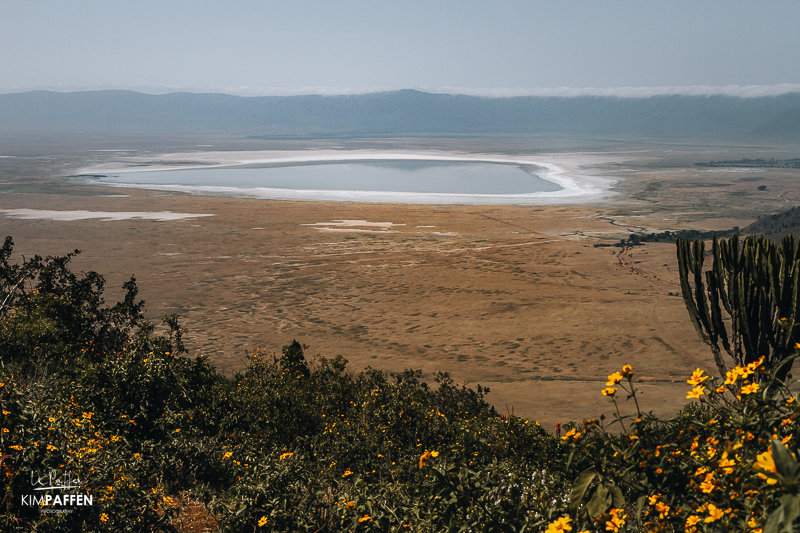
I highly recommend combining a Serengeti safari with other National Parks and booking your customized safari package through a tour operator, for example via SafariBookings.com .
Public transport
Determined to explore Serengeti on a budget? Public transport is the cheapest way to travel in Tanzania. Large buses and ‘daladalas’, which are small public transport buses, crisscross the country and link the major towns. Longer routes even link Dar es Salaam with Nairobi and Mombasa in Kenya. Public transport is quite efficient between big cities, but it gets slower, less comfortable, and more challenging when you intend to reach smaller towns. To cover short distances, tuk-tuks and boda-bodas can be used.
In Tanzania’s National Parks, there's no public transport, so you cannot access Serengeti National Park without a private vehicle. This means you can only use public transport for the part of your trip which is out of the park, but this will be an adventure.
Self-drive in the Serengeti
Self-driving in Serengeti National Park is allowed, however, it is important to keep in mind that careful planning is necessary when driving through the park by yourself. A 4x4 vehicle is required to be able to access all roads throughout the year, and it is important to be familiar with the park's rules and regulations. It is also recommended to have a good understanding of the park's geography and to carry a detailed map. Additionally, it is important to be aware of the risks and challenges of driving in the park, such as navigating rough terrain and encountering wildlife on the roads. Therefore, it is generally recommended to use a reputable local tour operator or guide to ensure a safe and enjoyable experience in Serengeti National Park.
What is the best time for a safari in Serengeti, Tanzania?
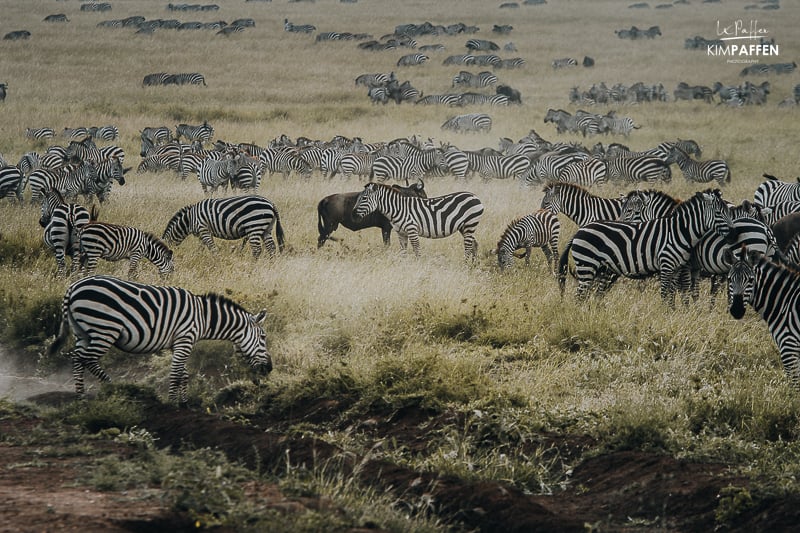
The best time for a safari in Serengeti depends on what you want to see and experience. The annual Great Migration is one of the main attractions in Serengeti, and it usually takes place from November to August. The best time to witness the wildebeest migration is from December to July when the herds of zebras and gnus are in southern and central Serengeti. However, visiting the Serengeti in December can be tricky due to the unpredictable weather. From July to October the Great Migration will take place in the northern part of Serengeti and the Masai Mara in Kenya.
The best time for a safari in Serengeti, Tanzania is also influenced by the weather. The dry season, from June to October, is considered the best time to visit as it offers clear skies, lower humidity, and good visibility for wildlife viewing. The rainy season, from November to May, is when the park is lush and green, with many newborn animals and migratory birds, but it can also make the roads difficult to navigate.

If you're interested in seeing big cats, such as lions and leopards, the dry season from June to October is the best time to visit. During this time, the vegetation is sparse, making it easier to spot these elusive predators.
If I had to pick a favorite time to visit, I would choose October as the best month to visit Serengeti . It’s when the dry season ends and the wildlife gathers around water sources, making it easier to spot them. It's also the time when the wildebeest migration is in full swing, the weather is mild, and there is little rain, making it a comfortable and less crowded period to visit. You gotta love these shoulder seasons!
How safe is Serengeti?
Visiting Serengeti National Park is safe , but it's important to respect the animals and park rules and regulations, including the prohibition of littering and feeding animals, and follow the advice of your safari guide , who is a trained and experienced professional. The reserve is protected by certified park rangers , ensuring your safety, so inside Serengeti National Park there is no need to worry about safety.
How many days do you need in Serengeti?
The length of your visit depends on your preferences and schedule, but I would recommend spending at least three to four days in Serengeti to fully experience its beauty and wildlife because Serengeti has a lot to offer. The more time you have, the better.
Visiting Serengeti National Park for three days should give you enough time to explore the park, spotting various animal species, and experience the different landscapes. If you have a specific interest in seeing the Great Migration or want to go on longer game drives, a 4-5 day visit is more ideal.
Is Serengeti expensive?
Serengeti National Park can be expensive, but the cost of visiting the park depends on a few factors, such as the type of accommodation, the time of year you visit, and the activities you plan to do.
Accommodation in Serengeti ranges from budget camping sites to luxury lodges, so the cost of your stay will depend on your preferences and budget. Generally, the more luxurious the accommodation, the higher the cost.
The costs of safari activities in Serengeti , such as game drives, hot air balloon safaris , and guided walks, can also vary depending on the operator you choose and the duration of the activity.
Furthermore, the Serengeti park entrance fees for foreign visitors are relatively high, with a daily fee of $70 per person per day for adults and $20 for children (as of 2023). These fees are subject to change, and there may be additional fees for certain activities.
For instance, this budget 3-day Serengeti safari package starts at $728 per person including park fees, activities, transportation, budget camping, and meals.
Which part of Serengeti is best?
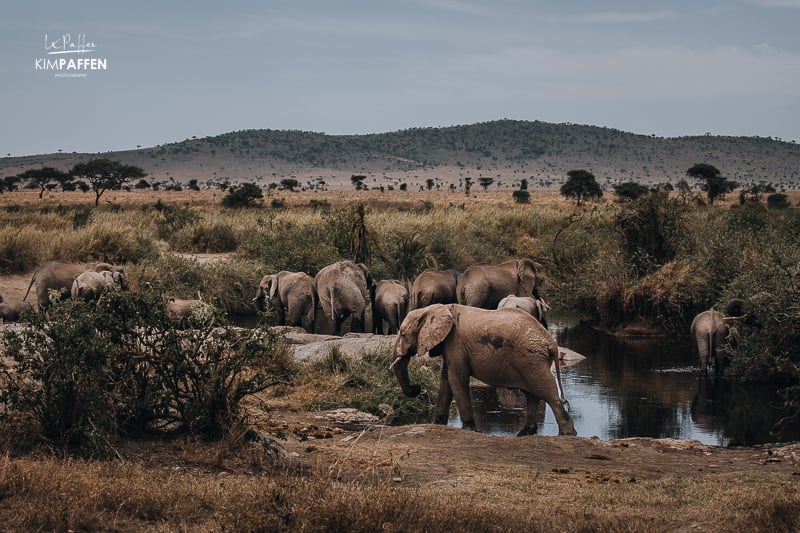
Serengeti National Park is divided into several different regions, each with its own distinct features and wildlife viewing opportunities, making it hard to say which part of Serengeti is the best.
The Seronera region is the heart of the Park, located in Central Serengeti. It is known for its wide-open savannah landscape and abundant wildlife, including the Hippo Pool full of countless hippos. Simba Kopjes, a group of rocky hills, is a popular area in Seronera, famous for its lion sightings and high density of leopards. However, note that the Seronera Valley is the busiest area of the park.

Northern Serengeti is a more remote and rugged region, home to the Mara River, which is known for its scenic beauty and wildlife, including spectacular river crossings and predators such as lions and crocodiles.
The Western Corridor is located in the western part of Serengeti National Park, with the Grumeti River running through it, attracting various predators and hosting large herds of wildebeest and zebras during the migration season.
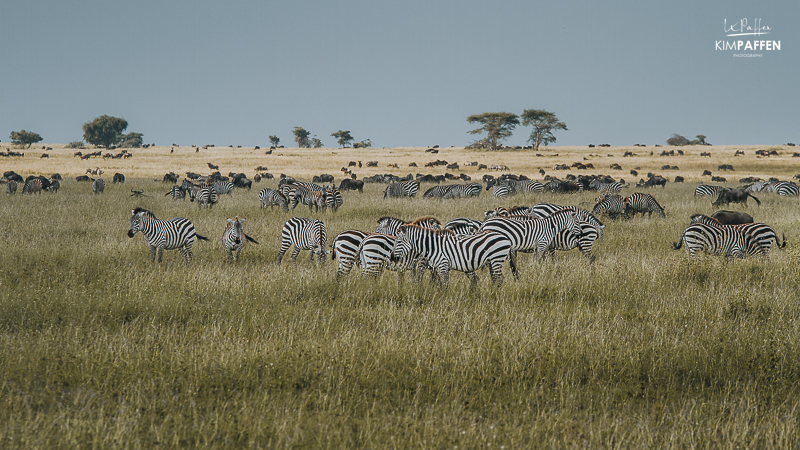
Eastern Serengeti is known for its open savannah grasslands and is less visited than the other regions, but still home to a variety of wildlife, including giraffes and elephants.
Ndutu , located in Southern Serengeti and part of the Ngorongoro Conservation Area, is another popular area to visit. It is famous for its large open plains and is the breeding ground for wildebeest and zebras during the calving seasons in March and April, attracting plenty of predators such as cheetahs and lions. As there are no fences between the parks, the animals are free to roam.
Serengeti Balloon safari
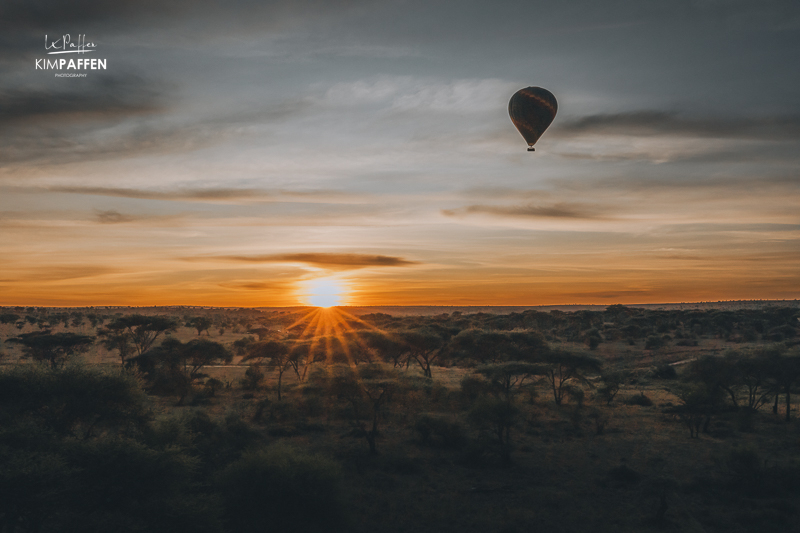
To get the best out of your Serengeti experience, you should definitely book a balloon safari . A Serengeti Balloon Safari is a popular activity and is a unique way to experience the park and see its wildlife from above. The balloon safari takes place early in the morning, just before sunrise. The balloon flies low over the Serengeti's plains and savannahs, providing a panoramic view of the landscape and wildlife below.

During the flight, passengers can expect to see a variety of animals, including elephants, lions, giraffes, zebras, and wildebeest. The flight typically lasts for about an hour, after which the balloon lands and passengers are treated to a champagne breakfast in the middle of the Serengeti wilderness.
Serengeti Travel Tip: Read more about a Serengeti balloon safari if you're interested in a hot-air balloon ride in Serengeti. That article also includes an attractive discount!
Is Serengeti better than Masai Mara?
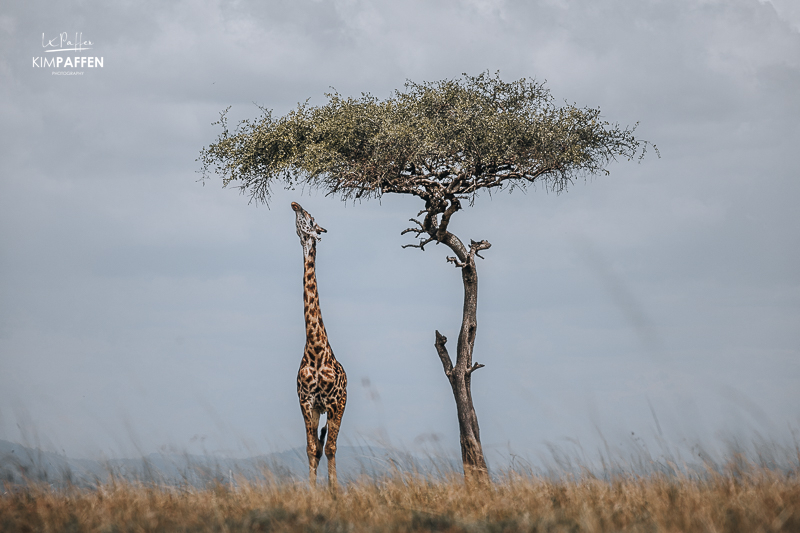
Serengeti and Maasai Mara are two incredible safari destinations that share the same ecosystem, wildlife, climate, and types of landscapes, yet they have some distinctions. While both offer an exceptional safari experience, there are some notable differences between them. For instance, Serengeti National Park is larger than the Masai Mara National Reserve and relatively more expensive. The primary reason for the price discrepancy is that tourists typically stay within the Serengeti, where they are required to pay a daily concession fee in addition to the National Park fee (140 USD in total).
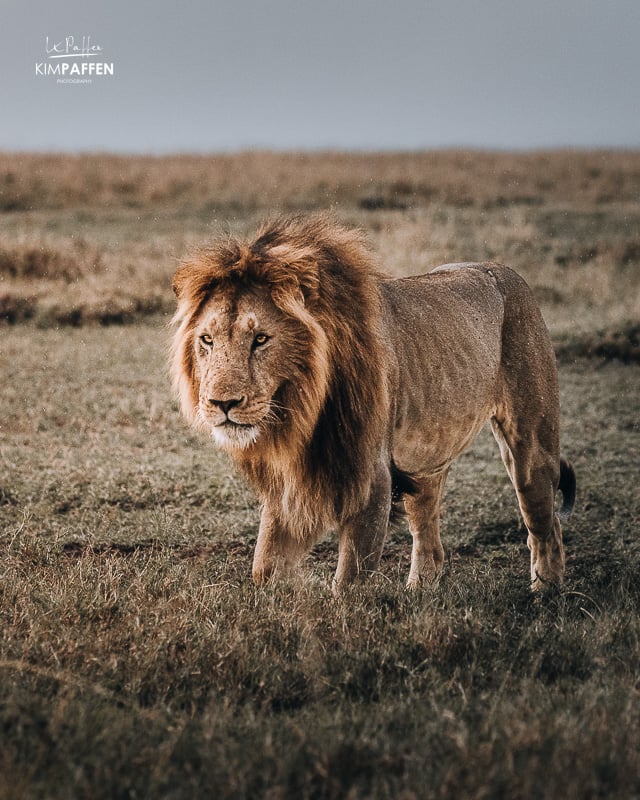
Determining whether the Serengeti or the Masai Mara is better is difficult, as both offer unique and memorable safari experiences. However, personally, I love to spend time in the Mara Conservancies, bordering the Masai Mara National Reserve.
Is Serengeti malaria-free?
Serengeti National Park is located in a malaria-endemic region, and there is a risk of contracting malaria while visiting the park. Due to the limited water sources, the high altitude, and the prevalence of short grasslands within the Serengeti National Park, the mosquito population is relatively low, which results in a reduced risk of contracting malaria while visiting the park.
However, it's important to note that even though the park has fewer mosquitoes and lower chances of malaria cases, it doesn't completely eliminate the presence of mosquitoes in the Serengeti. It's always advisable to consult with a healthcare professional before traveling to a malaria-endemic area and to take preventive measures against malaria, such as wearing long-sleeved clothing and pants, using insect repellent, and sleeping under a mosquito net.
Is Serengeti fenced?
Serengeti National Park is not entirely fenced. The park is part of a larger ecosystem that includes several wildlife reserves and protected areas, and wildlife can move freely between these areas. This is especially true during the annual wildebeest migration, where millions of animals move across the Serengeti-Mara ecosystem. However, there are some smaller fenced-off areas within the park, such as some of the lodges and campsites that have fences for the safety of guests.
How to enter the Serengeti National Reserve?
The Serengeti National Park is primarily accessible by plane or via road transportation. The park has multiple entry gates into Serengeti , including Naabi Hill Gate, Kleins Gate, Fort Ikoma Gate, Ndabaka Gate, and Habdajega Gate.
There are four main entry and exit points into the Serengeti:
- Naabi Hill Gate is the main gate, and the busiest entrance point, located about 45 kilometers from Seronera. The gate is open daily from 06h00 to 18h00.
- Ndabaka Gate is the primary access gate for the Western Corridor area, which is approximately a 1.5-hour drive from Mwanza and 145 kilometers from Seronera. The gate is open daily from 06h00 to 18h00, but the last entry is at 16h00.
- Klein’s Gate is situated in the far northeast of the Serengeti and is open daily from 06h00 to 18h00, with the last entry at 16h00.
- Bologonya Gate is located en route to or from Kenya; do check if the gate is (still) closed as it was closed for a while.
Best places to stay in Serengeti
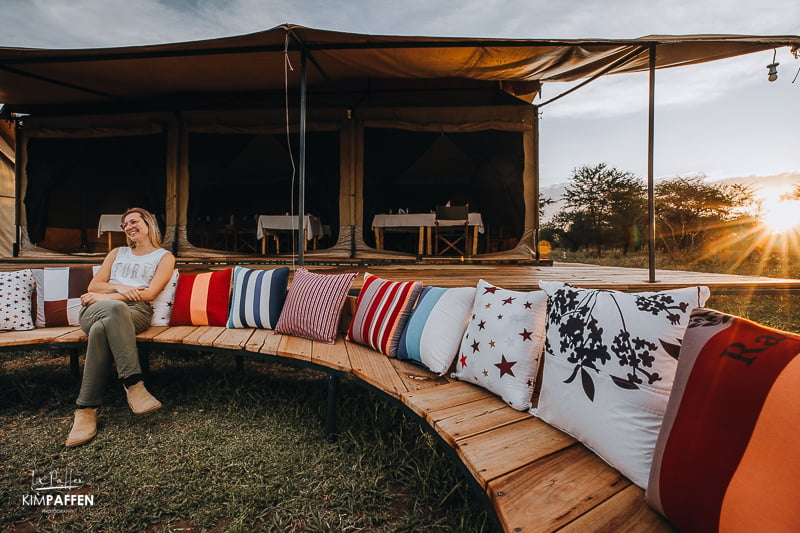
There are many excellent places to stay in Serengeti , ranging from luxurious lodges to budget-friendly campsites. The best place to stay depends on your preferences, budget, and travel style.
If you're looking for luxury, some of the best lodges include Singita Sasakwa Lodge , Four Seasons Safari Lodge Serengeti , and AndBeyond Grumeti Serengeti Tented Camp . These lodges offer top-notch amenities, personalized service, and breathtaking views.
For mid-range options, you might consider places like Serengeti Serena Safari Lodge , Lemala Kuria Hills Lodge , or Serengeti Explorer Camp . These lodges offer comfortable accommodation, good food, and a range of activities.
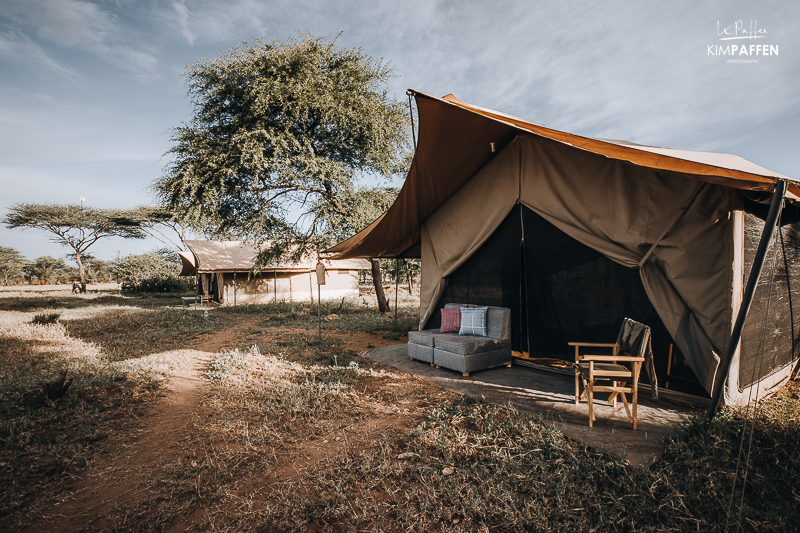
If you want to visit Serengeti on a budget , there are several campsites and budget-friendly lodges in and around the park, such as Ikoma Tented Camp , Serengeti Acacia Camp s, and Tanzania Bush Camps . These accommodations offer basic amenities but still provide a great safari experience.
During my last Serengeti trip with the Tanzania Tourism Board, we stayed in the lovely Pamoja Serengeti Luxury Camp , situated at the center of the vast Serengeti National Park, in Seronera. We absolutely loved staying at this intimate privately-owned wilderness camp because of the outstanding staff, delicious buffet, lovely views from our luxury tented suite, and overall exclusivity.
The proximity to wildlife is one of the reasons that makes Pamoja Serengeti Luxury Camp unique. If you're lucky (like us), you will even spot elephants or cheetahs passing by your tents or the lounge area; the ultimate bush feeling!
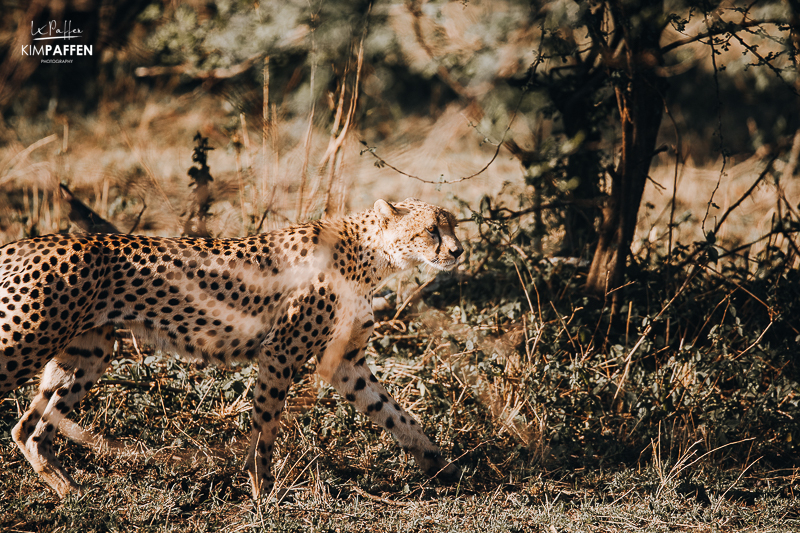
Is a safari in Serengeti worth it?
A safari in Serengeti is definitely worth it. Serengeti National Park is one of the most famous and spectacular wildlife reserves in the world , renowned for its abundant wildlife, stunning landscapes, and unique cultural experiences. Visitors can witness the Great Wildebeest Migration , which is one of the most incredible wildlife spectacles on earth, where millions of wildebeest, zebras, and other grazers move across the Serengeti ecosystem in search of fresh grass and water.
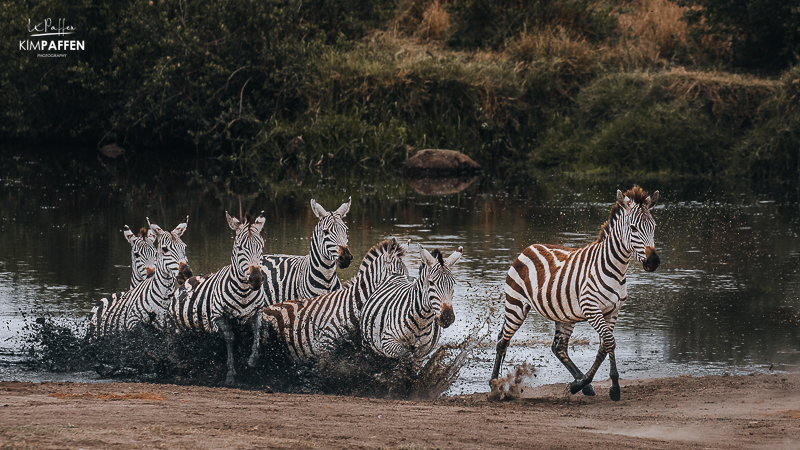
Serengeti offers an opportunity to see a diverse range of wildlife including lions, leopards, cheetahs, elephants, giraffes, hyenas, and many more. The park also has a rich cultural heritage , with the Maasai people living in and around the park and offering visitors an opportunity to experience their unique way of life.
Whether you go for a luxury family safari, a solo trip, or a customized tour, a Serengeti safari won’t disappoint you.
Looking for more Tanzania inspiration? Check my Serengeti travel guide to read about the top safari destinations in Tanzania like the Ngorongoro Crater, and the tallest mountain in Africa; Mount Kilimanjaro, and more featured Safari Tips for Tanzania.
Serengeti Safari in Tanzania
Feel free to contact me if you have questions about a safari in Tanzania or getting around in the Serengeti National Park. If you are planning your first-ever safari, it might be useful to read the following articles:
- Tanzania Northern Circuit: 10 best places to visit
- What to expect on a hot-air balloon safari in Serengeti?
- What to expect on a game drive in Africa? 15 things you need to know
- 7 tips to make the most out of your safari game drive
- What to pack for a safari in Africa? Use this Safari Packing Guide
I hope this article was helpful for you to plan your Serengeti safari itinerary. If so, I would be extremely thankful if you'd share this blog on social media and leave a comment below.
Pin this guide to a Serengeti Safari in Tanzania for later use!


Serengeti Safari
Why go on a serengeti safari.
The Serengeti ecosystem is a geographical region in northern Tanzania, bordering Kenya, Lake Victoria, and the Ngorongoro Conservation Area. It’s also a UNESCO-listed World Heritage national park that offers year-round safari adventures.
The wonder and excitement of a Serengeti safari can be enjoyed in the low season when fewer tourists crowd the majestic landscapes. From June to October, the Great Migration crosses back and forth over the Mara River, a spectacular sight, but also the busiest time of the year. Marvel at cheetah on termite mounds surveying the landscapes for prey, elephant herds on vast plains, and other fantastic wildlife. Book your Serengeti safari now and discover its secrets for yourself.
Browse our image and video galleries below to see some of the wildlife, scenery, activities and accommodation in the Serengeti National Park.

Hot air balloon safaris are a truly unique way to explore the Serengeti.
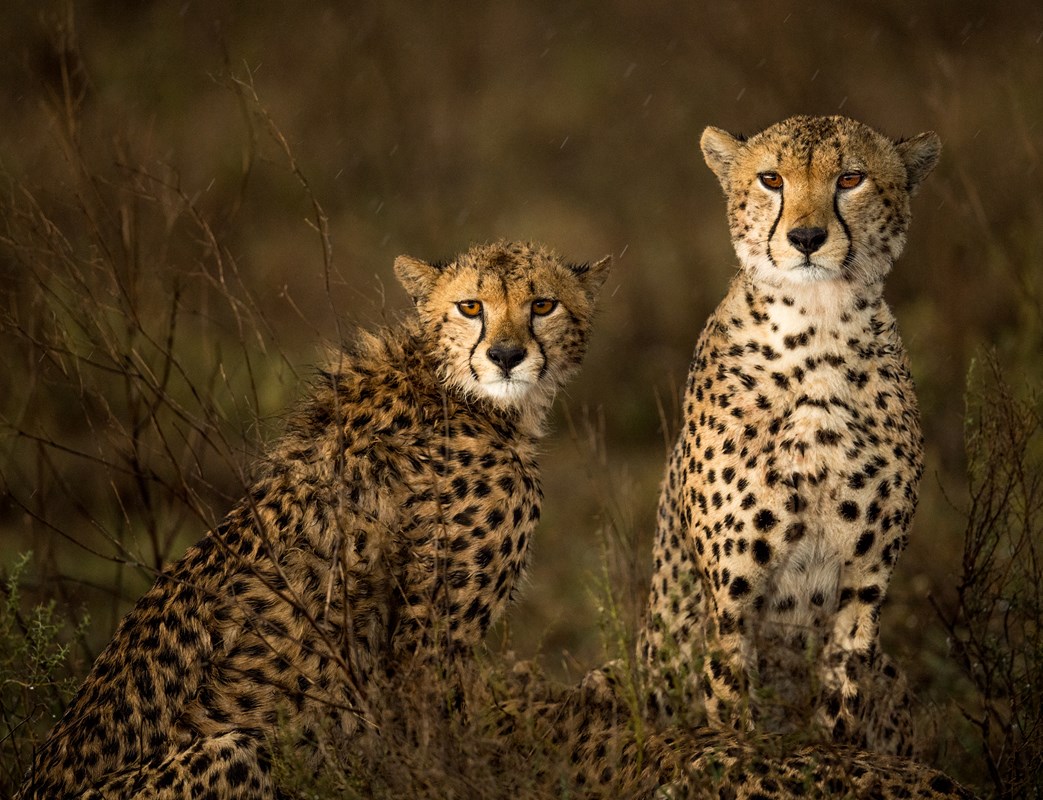
A pair of cheetah looking moody in the rain.
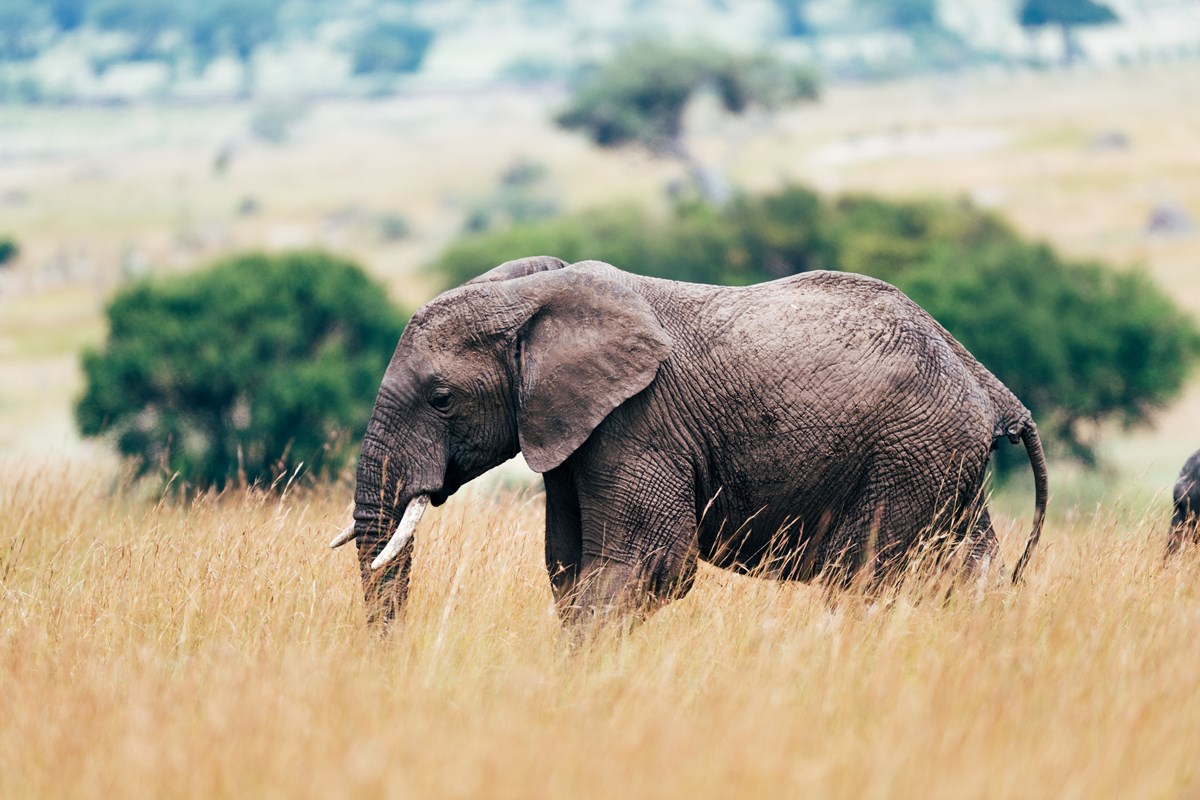
The Serengeti is one of the most iconic destinations in the world.
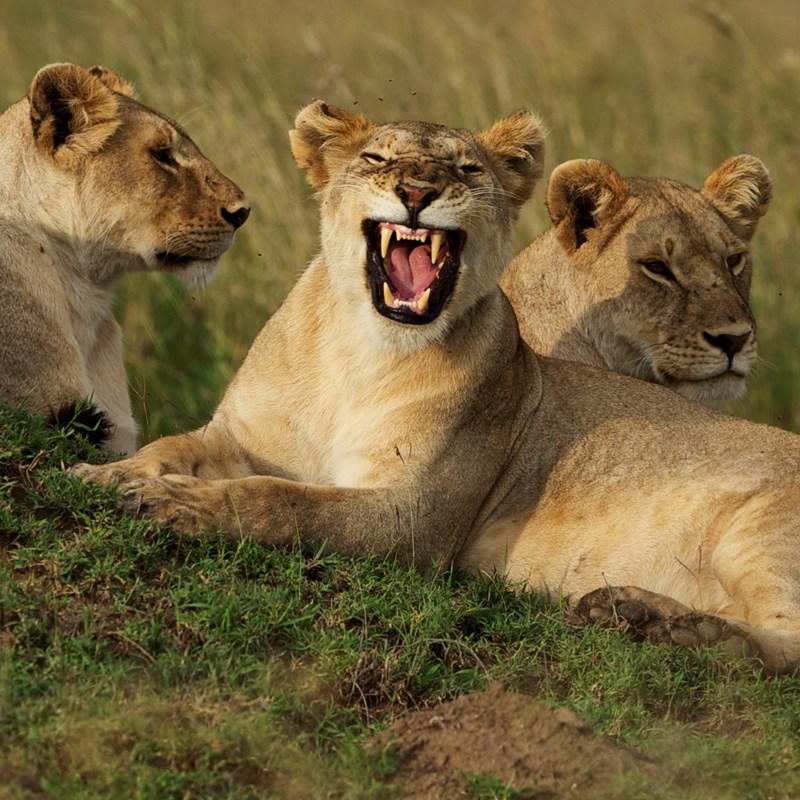
The Serengeti is home to a remarkable number of species, including over 70 big mammals and more than 500 bird species.
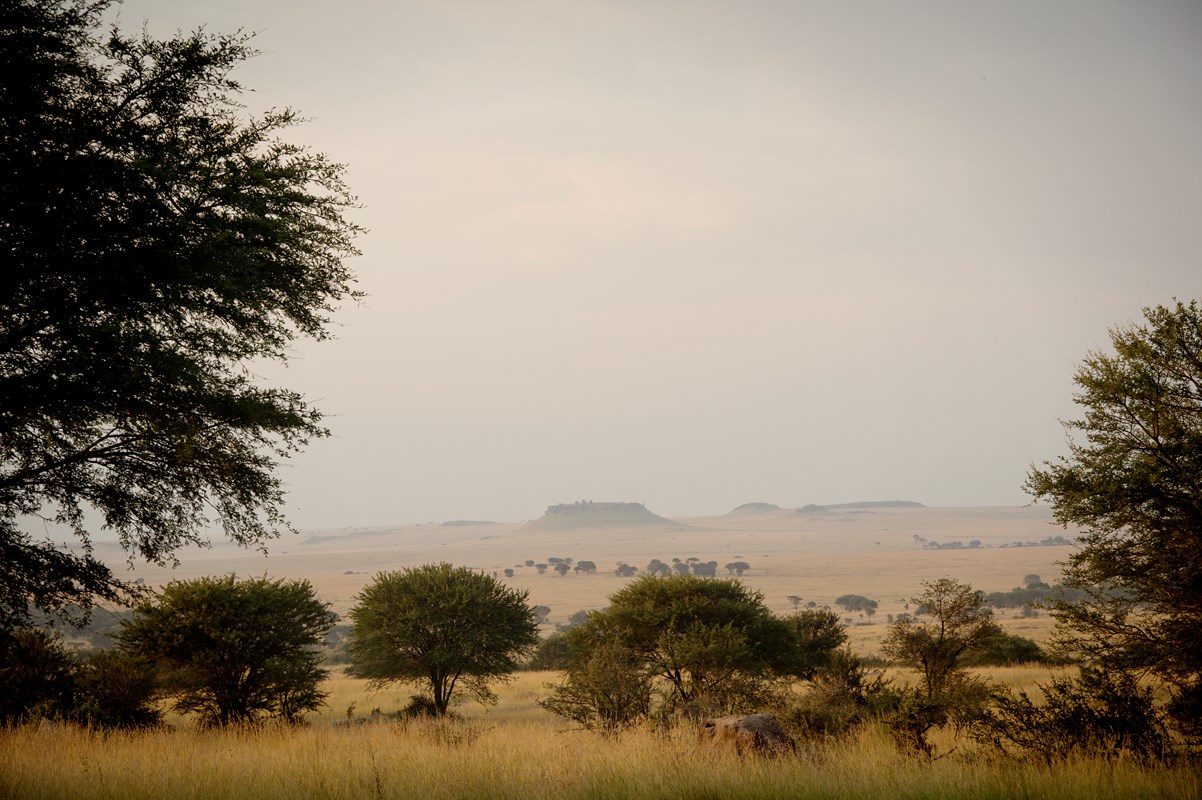
The Serengeti is an excellent year-round destination.
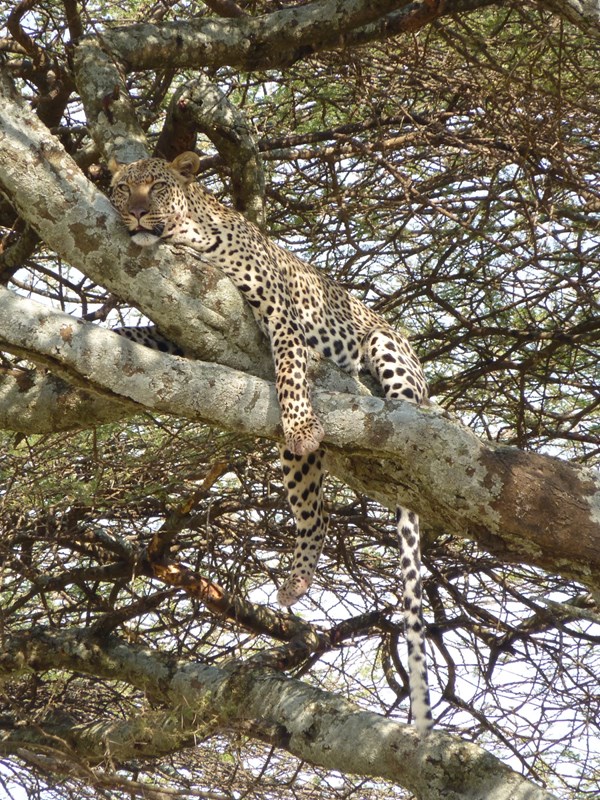
A leopard lounges in the treetops.
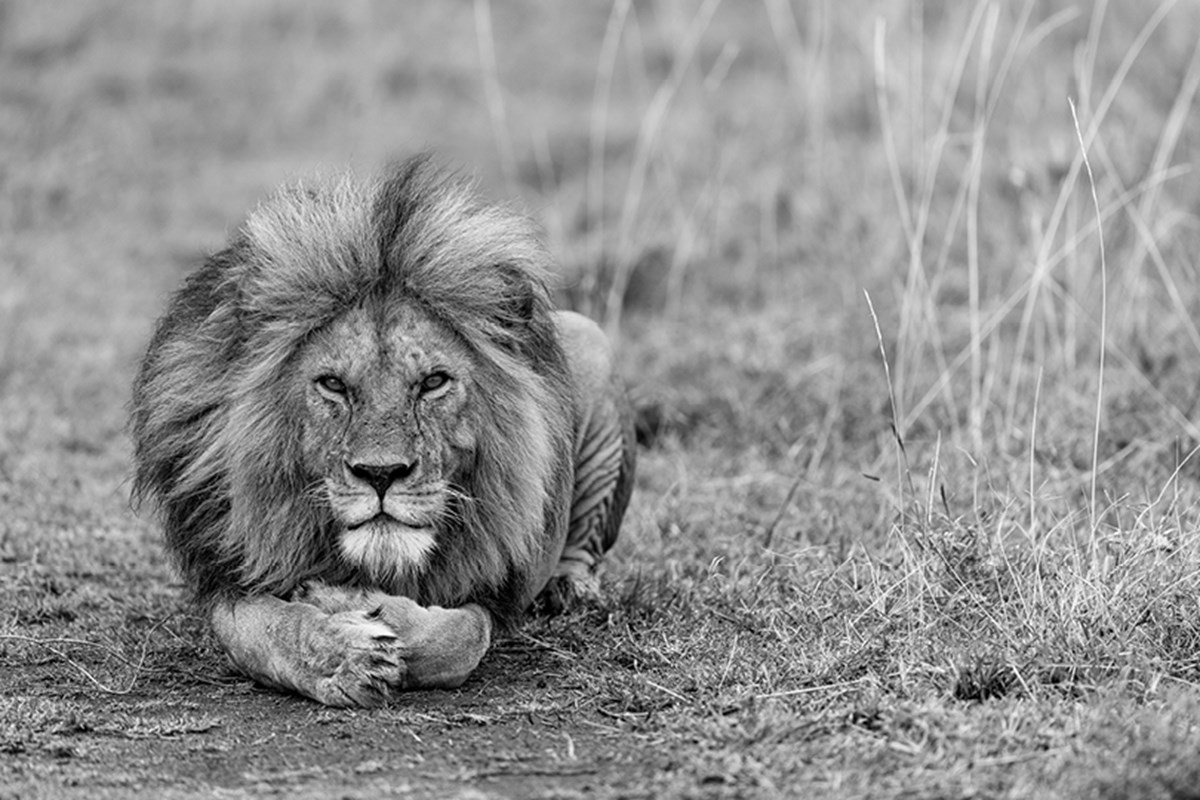
The Serengeti is home to some 3,500 lions as well as many other predators.
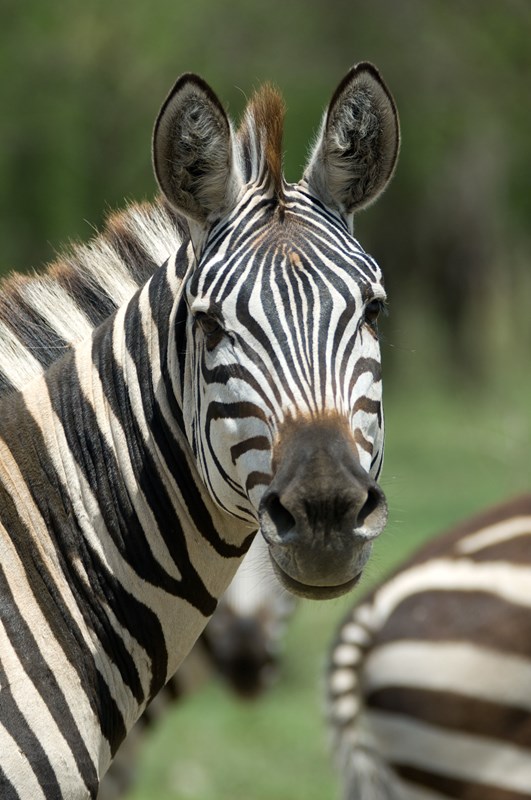
A zebra spotted while out exploring the region.
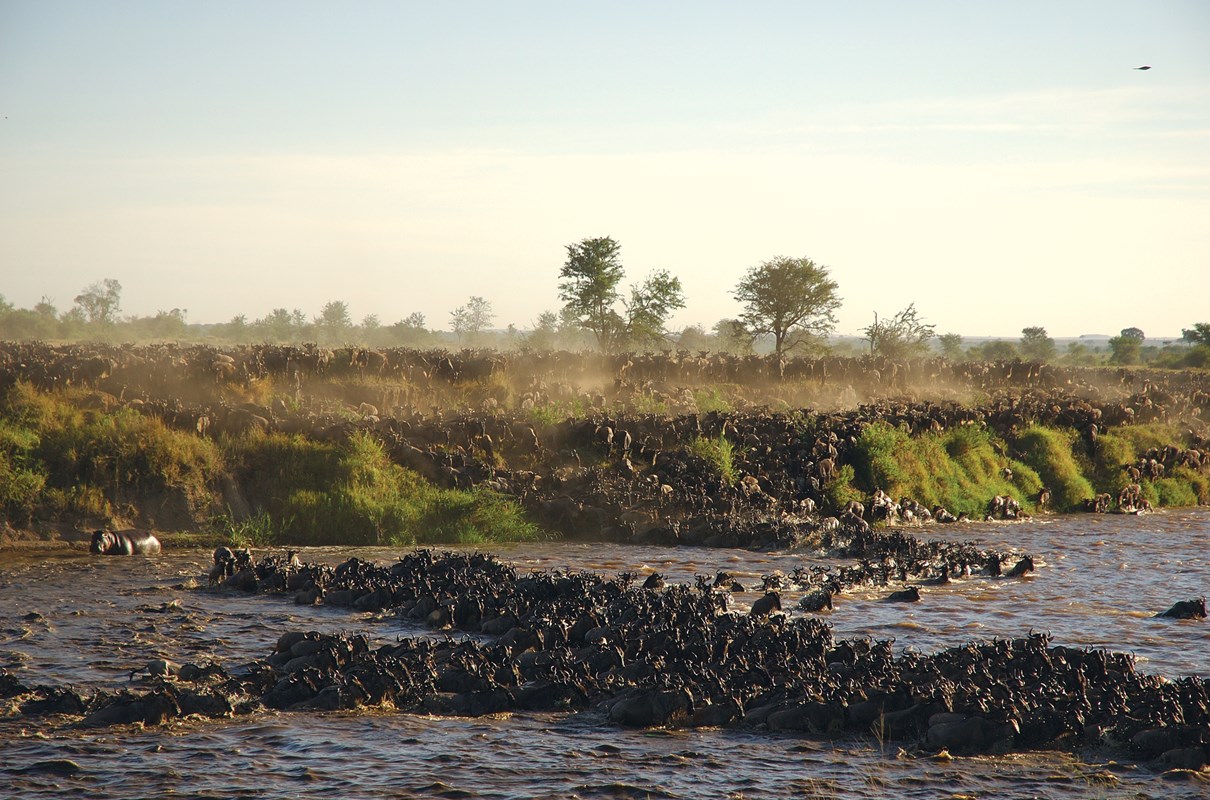
The Serengeti is host to the dramatic Great Migration.
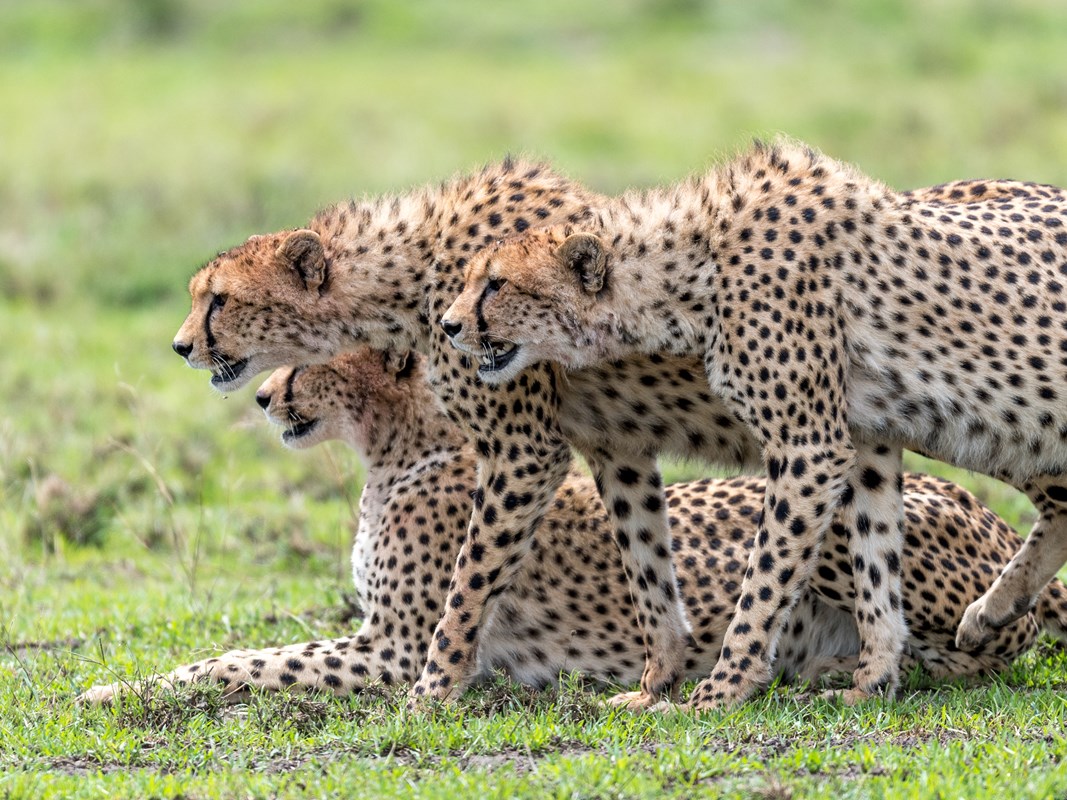
A family of cheetah on the hunt for their next meal.
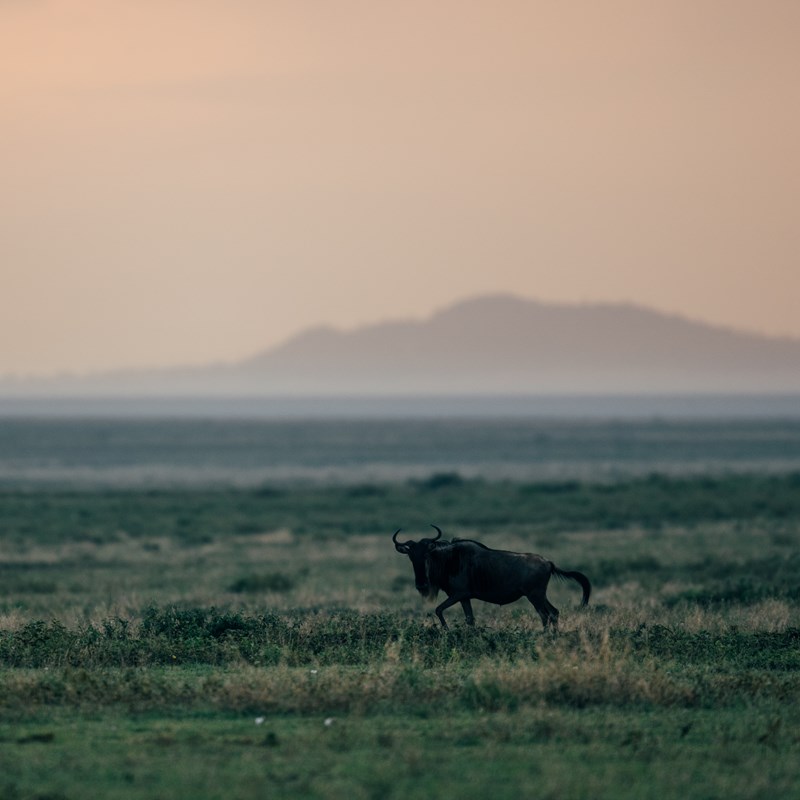
The Great Migration moves in a continuous cycle around the Serengeti and Kenya’s Masai Mara.
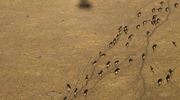
Serengeti Safari Camps
Our properties are elegant and timeless. We offer both permanent and mobile camp adventures that follow the Great Migration.
Dunia Camp: Nestled in the Serengeti’s heart, Dunia Camp offers our guests a chance to experience the wonders of the African wilderness. From your spacious tent, you can enjoy panoramic views of the vast open savannahs, where thousands of wildebeest and zebra migrate in search of fresh grass. You can also witness the majestic lion prides that often lounge on the nearby granite boulders that dot the landscape.
Namiri Plains Camp : Experience one of the best locations in Africa to see big cats. Breathtaking wildlife and a luxurious safari camp, offering year-round game viewing in the remote corner of the eastern Serengeti. The camp is highly involved in regional cheetah conservation, supporting research and protection efforts for these endangered cats.
Olakira Camp: Witness the most spectacular wildlife spectacle on earth at Olakira Migration Camp, our unique mobile camp that follows the massive herds of wildebeest as they traverse the vast plains of the Serengeti in search of fresh grass and water while facing the constant threat of hungry predators such as crocodiles and lions.
Sayari Camp: Discover the ultimate safari experience at Sayari Camp, our luxurious award-winning permanent camp in northern Serengeti's prime wildlife area. Our superior location allows you to marvel at the incredible sight of thousands of wildebeest braving the crocodile-infested waters of the Mara River during the Great Migration, one of the world’s most awe-inspiring natural phenomena.
Ubuntu Camp: Immerse yourself in the drama and beauty of the Great Migration from our mobile-tented Ubuntu Migration Camp. Carefully positioned in the best locations in both the northern and southern Serengeti, follow the movement of the vast herds of wildebeest as they face the challenges of predators, rivers and changing landscapes. Ubuntu Camp offers an intimate and authentic connection with nature, as we leave no trace behind except our footprints.

Dunia, in Tanzania’s central Serengeti, offers a prime position for safari throughout the year. Enjoy plentiful resident wildlife without the crowds, exploring the nearby Moru Kopjes in search of lion…

Namiri Plains
Set in a remote location in Tanzania’s eastern Serengeti, Namiri Plains offers the ultimate big cat safari experience. Previously a cheetah conservation initiative, the area is now also a haven for li…

Olakira Migration Camp
The mobile Olakira Migration Camp follows the wildebeest migration around the Serengeti, from the epic river crossings in the north to the southern plains where they give birth to thousands of calves…

Sayari Camp
Set on the untouched plains of northern Serengeti, this stylish, award-winning camp is perfectly located near the famous Great Migration route and several crossing points along the Mara River, where s…

Ubuntu Migration Camp
Ubuntu Migration Camp follows the colossal herds of wildebeest as they journey around the Serengeti. From the dramatic river crossings in the north to the fertile grasslands in the south where the wil…
Top Serengeti Safari Activities
Game Drives: Our seven-seater, open-sided game vehicles come equipped with canvas roofs, power points, and fridges, providing everything you need to stay comfortable while getting close to large herbivores and predators.
Hot-Air Balloon Rides: Soar silently and peacefully over the vast savannas in a hot-air balloon, spotting sensational wildlife and watching a stunning sunrise.
Photographic Safaris: Experience the thrill of wildlife photography like never before with our specialised photographic vehicles. They offer 360° views of stunning landscapes and majestic animals, allowing you to capture the perfect shot from any angle. Don’t miss this opportunity to unleash your creativity and explore the wonders of nature from our photographic vehicles. (Only available at Sayari Camp and Namiri Plains)
Walking Safaris: Embark on a walking adventure through the bush with your experienced guide, observing the smaller creatures of the bush, like ants, termites, and dung beetles. You'll also learn how to track animals using their footprints and droppings.
Video Gallery
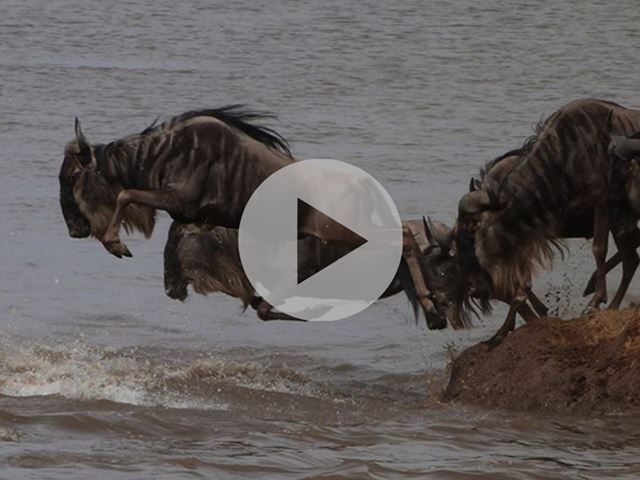
Serengeti Itineraries
Our experienced trip designers are here to fulfil your Serengeti safari dreams. We will guide you at every step and offer expert advice to make your safari a unique, unforgettable, and extraordinary experience. Look at these itineraries, great examples to inspire and ignite your wanderlust.

All Asilia: Reserve circuit
Experience the best of Tanzania and Kenya in style and comfort over 10 days.

All Asilia: Northern Tanzania circuit
Explore the vast beauty of northern Tanzania's wildlife reserve over 9 days.

All Asilia: Family safari with older children
Experience a thrilling family safari in Tanzania over 9 days.

Honeymoon Heaven
An African honeymoon is unlike any other. Romantic hot air balloon rides over the Savannah, adventurous game drives through wilderness areas, sandy white beaches, and tropical waters; there is somethi…

Northern Tanzania Explored
With vast wilderness areas that teem with big game, interesting cultures, easy logistical links, and some of the most iconic landscapes on the planet, northern Tanzania offers a safari experience like…

Exclusive Tanzania
Enhanced by the incredible beauty of the East African landscape, our Reserve Camps featured in this itinerary exude character and meticulous attention to detail. Every desire is beautifully met; from…

Tanzania Highlights
With countless combinations available throughout Tanzania’s “Northern Circuit”, this short but carefully curated bush and beach combination removes the confusion and offers the perfect introduction to…

Great Migration Adventure
If time restrictions are driving your decision-making process regarding how your northern Tanzania safari should be structured, then these 7 day options are likely to prove useful. While there are man…

Explore East Africa
For a safari experience that captures some of the best locations and experiences on offer across Kenya and Tanzania (and optionally, Zanzibar), look no further than this itinerary. Incorporating the M…

10-Day Rwanda and Tanzania Trekking and Safari
Experience a magical adventure to see chimps and gorillas in the wild, taking in Rwanda and Tanzania over 10-days.

9-Day Northern Tanzania Bush and Island Adventure
Explore the very best of Northern Tanzania on this exciting 9-day adventure.
- Camps & Lodges
- Destinations arrow_right
- Special Offers
- Partner Properties
- Positive Impact
- Join our newsletter
- All Asilia Offer: Free Inter-Camp Travel
- Enquire Now arrow_right
- Asilia giving
- Popular Destinations

As featured in

The Serengeti
The serengeti sets the stage for the great migration – when close to 2 million wildebeest, zebra and gazelle make their way across the endless grasslands in search of greener pastures..
This theatre for the largest terrestrial mammal migration on Earth stretches from the Ngorongoro Highlands in the south, to Kenya’s Masai Mara in the north. Around 30,000km2 in size, the Serengeti National Park is flanked on all sides by special conservation areas, including the Grumeti Game Reserve and Ngorongoro Conservation Area.
The herds are a magnet for large predators from lion and cheetah tp leopard and hyena, so there are many opportunities for intense wildlife sightings. Many safari camps in the north are also situated close to crocodile-filled rivers, which the wildebeest must cross at their own peril.
All of the “Big 5” can also be found on the Serengeti’s sun-baked savanna plains, so even when the wildebeest have left the area, there is plenty of permanent game to see. Most lodges and camps offer game drives in 4WD vehicles, with a select few providing the opportunity to explore on foot or by hot air balloon. Various properties also have excellent fun yet educational programs for children, so mum and dad can completely relax and enjoy their holiday.
The semi-nomadic Maasai tribespeople are often seen living in harmony with the Serengeti’s wildlife, herding their cattle as they have for hundreds of years. We can arrange community visits for an insight into their traditional way of life. There are also various interesting archaeological sites to discover in northern Tanzania, such as Olduvai Gorge where hominid fossils have been found.
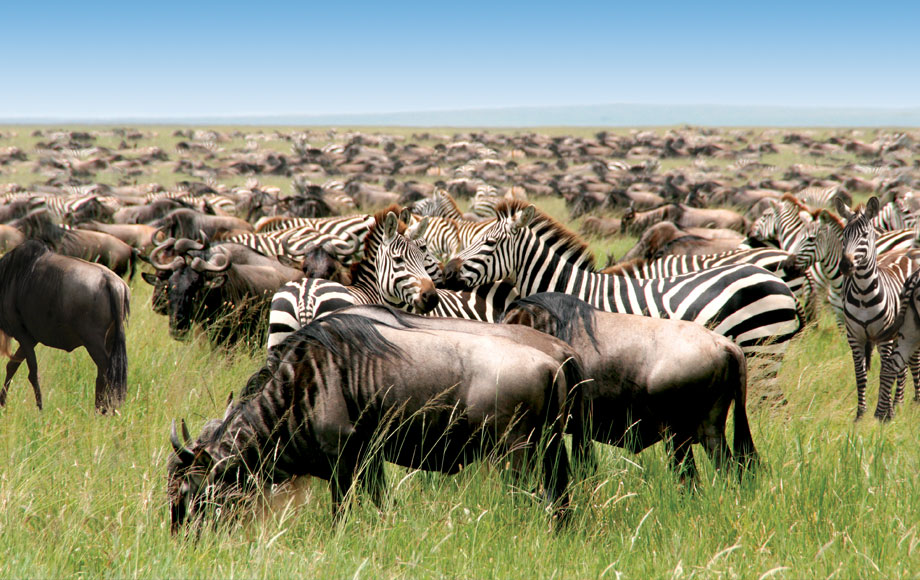
Why should I visit the Serengeti National Park?
- Tanzania’s most famous reserve
- Site of the annual wildebeest migration
- Plenty of permanent plains game
- Intense predator action
- Outstanding range of classic and luxury safari camps
- Maasai cultural experiences
- Opportunities to hot air balloon over the landscape
When is the best time to visit the Serengeti?
Tanzania is a true year-round safari destination. The wildebeest migration mass on the short grass plains of the southern and eastern Serengeti from November to May, moving towards the western corridor towards June as the rains finish. From July to September, the herds head north into Kenya’s Masai Mara. In October, the skies open once more so the animals return to the short grass plains.
If you plan to visit during the Great Migration, be sure to book early as our camps and lodges tend to fill up quickly in this period. For more information on when to visit Tanzania, please click here or feel free to call one of our passionate Destination Specialists who are always up for a chat.
Our Recommended
Serengeti sample itineraries.
The following itineraries are just some of the many experiences that we can design for you. All of our tours are private, independent and tailor-made to your personal travelling requirements. Please contact us to begin creating your personalised Tanzania experience.
Antiquities & Wildlife
Explore the antiquities of Africa on this 16 day tour to Tanzania and Egypt. Explore the Pyramids of Giza and Marvel at the mighty Shypnx
Gorillas, Serengeti Safari & Zanzibar
Encounter Rwanda's rare Mountain Gorillas and explore Tanzania's finest safari destinations before relaxing on the white sand beaches of exotic Zanzibar.
Tanzania Bush and Beach
Marvel at the incredible diversity of Tanzania combining the exotic island of Zanzibar, Ngorongoro Crater and the Serengeti, both abundant in wildlife.
Tanzania’s Northern Treasures
Experience three of Tanzania’s best known national parks and the country’s epic wildlife in Tarangire, Ngorongoro Crater and the celebrated Serengeti.
Recommended
Accommodation in the serengeti.
The following are some of the lodges and tented camps that we recommend in the Serengeti region. For information on additional accommodation not featured, please contact us.
Ubuntu Camp
Ubuntu Camp is a mobile tented camp that can be found in three locations throughout the year. It has just 7 simple yet sublimely comfortable suites under canvas with hot water bucket showers that
Singita Sasakwa Lodge
Singita Sasakwa Lodge is located in the unspoilt Grumeti Reserves in the northern Serengeti. It offers 10 private guest cottages with personal infinity pools, walking safaris and guided game drives.
Singita Sabora Tented Camp
Singita Sabora Tented Camp is a nostalgic 1920s explorer-style camp in the private Grumeti Reserves adjoining the Serengeti, with 9 romantic suites that lead out onto the plains.
Singita Mara River Tented Camp
Singita Mara River Tented Camp is an impossibly chic safari camp on the northern banks of the Mara River in Tanzania's famous Serengeti National Park.
Singita Faru Faru Lodge
Singita Faru Faru Lodge sits on a riverbank in a private reserve adjoining Tanzania's northern Serengeti. This sensational property has 9 premium suites, a fleet of Land Rovers for game drives
Serengeti Safari Camp
Serengeti Safari Camp follows the wildebeest herds as they move across the Serengeti plains throughout the year. To stay lightweight, it only offers 6 walk-in guest tents and a comfortable
Serengeti Bushtops
Serengeti Bushtops is an alluring safari camp in the Serengeti whose tented suites offer butler service and private hot tubs overlooking the open plains.
Sayari Camp
Sayari Camp offers 15 stunning tented guest suites, exceptional gameviewing on the plains of the northern Serengeti and easy access to the Mara River and its infamous croc-filled crossing points.
Roving Bushtops
Roving Bushtops is a unique collection of boxes on wheels comprised of 6 guest suites that can be towed anywhere in the Serengeti. This marvel of Swiss engineering presently sits in the game-rich
Olakira Camp
Olakira Camp has just 9 traditional safari tents with classic bucket showers. This outstanding mobile camp follows the wildebeest herds from north to south, to provide the best opportunities for
Namiri Plains
Situated in a little-visited, remarkably unspoilt corner of the Serengeti, Namiri Plains is where you’ll find some of East Africa’s best big cat sightings, from lion and leopard to cheetah.
Mwiba Lodge
Stunningly situated in a private 129,500-acre wildlife reserve bordering the southern Serengeti.
Mila Tented Camp
Offering perfect seclusion, this intimate tented camp is perched on a ridgeline of granite kopjes in Tanzania’s southwest Serengeti.
Migrational Camps
Follow the annual wildebeest and zebra migration at the exclusive Migrational Camps; Nyasi and Songa – that move between the Serengeti’s south and north.
Lemala Ndutu Tented Camp
Lemala Ndutu is a seasonal camp with 12 guest suites that offers terrific gameviewing and the Serengeti's wildebeest migration far from the crowds.
Lemala Nanyukie Tented Lodge
Situated in the eastern section of the Serengeti National Park Lemala Nanyukie encapsulates the same excellent standard of comfort and service as the other luxury properties in the Lemala Collection.
Lemala Mara Tented Camp
Lemala Mara is a seasonal mobile tented camp in the northern Serengeti where herds of wildebeest cross the croc-filled Mara River between June and October.
Lemala Kuria Hills
Lemala Kuria Hills is a luxury lodge located near the Mara River in the northern Serengeti and features 15 lavish, glass-fronted guest tents offering unrivalled views over the Serengeti plains.
Lemala Ewanjan Tented Camp
Lemala Ewanjan Tented Camp is set in the peaceful Seronera Valley in the game-rich Central Serengeti. It offers 12 beautiful guest tents and amazing big cat viewing opportunities.
Lamai Serengeti
Lamai Serengeti is a small 12-suite safari lodge spread across a rocky, scrub-covered hillside in the remote northern Serengeti. During certain months of the year, the surroundings teem with
Kimondo Camp
Kimondo Camp is a fabulous mobile safari camp that follows the wildebeest herds from the Mara River in the north to the lush, golden grasslands of the Serengeti in the south.
Intimate Places Camping
Highly awarded Intimate Places Camping is designed for travellers who wish to immerse themselves in the wilderness almost anywhere on the northern Tanzania's safari circuit without sacrificing on
Dunia Camp is a semi-permanent camp set in a secluded valley where the migrating wildebeest herds pass twice a year. It has 8 simple yet very comfortable suites with bucket showers overlooking
Camp Zebra is a small, semi-permanent camp that follows the wildebeest as they move across the Serengeti. There are 6 comfortable guest tents in total, with activities centred around the Great
andBeyond Serengeti Under Canvas
andBeyond Serengeti Under Canvas offers the ultimate luxury camping experience. Expect chandeliers, crystal and silverware as you follow the Great Migration.
andBeyond Klein’s Camp
Luxurious and exclusive andBeyond Klein's Camp offers an unbeatable location between two of East Africa's finest wildlife reserves: the Masai Mara and Serengeti.
andBeyond Grumeti Serengeti Tented Camp
andBeyond Grumeti Serengeti Tented Camp is set in the Serengeti's remote Western Corridor, renowned for incredible year-round wildlife and seasonal migration viewing.
Find out more about our tailor made African safaris. Get in touch with one of our Destination Specialists.
Subscribe below to keep up to date, find out more about our tailor made african safaris, related stories, tanzania faq, can i see the big 5 in tanzania.
Tanzania is home to all members of the legendary ‘Big 5’: lion, leopard, elephant, rhino and buffalo. All apart from rhino, plus many other species, can be seen in Tanzania’s best game areas. The Ngorongoro Crater is the best place for seeing endangered black rhino, as they can’t move from the crater floor. Please note that the seasons, rainfall and drought can affect game movements. Our knowledgeable Destination Specialists know the best time of year to visit and where to see particular game species.
When is the best time to see the Great Migration?
The great wildebeest and zebra migration is a natural event and therefore their exact location can never be 100% predicted. The wildebeest mass in certain areas of the Serengeti Ecosystem (made up of the Serengeti National Park, Ngorongoro Conservation area and Kenya’s Masai Mara) at different times of the year. The below map shows historically, where the wildebeest and zebra will be, based on the time of year. If you are interested in learning more, or in seeing the Great Migration please contact one of our staff who are always happy to chat.
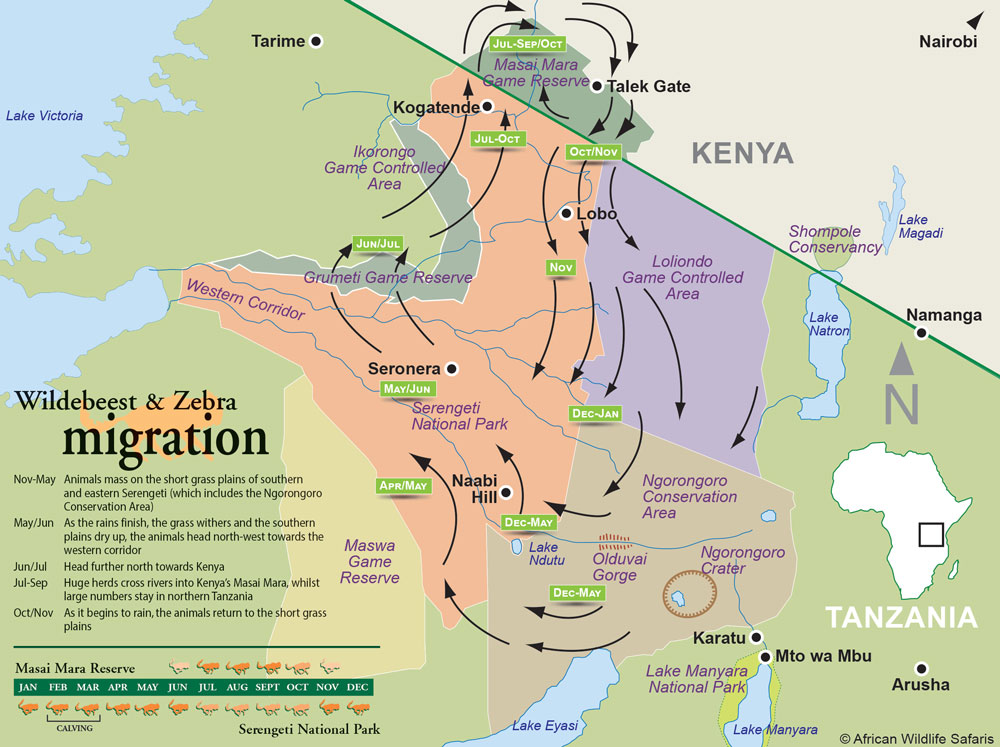
More of Tanzania
E-newsletter.
Sign up to receive updates about exciting journeys, special offers and more

- Safari ideas
- Experiences
- Special offers
- Accommodation
- Start planning
- Booking terms
- When to go on safari - month by month
- East or Southern Africa safari?
- Solo travellers
- Women on safari
- Accommodation types & luxury levels
- General tips & advice
- All stories
- Afrika Odyssey Expedition
- Photographer of the Year
- Read on our app
- 2024 entries
- 2024 details
- 2024 prizes
- 2024 entry form
- 2023 winners
- Collar a lion
- Save a pangolin
- Rules of engagement
- Job vacancies
- Ukuri - safari camps
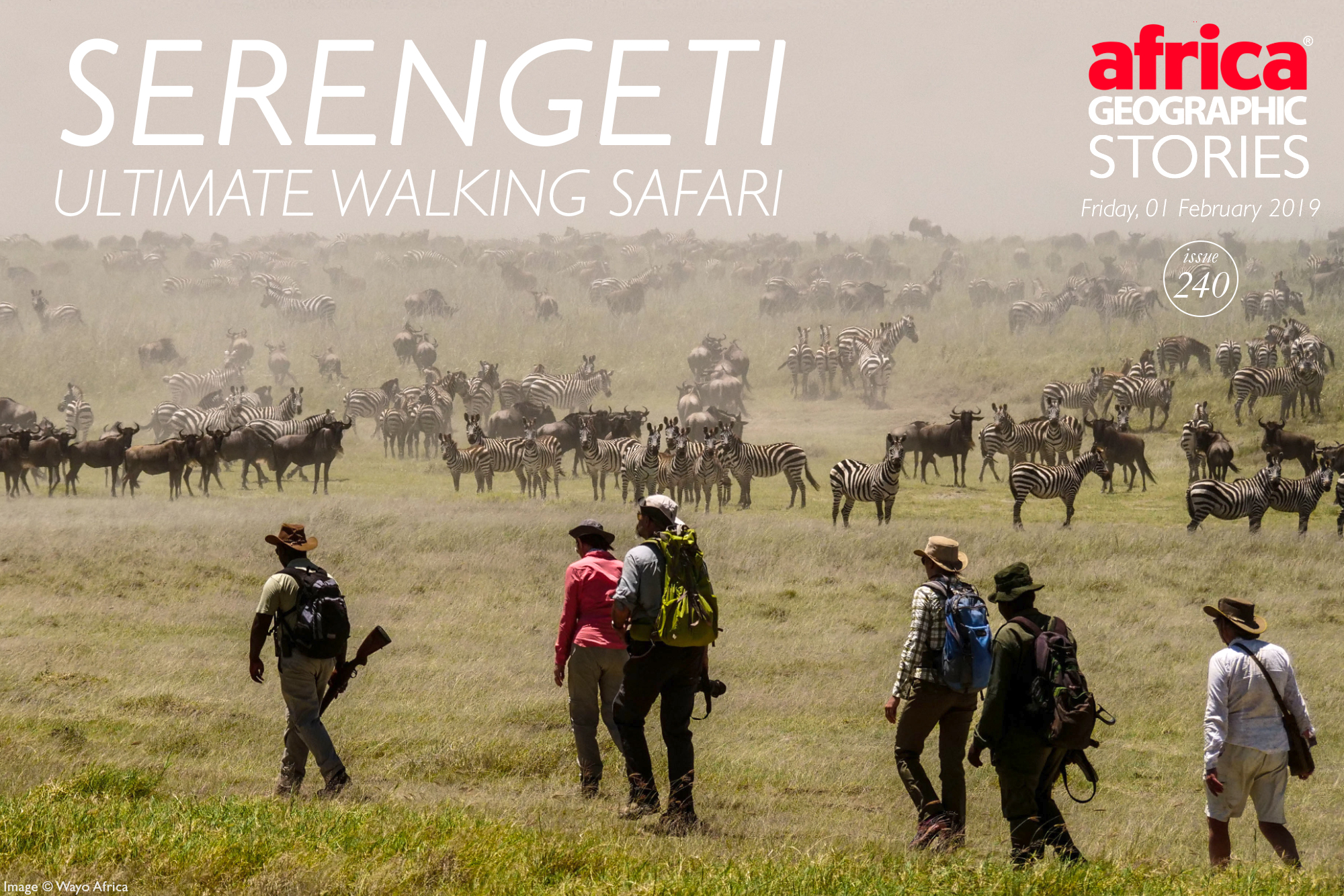
Walking through a wild paradise

Simon Espley
Friday, 01 February 2019

“Listen”, says Jean, cupping his ears and staring at the distant horizon. I listened. Nothing, except for that constant muuuuuh muuuuh? muuuuh coming from the wildebeest herds dotted around us, and the constant buzz of birds and insects. Still I listened. Nothing. I looked at him and raised a quizzical eyebrow.
“Exactly”, he said.
You see, the Serengeti can be pretty busy during the Great Wildebeest Migration season, and yet we had been on safari for days without hearing a vehicle, or seeing another soul. This was no private concession; we were in Serengeti National Park. On one occasion, we had watched a pride of lions hunting a herd of cranky old male buffaloes (more about this later) – no other tourists present, despite this being prime tourism season. Huh?

It turns out that the Serengeti is VAST, and there are massive swathes of wilderness that are far away from the roads, and therefore see no tourism traffic. I have seen this during several flights over the Serengeti over the years – miles and miles of open savannah dotted with rocky kopjes and woodland, and rivers snaking through – but no roads or tourists in sight.
I was on a walking and fly-camping safari in these Serengeti wilderness areas. Heaven on Earth. When I say ‘fly-camping’, I don’t mean dig your own pit latrine, divine water and find food. I mean comfortable, rustic tented camps that are either seasonal (timed according to the migration movements) or they are set up specifically for your walking safari. And there is a team behind the scenes to cater to your needs while you make the most of being in paradise.

One late morning, after walking since sunrise, the rising heat and aching feet drove us to a huge fig tree clawing out a living on a rocky kopje with views across the simmering savannah. We clambered up the rocks, to find chicken wraps, chocolate brownies, cool drinks and mattresses set out in the cool shade. Say no more.
Four hours of feasting and snoozing later, we walked the last hour to our camp for the night. It was just us on that rock, with regular visits from white-headed barbets and Fischer’s lovebirds as they plundered the ripe figs overhead. Some in our party spent that time reading books or Kindles, some chatted quietly, and others like me simply hit the snooze button. Could life be better?

About those lions. So, we were walking across a slope overlooking a riverine drainage line below us, when we first heard their faint grunted contact calls. Then we saw a few svelte lionesses slinking through the dense riverine shrubs, totally focused on the hunt. We sat in the shade of a small tree a few hundred metres away and waited for the drama to unfold. The lionesses ignored us like we were wallpaper, though they did glance at us now and then, possibly to make sure we would not spoil the hunt. Sharp eyes amongst us picked up the dark shapes of several huge male buffaloes lurking amongst the shrubs, seemingly oblivious to the advancing threat. We held our collective breaths.
Suddenly the silence was broken as the buff boys picked up the scent of the lions and got the hell out of there, joined by several others that we had not realised were mud-wallowing a short distance away. The cantankerous buggers made their indignant departure (happily in the opposite direction to us) amidst snorts, farts and bellows. And the lions simply vanished. Gone.
An hour later, while walking up a small valley that would crest with a view over our next camp, we gaped in wonderment at the sheer number of animals just across the valley, a few hundred metres away – good numbers of elephant, giraffe, zebra, wildebeest, topi, hartebeest and warthog. In fact, I cannot remember one time during the 5-day walking safari that we could not see or hear large numbers of animals all around us. At times when walking across the flat grassy savanna, the herds of wildebeest and zebras seemed to part ahead of us and reform behind us, like a magnetic force field.

One morning I was enjoying a quiet moment alone on the fringes of the camp, mug of coffee in hand and watching a stunning red-cheeked cordon-bleu waxbill scratch around for grass seeds when a daring side-striped jackal appeared out of nowhere and dived into the grass 10 metres from me. He emerged with a tiny Thomson’s gazelle fawn in his mouth, and headed off, dragging the screaming young thing with him. In a flash, the fawn’s mom appeared and attacked the jackal with diminutive determination. After a few head-butts in the rear-end (those sharp little horns must have hurt), the jackal dropped his intended breakfast and ran for the hills. Mom quickly escorted her kid away, shaken but not stirred.
Life on a walking safari is made of these moments of magic, these packets of exhilaration and solitude. This is the “slow safari”, the true essence of journeying.
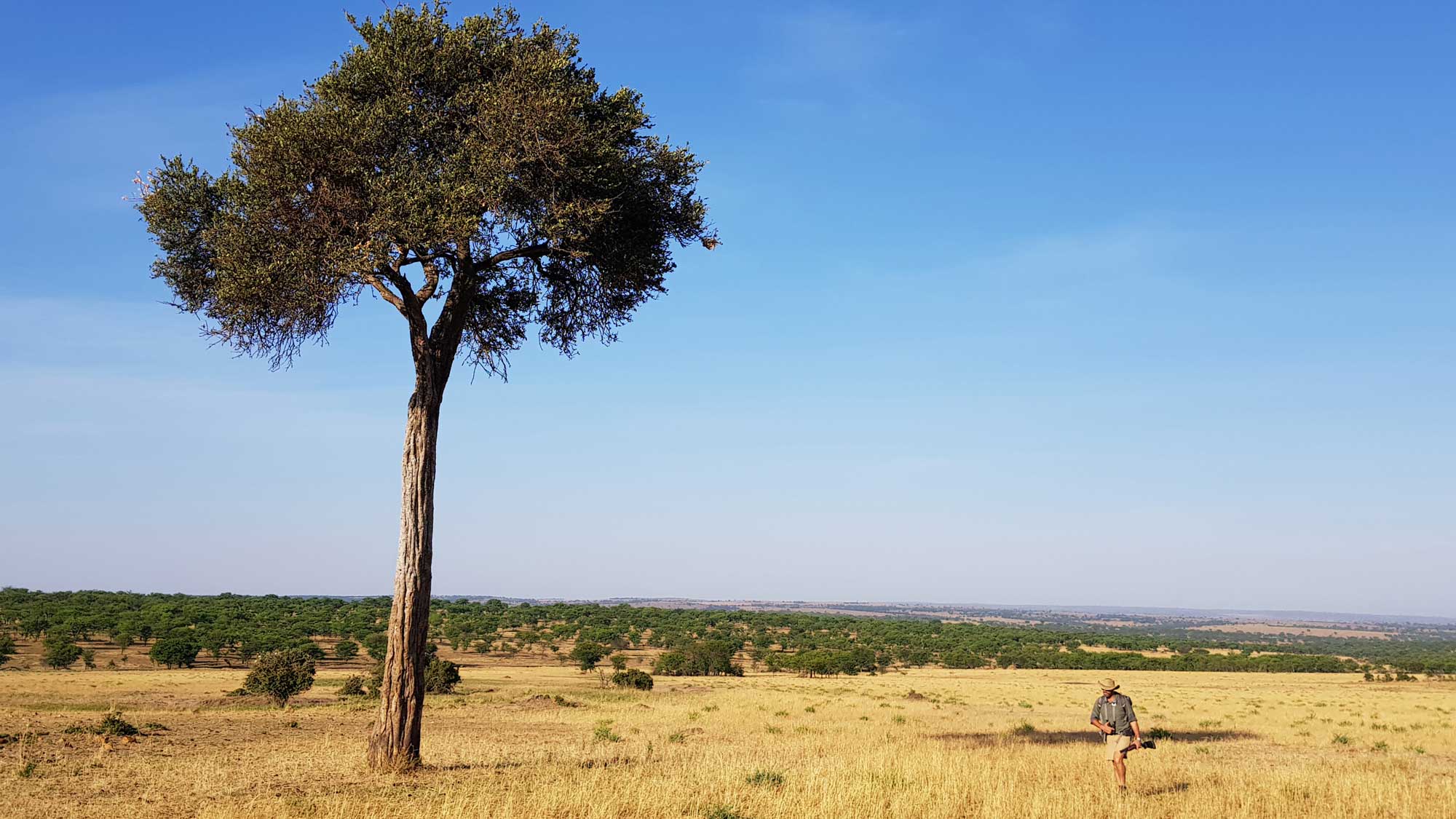
Who should do a Serengeti walking safari
These walking safaris are not the brief mid-morning stroll after your game drive, offered by many traditional safari lodges. Instead, the goal is to cover a good amount of ground and to explore the vastness beyond the usual tourist haunts. And so, you should be prepared to spend most of each morning walking, and possibly part of each afternoon. The pace is slow, and the terrain easy, but you should be walking fit.
This is not a route march, so every excuse to stop is taken – from bird-watching to wondering at a spider packing up her dew-drenched web after a night of hunting. And watching lions hunt buffaloes.
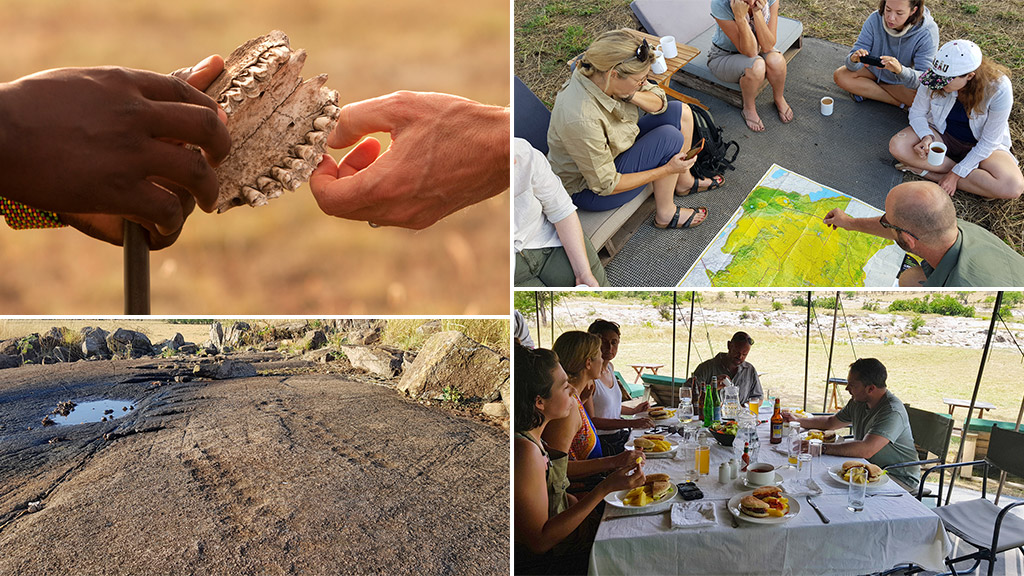
You will carry your water and personal items for that walk, but of course, your kit bag and heavier items are left in camp, to be transported to the next camp location. Blisters are the norm, and you will get hot and uncomfortable at times. And did I mention the tsetse flies?
There is a game-drive vehicle-based at camp, and so game drives are possible during walking safaris – but the true essence of walking safaris is to, well, walk. Indeed, Serengeti walking safaris are for those who want more than the traditional lodge and game drive arrangement. That said, a combo of the two is just perfect. After this fantastic soul-food walking safari, I headed off to enjoy a more traditional lodge-based safari , also in the Serengeti. Which did I prefer? That is like asking whether you prefer the main course or dessert. The question is what you want, versus what you need. The answer lies within you…
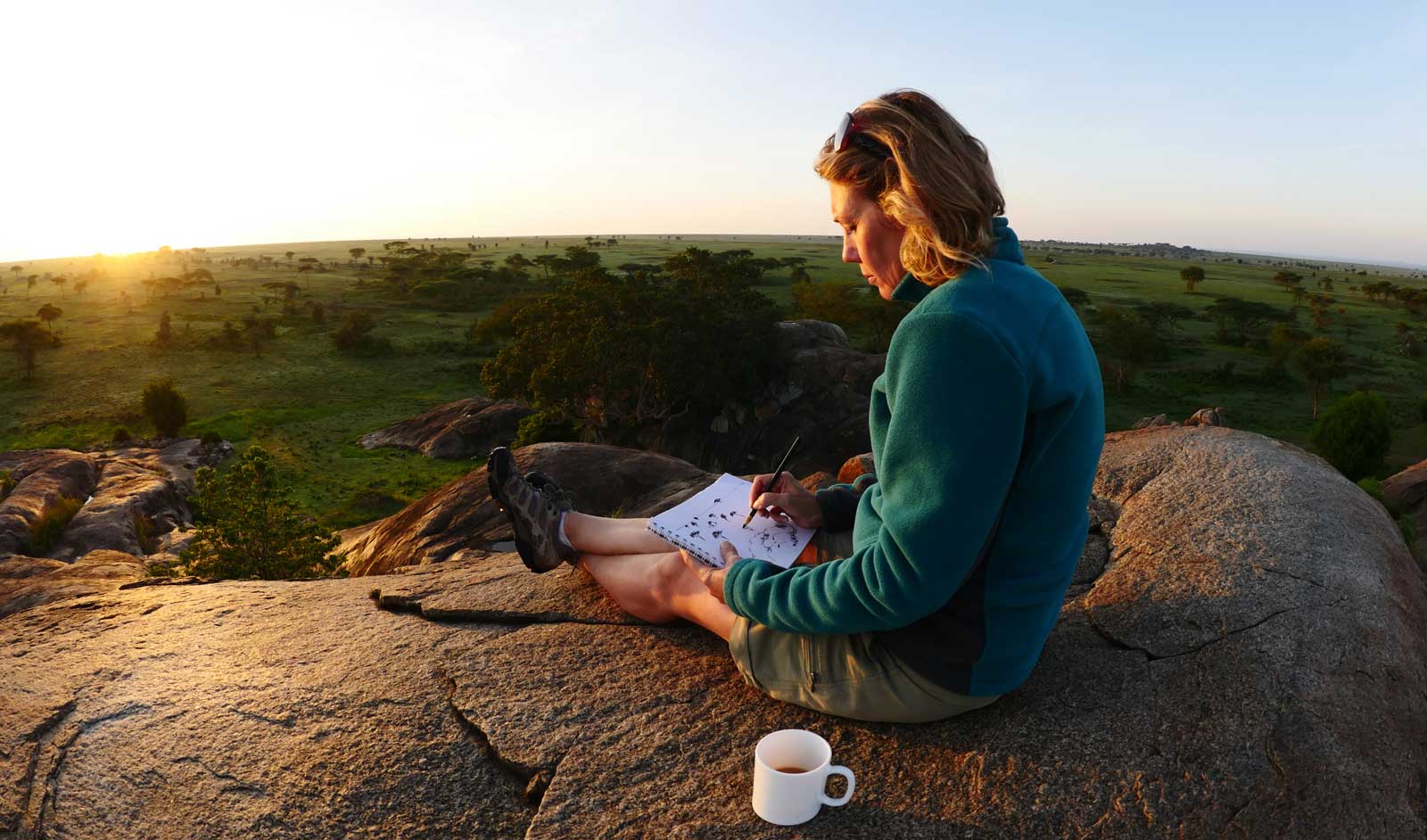
Serengeti National Park , in northern Tanzania, comprises of almost 15,000 km² of predominantly rolling grasslands, savannah, riverine forest and woodlands. This vast landscape forms part of the unfenced Mara-Serengeti ecosystem that spans Kenya and Tanzania and plays host to the Great Wildebeest Migration and offers regular sightings of the Big Five (lion, leopard, elephant, buffalo and rhino) as well as zebras, crocodiles, hippos, giraffes, various antelope species and good populations of cheetahs and hyenas, as well as smaller species such as serval and bat-eared fox.
The name Serengeti is derived from the Maa word siringet , which refers to a “place where the land runs forever.”
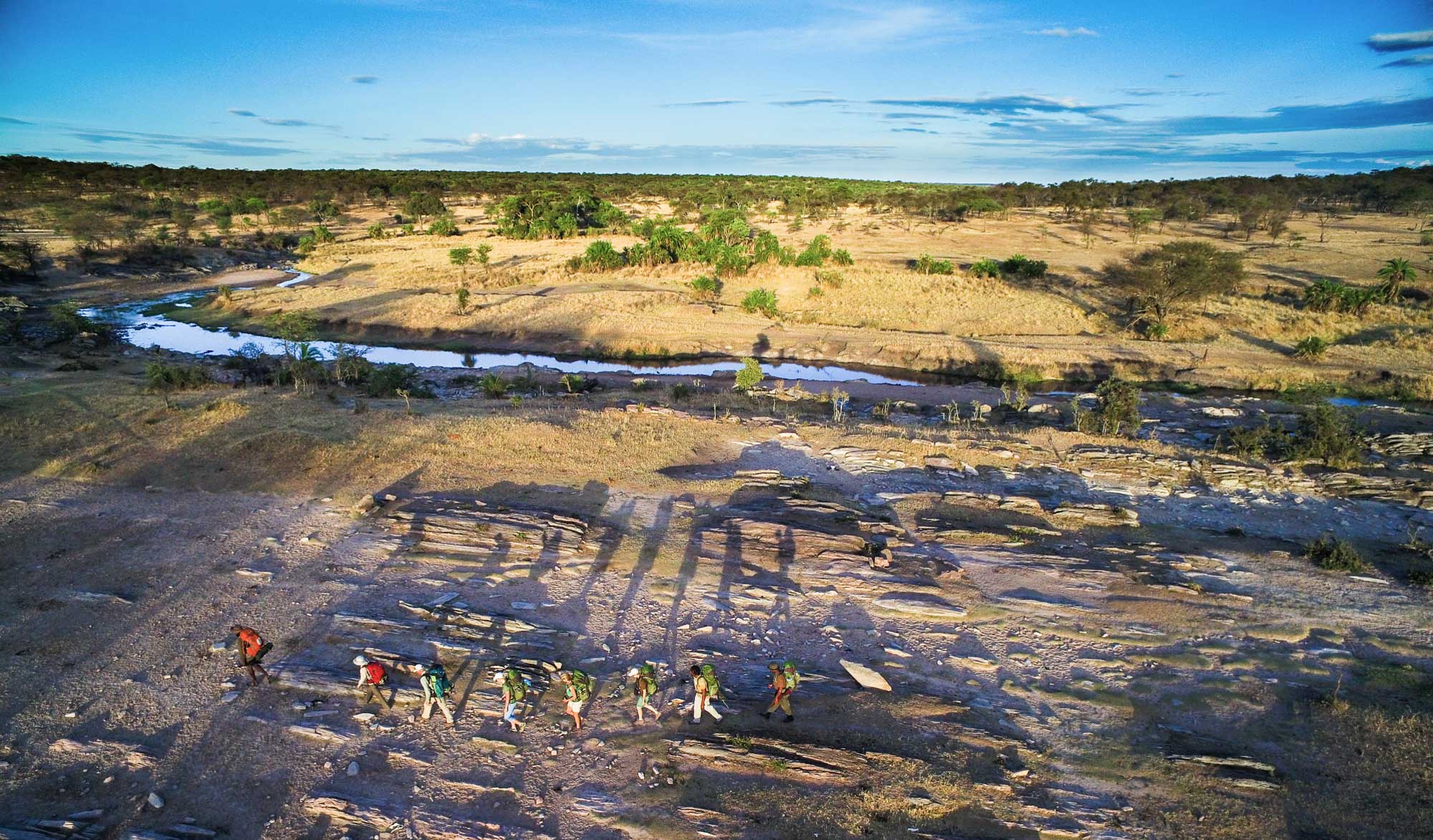
Where to stay
Simon was a guest of Wayo Africa , who offer several activities across northern Tanzania, from canoeing to biking and walking. Using expert guides and unique access, they focus on remote areas within the iconic Serengeti, Ngorongoro, Lake Manyara and Arusha regions. With only 30% of the Serengeti currently accessed by tourists, they prefer to operate in the unexplored regions of the park, from their various permanent and mobile camps that are located seasonally to either follow the Great Wildebeest Migration or to cater to specific client requests. The camps are simple and very comfortable, evoking a feeling of adventure – from a bygone safari era. They are termed “green camps” because every effort is made to tread lightly – making use of solar power, gathered rainwater and compostable toilets.
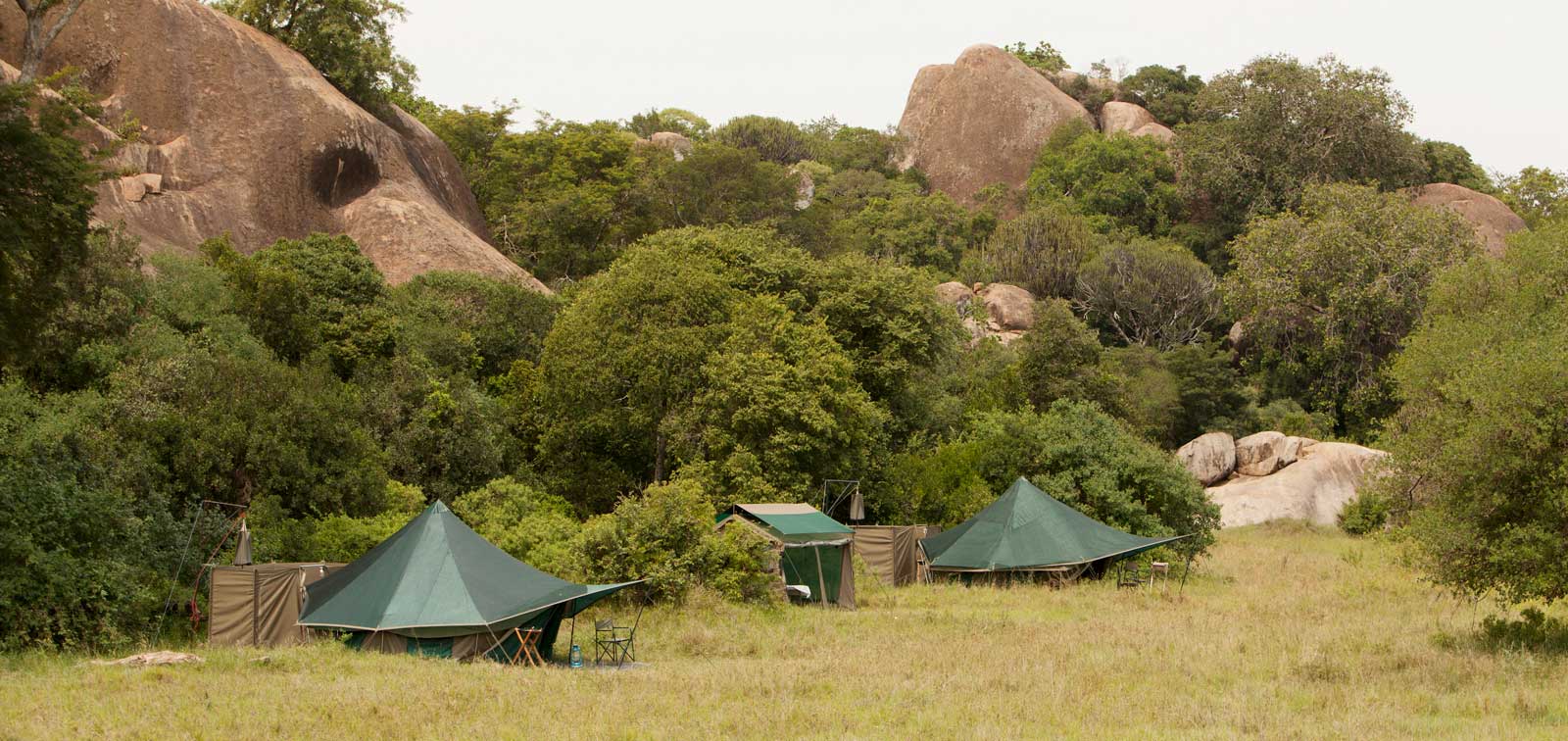
The three camps range from ‘classic’ camps (canvas bell tents) to ‘walking’ camps (canvas dome tents) and ‘trekking’ camps (ultra-lightweight nylon tents).
Naabi Green Camp is located under a stand of large Acacia tortilis trees in a beautiful quiet area at the foot of the giant Nabi rocky kopje in the southern Serengeti short grass plains, south of the prime Seronera area and close to the Ngorongoro Conservation Area. The camp is open from December to March each year, to catch the Great Wildebeest Migration as it moves through this area, but also well-placed to be able to head further south, west or north to wherever the migration is moving.
Trekking Safari Camp and Serengeti Walking Camp provide access to remote parts of the Serengeti, following the migrating herds. The lightweight mobile camps have comfortable mattresses and mosquito mesh sides/tops.
For camps & lodges at the best prices and our famous ready-made safari packages, log into our app . If you do not yet have our app see the instructions below this story.
ABOUT THE AUTHOR, SIMON ESPLEY
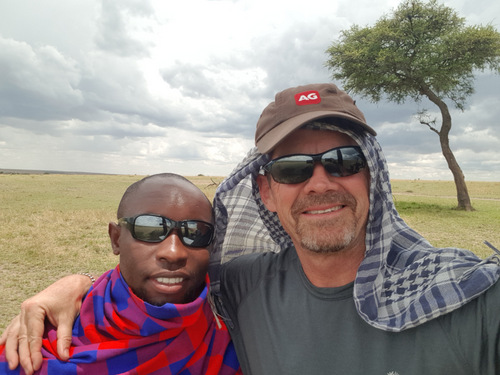
HOW TO GET THE MOST OUT OF AFRICA GEOGRAPHIC:
- Travel with us . Travel in Africa is about knowing when and where to go, and with whom. A few weeks too early / late and a few kilometres off course and you could miss the greatest show on Earth. And wouldn’t that be a pity? Browse our ready-made packages or answer a few questions to start planning your dream safari .
- Subscribe to our FREE newsletter / download our FREE app to enjoy the following benefits.
- Plan your safaris in remote parks protected by African Parks via our sister company https://ukuri.travel/ - safari camps for responsible travellers
We're an eclectic pack of safari experts, storytellers, admin and tech nerds and digital natives whose sole mission is celebrating Africa and doing good. We do this by creating life-changing, responsible safaris just for you, publishing informative, factual articles about Africa's incredible natural wonders and raising donations for worthy causes. This MANIFESTO explains our approach to travel and conservation.
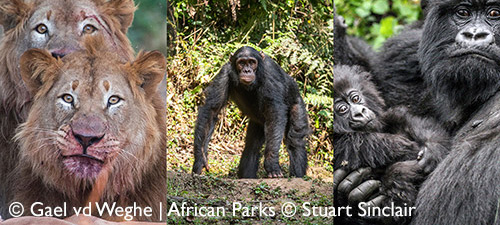
Friend's Email Address
Your Email Address
- Click here to WhatsApp us!
- [email protected]

- All Types Beach & Safari Holiday Classic Drive Safari Drive & Fly-Back Safari Fly-in & Drive Round Trip Fly-in Safari Serengeti
- All Durations 1 – 3 Days 10 – 12 Days 13 – 15 Days 4 – 6 Days 7 – 9 Days
- All Prices 0 – 500 USD 1600 – 2500 USD 2300 – 3500 USD 3000 – 4000 USD 500 – 1000 USD 900 – 2000 USD
Welcome to Africa Safari South Serengeti
Lake ndutu - ngorongoro conservation area, stay connected in the bush all lodges now offer free wifi internet.
Africa Safari South Serengeti is a comfortable accommodation, located in the Ngorongoro Conservation Area and offers easy access to the crater, while at the same time being on the south side of Lake Ndutu, which is in the Serengeti National Park. The best of both worlds! The nearby airstrip offers connections to the other major airstrips and airports. The area is famous for the calving season of the Great Migration, an absolute highlight of the annual wildebeest migration. The short rains in November and December provide nutritious pastures for the wildebeest, which stay in the area until the end of the long rains. Most calves are born in January and February. The open grassy plains offer them some safety, but these young wildebeest attract hungry predators, such as lions, leopards, cheetahs and hyenas. Between April and November, the south-eastern plains dry out, but there is still an abundance of game in the area. There are in fact two water sources, Lake Masek and Lake Ndutu, where many wild animals come to drink. The 15 accommodations (9 Safari Comfort and 6 Luxury Glamping) form two wings with a restaurant tent and a bar/lounge tent in the middle. The classic safari tents are fully furnished with locally made furniture and have an en suite bathroom. There are also 5 Safari Tents available, with a shared toilet and shower.
Throughout the year there is an abundance of wildlife in the area, which makes it perfect for game drives.
If you are looking for a Safari Accommodation close to Lake Ndutu, famous for the Great Migration of the wildebeest, then you found the right place!
Welcome to Tanzania, famous for the it’s culture, the Wildlife, Nature, Safaris and the Great Migration!
Explore our very unique africa safari accommodations., relax in style in a beautiful environment close to lake ndutu, the accommodation is nicely decorated in traditional african style., safari luxury glamping.
The Safari Luxury Glamping Accommodation is a canvas accommodation where you will find all the luxury you need inside, and a view of the beautiful environment of Lake Ndutu outside. The room is furnished with a king-size bed and a single bed, a seating area inside and outside. In the bathroom you will find a walk-in shower, European toilet and a washbasin. An extra single bed can be placed on request.
There are 6 rooms available.
Facilities:
- King-size bed (180 x 200) and single bed (90 x 200)
- Quality mattress and bed linen
- Fully equipped bathroom with walk-in shower
- Mosquito net
- Private location
- Inside seating area
- Charging points for mobile phones and cameras
SAFARI COMFORT
Get the feeling of being very close to nature while sleeping under a canvas in the incredible environment of South Serengeti. The accommodation has its own private 8 m2 terrace with a comfortable seating area. Take in the incredible views, you might even see an elephant or giraffe walking by. The room is 32 m2 and is furnished with a king-sized bed and a single bed. The room is furnished with locally made furniture. You will find an ensuite bathroom which is separated from the room by a tent cloth, with a shower, European toilet and sink.
There are 9 rooms available.
- Maximum occupancy 3 guests
- Double bed (180 x 200) and a single bed (90 x 200)
- Inside and outside seating area
- Fully equipped bathroom
- Standing fan
SAFARI TENT
Get back to basics, in a comfortable way. Stay overnight in a Safari Tent in South Serengeti, surrounded by beautiful nature. The Safari Tent is located close to the restaurant and bar-lounge tents. Furnished with 2 comfortable single beds, and a nice and comfortable seating area outside the tent.
There are 5 tents available.
- Shared toilet and (hot water) shower facilities
- Close to the restaurant and bar
- Very suitable for overland trucks, budget groups and backpackers
- In the middle between Serengeti National Park and the Ngorongoro Crater
- Different possibilities/areas for game drives
- Home to the Great Migration Calving Season
- Sleeping under canvas
- WIFI by satellite Solar heated water
- 1 km from Lake Ndutu
- 3 km from Lake Ndutu airstrip
- Abundant bird life
- Famous area because of researchers Jane Goodall, Hugo van Lawick and Mary Leakey
- Reception area
- Bar and lounge tent
- Restaurant Tent
- Safari Comfort Accommodation
- Safari Luxury Glamping Accommodation
- Safari Tents with shared toilets and shower
- Free WIFI in restaurant and bar
- Electricity on solar energy and generator
- Water heated by solar energy
- 24-hrs security
- Open four-wheel-drive or safari
- Jeep with pop-up roof for hire (no self-drive) on request
- Download our Easter planning
- Breakfast Menu
- Festive Seasons Menu
Along the shores of Lake Ndutu
When you are on your way from the Serengeti to the Ngorongoro Crater/ Lake Manyara or vice versa, you will pass the Ndutu area. From the border of Serengeti National Park/Ngorongoro Conservation Area it is only a 32 km drive, to Africa Safari South Serengeti close to Lake Ndutu, through a landscape full of Acacia trees.
GPS: 3°01'40.0" S 34°58'45.0"
E -3.027778, 34.979167 Wildlife Areas:
- Serengeti National Park
- Serengeti North & Mara River
- Serengeti Central/ Seronera Area
- Ngorongoro Crater
Matiti Plains
The Matiti Plains is the main plain where the wildebeest calf from January to March. The Serengeti Twin Hills overlook this plain. This is where the pregnant wildebeest gather; open terrain and unobstructed views. Newborn calves can be on their feet within 7 minutes. They have to, because this area is also home to cheetahs and other big cats, which means lots of interaction between prey and predator.
The Gol Kopjes offer some of the best game viewing in Africa during the green season. This area has the highest concentration of cheetahs in Africa. Hundreds of tracks criss-cross the world-famous Gol Kopjes complex and the photographic opportunities are endless. With a little patience, there is a good chance of seeing a cheetah reach high speeds while chasing its prey.
The Triangle
With no permanent water source, much of the wildlife here can only survive during the green season. This is when the Triangle is a fantastic feeding ground with nutritious short grass for a staggering number of migrating herbivores, including wildebeest, zebra, gazelle and the large and small predators that follow the migrating herds. Later in the season, the area dries out and the grass withers, making it less attractive to wildlife.
Explore our Safari Itineraries to see which safari package includes one or more overnight stays in Africa Safari South Serengeti, and which suits your needs best. You can also contact our Sales Department who will be more than happy to help. It is also possible to book a tailor made safari holiday.
Extend your safari holiday with a beach holiday on Zanzibar or book a Beach & Safari Holiday .
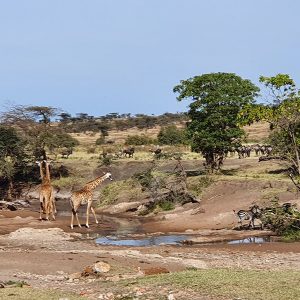
The Paradise & Wilderness Foundation was founded with the mission to give back to the communities in which we operate. We strongly believe in supporting the local communities by initiating community projects that are located close to all our accommodations.
Our dream is to make a social and environmental impact on the communities where we operate. That's why we initiated community projects near all our accommodations, including schools, local hospitality businesses, and environmental initiatives. We strive to promote sustainable tourism that benefits both the local people and the environment.
Customer Reviews
We are here to help you, we are here to help you.
Contact us, we’ll be glad to answer your questions
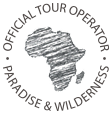
DISCOVER OUR ACCOMMODATIONS IN TANZANIA
Discover our resort and lodges in zanzibar and tanzania located close to the famous national parks hover with your mouse over the pins on the map, to learn more about the accommodations..
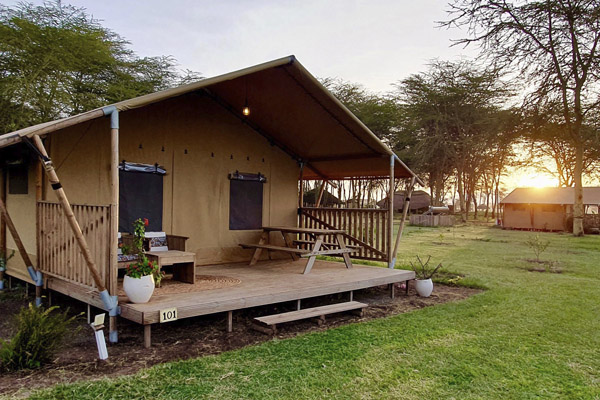
AFRICA SAFARI LAKE MANYARA
Located between the foothills of Ngorongoro crater and Lake Manyara
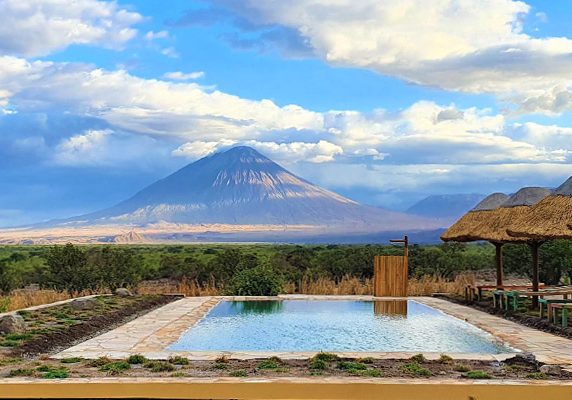
AFRICA SAFARI LAKE NATRON
A luxury safari lodge, accessible to the Northern Circuit National parks
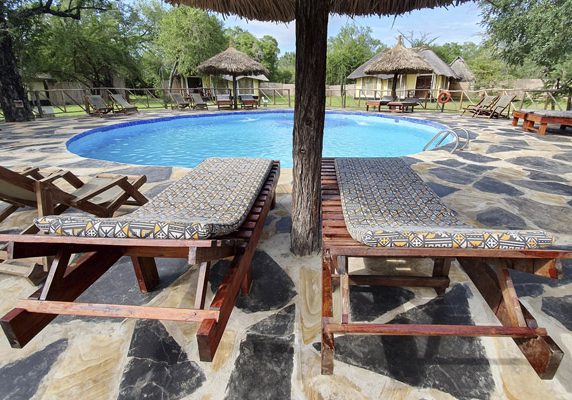
AFRICA SAFARI SELOUS
Situated just outside the Selous GR (Nyerere National Park) in southern Tanzania

AFRICA SAFARI ARUSHA
Placed in a quiet environment, offering comfortable accommodation

Africa Safari Maasai Boma
Unique accommodation, not only because of its ideal location, but also due to its design.
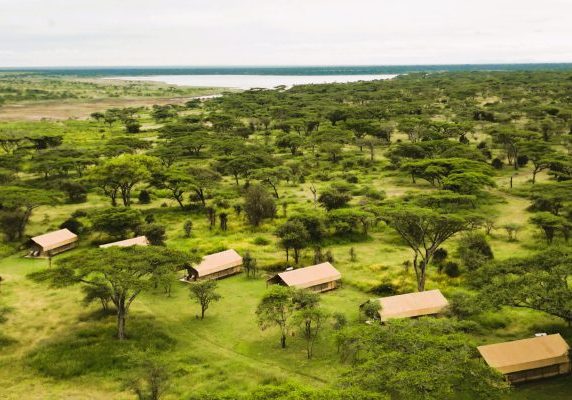
Africa Safari South Serengeti
The ideal place to stay between Serengeti National Park and Ngorongoro Crater.
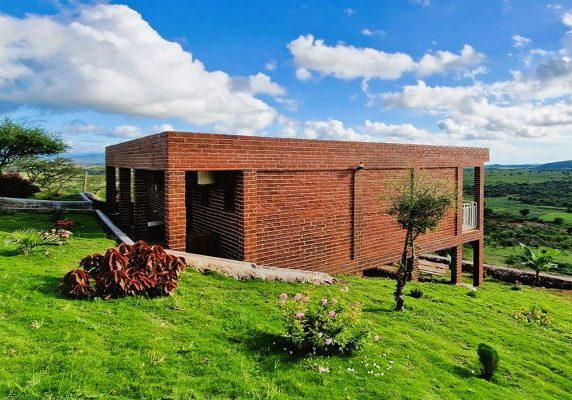
AFRICA SAFARI KARATU
A luxury safari lodge located on the edge of the Ngorongoro Conservation Area, offering a 180-degree view of the Ngorongoro Highlands.
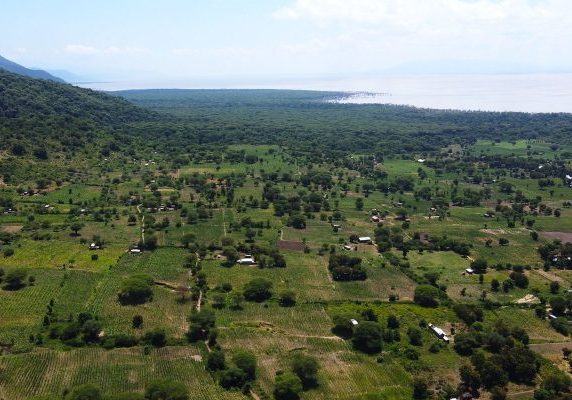
AFRICA SAFARI RIFT VALLEY
Located on the south of Lake Manyara with the famous Great Rift Valley as its surroundings. Opening on December 20th, 2023.
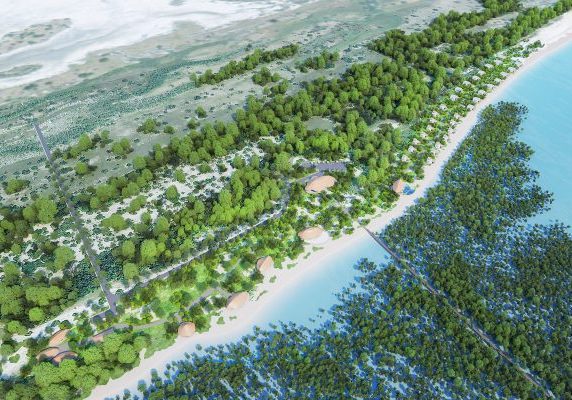
Africa Safari Saadani
Nestled at the edge of Saadani National Park, Africa Safari Saadani combines wild encounters with serene relaxation. Opening in 2025
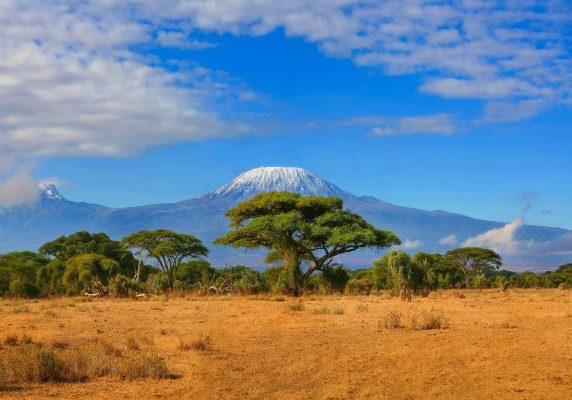
Africa Safari Kilimanjaro
Located close to Kilimanjaro International Airport. A comfortable and convenient lodge for when arriving in Tanzania for a safari adventure of a lifetime or preparing to conquer the iconic Kilimanjaro. Opening in 2025

Africa Safari Nyerere
A luxury safari lodge located right next to Nyerere National Park, the perfect place to rest after your safari adventures. Opening in November 2024

Africa Safari Serengeti Kusini
A comfortable accommodation located in Southern Serengeti National Park, a famous location during the Calving Season.
Privacy settings
With the slider, you can enable or disable different types of cookies:
This website will, this website won't.
- Essential: Remember your cookie permission setting
- Essential: Allow session cookies
- Essential: Gather information you input into a contact forms newsletter and other forms across all pages
- Essential: Keep track of what you input in a shopping cart
- Essential: Authenticate that you are logged into your user account
- Essential: Remember language version you selected
- Remember your login details
- Functionality: Remember social media settings
- Functionality: Remember selected region and country
- Analytics: Keep track of your visited pages and interaction taken
- Analytics: Keep track about your location and region based on your IP number
- Analytics: Keep track of the time spent on each page
- Analytics: Increase the data quality of the statistics functions
- Advertising: Tailor information and advertising to your interests based on e.g. the content you have visited before. (Currently we do not use targeting or targeting cookies)
- Advertising: Gather personally identifiable information such as name and location

Africa Safari Trip: A Comprehensive Guide To Crafting Unforgettable Memories
H ave you witnessed a lion’s roar echo across the savanna or watched a herd of elephants lumber by? An Africa safari trip is an otherworldly experience, but where do you even begin? This guide will equip you with all the essentials to plan your unforgettable adventure . Even though it can seem overwhelming at times, if you’re equipped with the right guidance and information, the procedure is rather easy.
To help you plan the perfect safari tour in Africa, in addition to answering the majority of your frequently asked questions, we’re put together some of the greatest tips and useful suggestions.
Choosing the Location of Your African Safari Trip
An Africa safari trip promises an enchanted world of discovery, where each expedition and place holds the potential to reveal a captivating tale. Every area of this enormous continent, from the lush deltas of the south to the brilliant savannahs of the east, offers a different fabric of fauna and culture. This is more than just a journey—it’s an exploration of the core of nature, where opportunity abounds at every turn.
African safaris are unique among travel experiences because of the authentic, natural spectacle of the wild. These excursions aim to fully immerse you in the world of animals, not just observe them. Planning your destination is among the most crucial aspects of preparation for any holiday, including this one. Africa is vast, so it’d be helpful to start with a “where to go on an Africa safari trip” Google search if you have no idea what to do.
To select the ideal safari destination, you must consider the things you wish to see. Are there any specific animals or cultural events you would like to see? Kenya and Tanzania from July to October are your best choices if you’ve always wanted to see the Great Wildebeest Migration. Visit either Botswana or South Africa to see a huge herd of African elephants throughout the year.
In East Africa and the majority of Southern African nations, the “Big Five” are also widely distributed. Travel to Uganda, Rwanda or the Congo for gorilla trekking; these countries are all in Central Africa. If you want to see chimpanzees on your Africa safari tour, Uganda is the ideal place to do it.
Top 5 Choice Destinations for Your Africa Safari Trip
Here are our top five African wildlife safari destinations to help you plan your trip.
Kenya’s Maasai Mara National Reserve
At the Maasai Mara Reserves, the Big Five roam free, and boundless plains extend into the horizon on a wildlife safari. Traveling off-road and appreciating the lack of fences and lodging at any of the Mara conservation areas allows you to experience the breathtaking sight of countless wildebeests roaring across the East African savanna around the Great Migration.
From open safari vehicles, watch as lions hunt their prey with unparalleled subtlety. Elephants socialize within their close-knit groups, and elegant giraffes peruse acacia trees with grace. A fascinating insight into the Maasai people’s dynamic local culture, which is entwined with the land, its profusion of wildlife, and the natural beauties of the wildness itself, is provided by Maasai Mara.
Tanzania’s Serengeti National Park
Tanzania’s Serengeti National Park is home to a large environment that is brimming with life. See the boundless plains packed with antelopes, zebras, and wildebeests as they migrate in a never-ending dance of survival throughout your Africa safari trip. It’s what you anticipate seeing on game drives following your viewing of National Geographic or PBS programs. You might be amazed watching the big cats lounging in the shade following a good hunt, or you might experience the exhilaration of seeing a cheetah racing across the landscape in a flurry of speed.
There are other methods to observe wildlife, such as taking a hot-air balloon flight across the savanna for breath-inspiring, all-encompassing views of this iconic African terrain. Seasonality is essential when thinking about visiting the Serengeti; never schedule an unplanned online vacation.
Zambia’s South Luangwa National Park
You can feel the African wilderness in Zambia, not just see it. In contrast to safaris that are limited to metal enclosures, South Luangwa encourages you to stroll among the animals rather than drive by them. Imagine your heart racing as you make your way through verdant riverine forests full of leopards hiding in their disguises, only to be astounded by vast herds of buffalo crossing wide-open savannas.
As you approach elephants bathing, listen to the Luangwa River’s rushing waters, which will lead you to the echoes of night safaris. You can unwind in the unexpected comfort of fly tents or treehouse retreats when the stars adorn the sky.
South Africa’s Greater Kruger National Park
You can journey across acacia woodlands and tour places with sun-filled savannas along the rushing waters of the Sabi River in South Africa’s Greater Kruger National Park. Hear the echoes of prehistoric existence and see the exhilarating dance of adventures amidst the rare species. Renowned for its almost assured Big Five meetings, you get to experience the exhilarating thrill of seeing elephants trumpeting by a waterhole or lions relaxing in golden light—you don’t have to imagine it.
There is more to Kruger’s artistry than the Big Five. Higher populations of predators and a more varied array of species can be found in the superb private game reserves found in the Greater Kruger National Park. Wander along the river where crocodiles and hippos sunbathe before becoming lost in the rainbow of more than 500 different bird species.
Botswana’s Okavango Delta
Emerald islands emerge from the reflecting waters of the spreading waterways of Botswana’s Okavango Delta, a UNESCO World Heritage Site. A mokoro is a native dugout canoe in which you may sail softly and intimately while spotting sleeping hippos afar and thirsty elephants sipping at the riverbanks .
Search among the trees for one of the greatest spots to see leopards or take in the aerial views of storks, eagles, and pelicans.
In such a distant location, the Okavango Delta boasts one of the largest concentrations of upscale safari resorts in Southern Africa, providing you with exclusive access to convenience and uncrowded rivers for a singular embrace of unspoiled wildlife.
Tips For An Outstanding African Safari Adventure
The foundation of a great African safari is effective communication. It makes sure you get the best possible experience out of your trip by bridging the gap between what you expect and the actual conditions of the environment. There are three communication techniques to help you receive the experience you want by interacting with an Africa safari trip guide or travel advisor .
Clearly state your demands and desires. Tell us about your ideal speed, cultural attractions, the wildlife you hope to see, and any unique interests you may have, such as birdwatching or photography. This enables your guide to customize your safari adventures based on your interests and budget. Mention any possible restrictions. Any physical restrictions or sensitivity should be disclosed to your guide to guarantee a fun and safe trip.
Pose inquiries. Never be afraid to ask questions about anything that piques your curiosity, be it local customs or the behavior of animals. Your guide holds a wealth of information that is just waiting to be discovered.
African safaris are an ode to the diversity and grandeur of nature. Every excursion offers a chance for a profound and intimate connection with nature. However, in a world full of breathtaking locations, the real art of travel is in how you take in each one. Each destination has a spirit of its own, and you can make transforming vacation experiences with the correct itinerary in addition to ones that are simply memorable.
Whether you’re traveling to the wild African savannahs or the charming countryside of Tuscany, creating a one-of-a-kind, dreamlike trip requires careful planning and vital information. It all comes down to creating a seamless, stress-free, and uniquely personalized tapestry of memories.
People Also Ask
How far should my Africa safari trip be scheduled? It’s advisable to make reservations eight to twelve months in advance of when you wish to go or depart for your selected African safari location. Enough time guarantees availability and your place at the top of the line for the most desirable experiences that Africa presents. It is always better to schedule your safari trip earlier than undergo a last-minute rush.
When is the ideal time to go on an Africa safari trip? The dry season, which runs from June to October, is the ideal time to go on a safari. Since it’s a warmer period of the year, there’s a greater chance that you’ll spot creatures looking for water. You can also witness the famous Masai Mara migration during these months.

- Tanzania Tourism
- Tanzania Hotels
- Tanzania Bed and Breakfast
- Tanzania Vacation Rentals
- Flights to Tanzania
- Tanzania Restaurants
- Things to Do in Tanzania
- Tanzania Travel Forum
- Tanzania Photos
- All Tanzania Hotels
- Tanzania Hotel Deals
- Last Minute Hotels in Tanzania
- Things to Do
- Restaurants
- Vacation Rentals
- Travel Stories
- Rental Cars
- Add a Place
- Travel Forum
- Travelers' Choice
- Help Center
Lodging: Serengeti and Tarangire early October - Tanzania Forum
- Africa
- Tanzania
Lodging: Serengeti and Tarangire early October
- United States Forums
- Europe Forums
- Canada Forums
- Asia Forums
- Central America Forums
- Africa Forums
- Caribbean Forums
- Mexico Forums
- South Pacific Forums
- South America Forums
- Middle East Forums
- Honeymoons and Romance
- Business Travel
- Train Travel
- Traveling With Disabilities
- Tripadvisor Support
- Solo Travel
- Bargain Travel
- Timeshares / Vacation Rentals
- Africa forums
- Tanzania forum

Tarangire would recommend
Tarangire safari lodge or Ang'ata camp
Northern serengeti baobab camp is fantastic I real liked
- Lodging: Serengeti and Tarangire early October 12:32 pm
- Getting a Tanzania visa on arrival 11:14 am
- Qatar/Oman airway caused me to miss my connection 10:13 am
- Kilimanjaro Outfitter Recommendations - Life Goal @ 73 8:43 am
- How do we get from Saruni Leopard Hill to Lemala Nanyukie 3:13 am
- Advice needed for Travel from Zanzibar to DAR Airport yesterday
- Seeking Advice for a Short Stay in Zanzibar yesterday
- Airport terminal yesterday
- Kleins Camp or Lemala Nanyukie for early December yesterday
- Nungwi yesterday
- Buses from Dar es Salam to Iringa yesterday
- Swala vs Basecamp vs Pristine Trails May 11, 2024
- Safari in late December 2024 May 11, 2024
- Which flight company from Zanzibar to Arusha? May 11, 2024
- Malarone Vs Lariam 39 replies
- What does "non commissionable rate" mean? 6 replies
- Precision Airways - Luggage Restrictions 20 replies
- How safe is Tanzania? 162 replies
- ET African Journeys -- too good to be true? 34 replies
- Tanzania Discovery Safari with Thomson Safaris 20 replies
- Considering National Geographic expedition 6 replies
- Any experience with booking through Africa Travel Resource? 8 replies
- Coastal airways 9 replies
- Roy's safaris Ltd. 42 replies
Tanzania Hotels and Places to Stay
- Yellow Fever, General Health Advice and Vaccinations for Tanzania.
- If you have started to plan a safari, here's some good tips on how to go about this>
- Kenya Versus Tanzania which is better
- Looking for a Tour Operator...Here's a good starting point. Mark 11 and other info.
- Can I take a drone there to use for photography
- I want to learn about the Tanzanian people and their culture, is that possible?
- THINKING OF GETTING A HENNA PAINTING WHILE YOU ARE IN TZ? READ THIS FIRST!!!
- What can I do for medical care while I am in Tanzania
- What to pack - how can I squeeze in everything I want to take
- All the parks and all the safari operators are confusing, isn't there a summary?
- Is malaria a serious disease, what can happen if I skip my malaria medications?
- What are the electrical requirements for Tanzania
- How do I keep bugs away? And how do I handle bites?
- What you need to know about Self Drive.
- Books on Tanzania and Africa in general
- Are you planning a Lake Natron Trip?
- Are you thinkg of taking a young child on safari
- Ellie's Blog Great description of some popular camps and the Eastern Serengeti
- Shep's Blog Great information on recent (2021) off the beaten path travel
- Lodges and Camps Close to KIA and Arusha National Park
- Volunteering in Tanzania especially an orphanage good advice in new and older posts.
- All You need to Know about Visa on Arrival

Planning To Visit Africa? Here Are The Best 10 Countries
Are your planning your next vacation and wondering what are the best countries to visit Africa? Then keep reading!
Camilla Amadi • May 8, 2024

Are you planning your next vacation and wondering what are the best countries to visit in Africa? Africa, the world’s second-largest and second-most-populous continent, is a land of captivating contrasts, rich history, and breathtaking beauty. From the snow-capped peaks of Mount Kilimanjaro to the vast expanse of the Sahara Desert, Africa offers a unique and unforgettable travel experience for every kind of adventurer.
What Are The 10 Best Countries To Visit In Africa?
Whether you’re seeking a thrilling safari adventure, a relaxing beach vacation, or a cultural immersion experience, Africa has something for everyone. Here’s a curated list of the top 10 countries to visit in Africa, offering a taste of the diverse experiences this magnificent continent has to offer:
South Africa
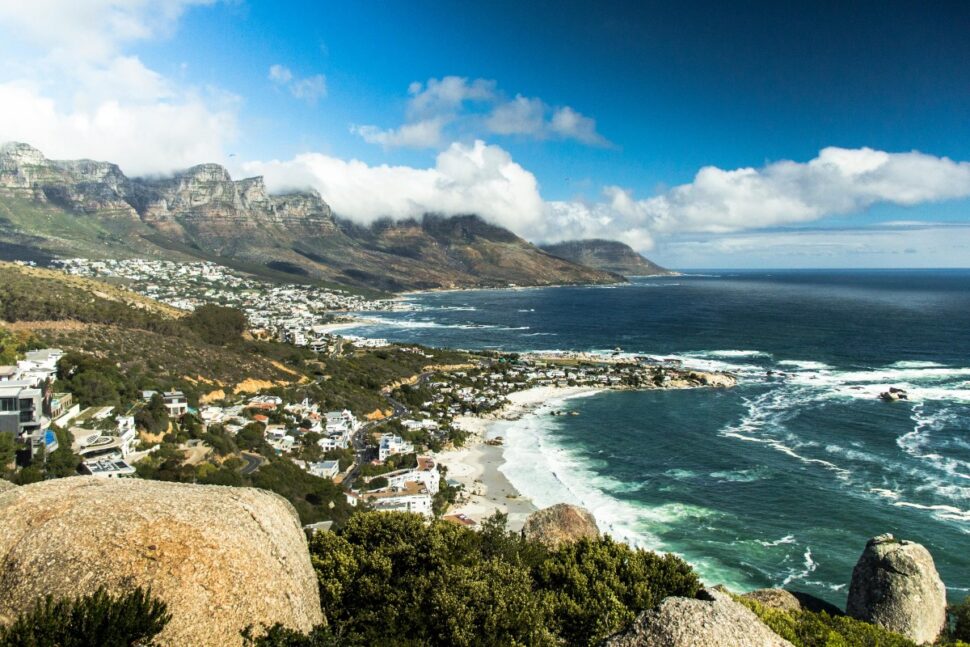
Best Time to Visit : May to September for dry weather and prime safari season; whale watching along the coast is best from June to December.
Things to Do: Embark on a thrilling safari in Kruger National Park, one of Africa’s premier wildlife reserves. Go wine tasting in the Stellenbosch Winelands. Explore Cape Town , a vibrant city boasting stunning scenery, Robben Island, and Table Mountain. Learn about the country’s complex history at the Apartheid Museum in Johannesburg.
Where to Eat: Savor Cape Malay cuisine in Cape Town, a fusion of Malay, Dutch, and indigenous African flavors. Sample South African wines, some of the finest in the world. Enjoy a traditional South African braai (barbecue) with friends or family.
Where to Stay: Choose from luxurious safari lodges in Kruger National Park, boutique hotels in Cape Town, or charming guesthouses in the winelands.
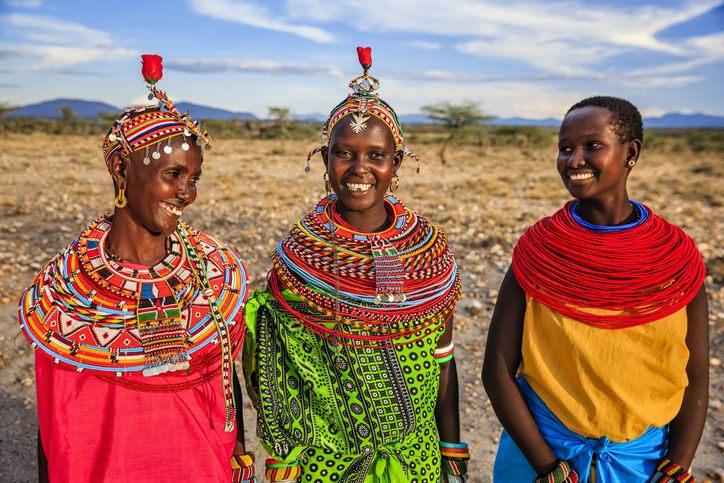
Best Time to Visit: June to October for the Great Migration; December to February for warm weather on the coast.
Things to Do: Witness the awe-inspiring Great Migration in the Masai Mara National Reserve, where millions of wildebeest and zebra embark on an annual journey. Go on a thrilling hot air balloon ride over the savanna for breathtaking views. Visit a traditional Maasai village and learn about their unique culture. Relax on the pristine beaches of Mombasa or Diani Beach.
Where to Eat: Sample Kenyan street food like mandazi (fried dough) or chapati (flatbread). Enjoy fresh seafood dishes on the coast. Savor a traditional Kenyan meal of ugali (cornmeal porridge) and sukuma wiki (collard greens).
Where to Stay: Luxurious tented camps in the Masai Mara offer an immersive safari experience. Beachfront resorts in Mombasa and Diani Beach cater to those seeking relaxation. Budget-friendly lodges and guesthouses are also available.
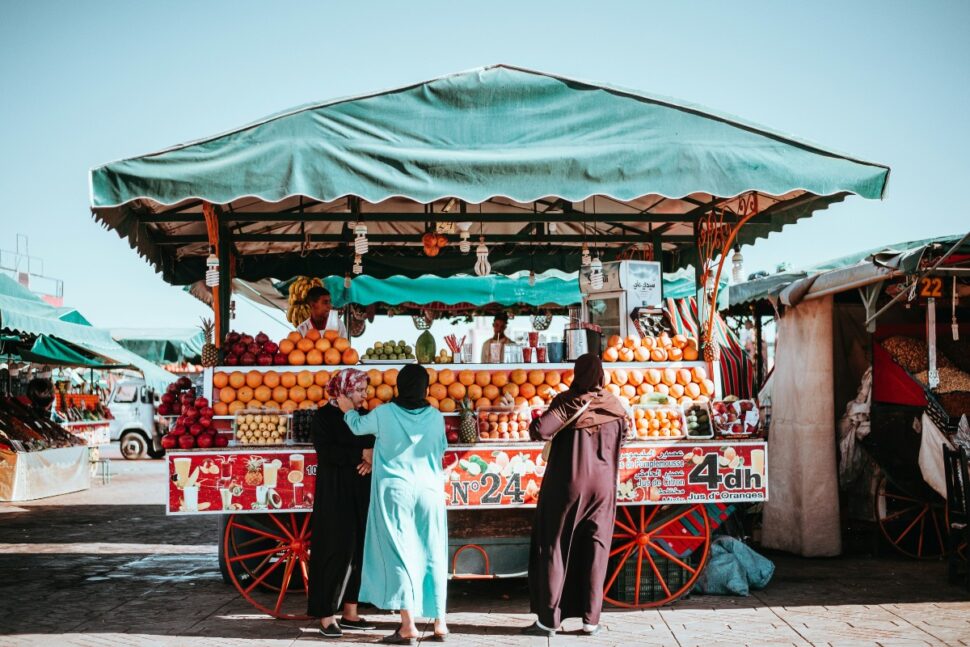
Best Time to Visit: March to May and September to November for pleasant weather. Avoid the scorching heat of the summer months.
Things to Do: Immerse yourself in the vibrant culture of Marrakech, a labyrinthine city with bustling souks, historical palaces, and delicious street food. Hike or ride camels through the majestic Erg Chebbi dunes in the Sahara Desert. Explore the ancient city of Fes, a UNESCO World Heritage Site known for its historic medina and leather tanneries.
Where to Eat: Sample traditional Moroccan dishes like tagine (stew) and couscous in a riad (traditional Moroccan house turned hotel). Enjoy fresh mint tea, a staple beverage in Morocco. Indulge in sweet pastries like baklava for dessert.
Where to Stay: Stay in a riad for a truly authentic Moroccan experience. Luxury desert camps offer a unique way to experience the Sahara Desert . Modern hotels are also available in major cities.
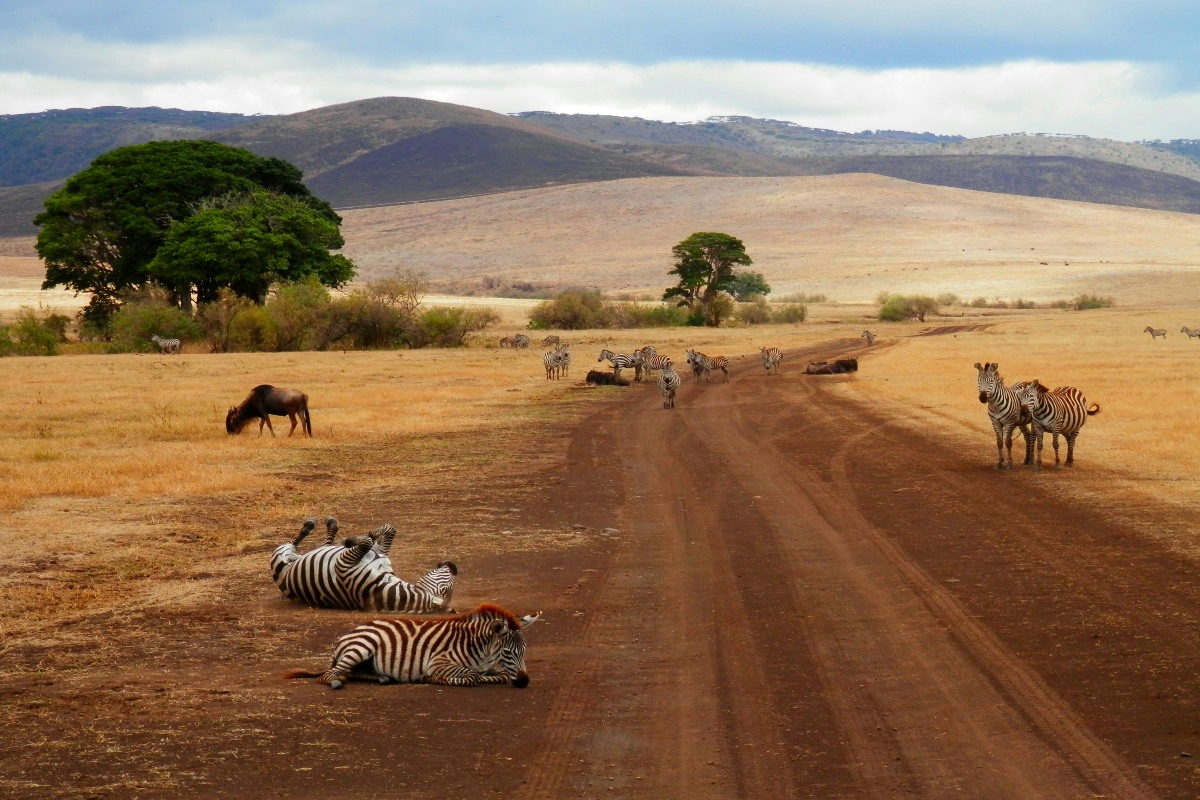
Best Time to Visit: June to October for the Great Migration in the Serengeti National Park; December to February for warm weather on the coast. Climbing Mount Kilimanjaro is best attempted during the dry season (December to February or June to September).
Things to Do: Witness the awe-inspiring Great Migration in the Serengeti National Park, a spectacle that has to be seen to be believed. Challenge yourself by climbing Mount Kilimanjaro, the highest mountain in Africa (not for the faint of heart!). Relax on the beautiful beaches of Zanzibar, an island paradise with a rich history. Explore the Ngorongoro Crater, a UNESCO World Heritage Site with a diverse range of wildlife.
Where to Eat: Savor fresh seafood dishes like grilled octopus or coconut curry on the beaches of Zanzibar. Sample Tanzanian staples like ugali (cornmeal porridge) and mchicha (spinach) with meat or fish stew. Enjoy a cup of strong Tanzanian coffee, a popular way to start the day.
Where to Stay: Luxurious tented camps in the Serengeti offer an unforgettable safari experience. Beachfront resorts in Zanzibar cater to those seeking relaxation. Budget-friendly lodges and guesthouses are also available in most areas.

Best Time to Visit: May to September for dry weather and prime safari season; the Okavango Delta is best experienced from March to May when the floodwaters are at their peak.
Things to Do: Embark on a luxurious safari in the world-renowned Okavango Delta, a unique ecosystem teeming with wildlife. Go mokoro (traditional dugout canoe) rides through the waterways for a unique perspective. Explore the Chobe National Park, famous for its large elephant herds. Witness the awe-inspiring Victoria Falls, one of the Seven Natural Wonders of the World (shared with Zambia).
Where to Eat: Enjoy gourmet meals prepared by top chefs at luxurious safari lodges. Sample Botswanan cuisine like seswaa (pounded salted meat) or pap (cornmeal porridge) at local restaurants.
Where to Stay: Luxurious safari lodges in the Okavango Delta offer unparalleled service and stunning views. Budget-friendly options like guesthouses and campsites are also available in some areas.
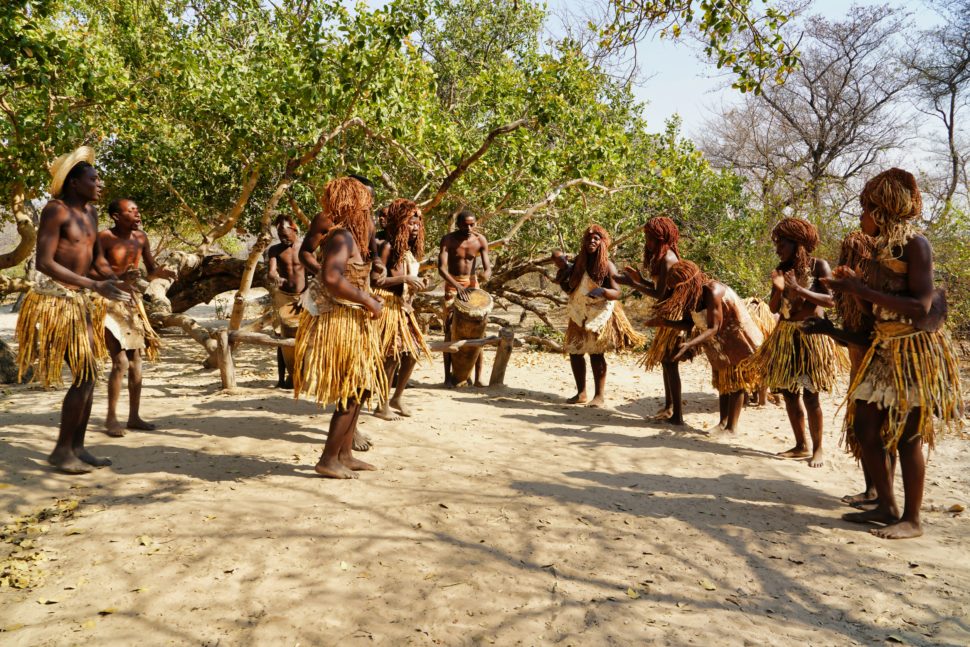
Best Time to Visit: April to October for dry weather and pleasant temperatures; the Skeleton Coast is best explored from December to March.
Things to Do: Explore the otherworldly Namib Desert, a landscape of towering sand dunes, dramatic canyons, and unique wildlife. Witness the Sossusvlei, a stark desert landscape with iconic red sand dunes. Drive along the Skeleton Coast, a shipwreck graveyard with a fascinating history. Go stargazing in the NamibRand Nature Reserve, one of the darkest places on Earth.
Where to Eat: Sample Namibian cuisine like oshiwambo (millet porridge) or mopane worms (a local delicacy) at local restaurants. Enjoy fresh seafood dishes like oysters or lobster along the coast.
Where to Stay: Choose from luxurious desert lodges with stunning views, comfortable guesthouses in towns, or campsites for a more adventurous experience.
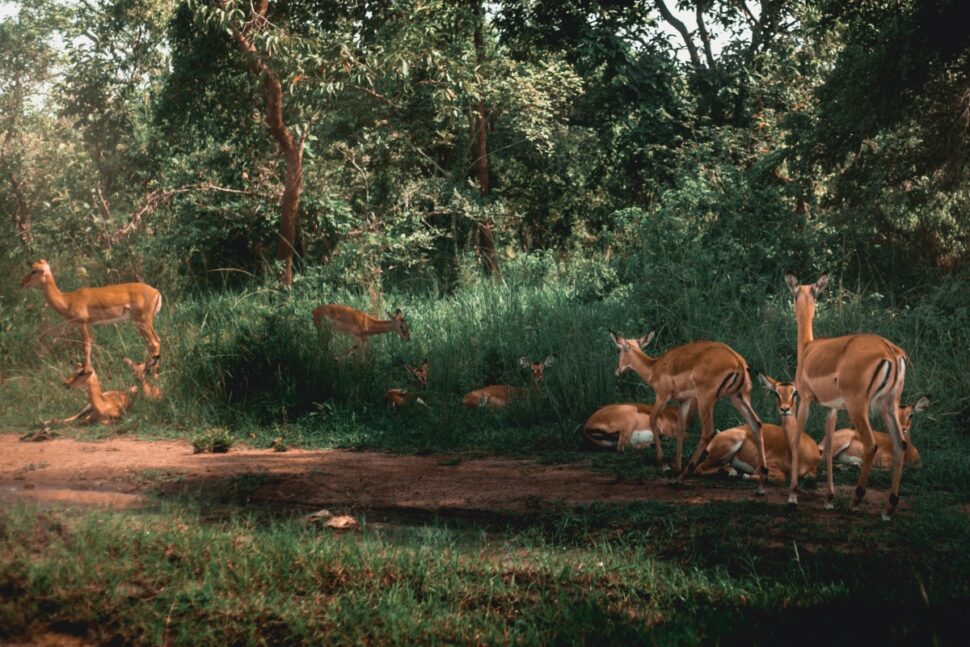
Best Time to Visit: June to August and December to February for dry weather with comfortable temperatures for gorilla trekking.
Things to Do: Embark on a life-changing experience by trekking to see mountain gorillas in Volcanoes National Park. Explore the vibrant capital city of Kigali, a hub of art, culture, and history. Visit a traditional Rwandan village and learn about the country’s unique culture. Go on a chimpanzee trekking adventure in Nyungwe National Park.
Where to Eat: Savor Rwandan staples like matoke (steamed green bananas) and brochettes (skewers of grilled meat or fish). Sample local Rwandan coffee, known for its rich flavor. Enjoy fresh juices made from tropical fruits.
Where to Stay: Choose from comfortable lodges and guesthouses near Volcanoes National Park, boutique hotels in Kigali, or eco-lodges offering a sustainable travel experience.
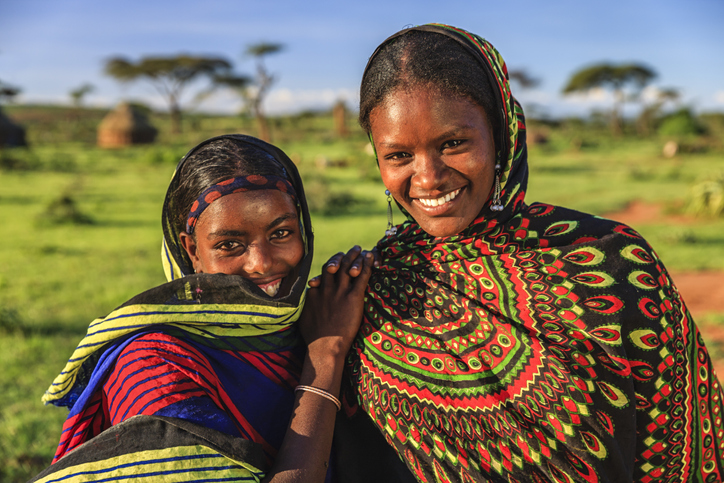
Best Time to Visit: September to May for pleasant weather; avoid the rainy season from June to August.
Things to Do : Explore the ancient rock-hewn churches of Lalibela, a UNESCO World Heritage Site. Hike the Simien Mountains, a breathtaking mountain range with stunning scenery and unique wildlife. Visit the historical city of Gondar, once the capital of the Ethiopian Empire. Immerse yourself in the vibrant culture of Addis Ababa, the capital city.
Where to Eat: Sample Ethiopian cuisine like injera (sourdough flatbread) served with stews of vegetables, lentils, or meat. Enjoy a cup of Ethiopian coffee, brewed in a traditional jebena (clay pot). Indulge in sweet pastries like baklava for dessert.
Where to Stay: Choose from historic hotels in cities like Gondar, comfortable lodges near the Simien Mountains , or modern hotels in Addis Ababa. Budget-friendly guesthouses are also available in most areas.
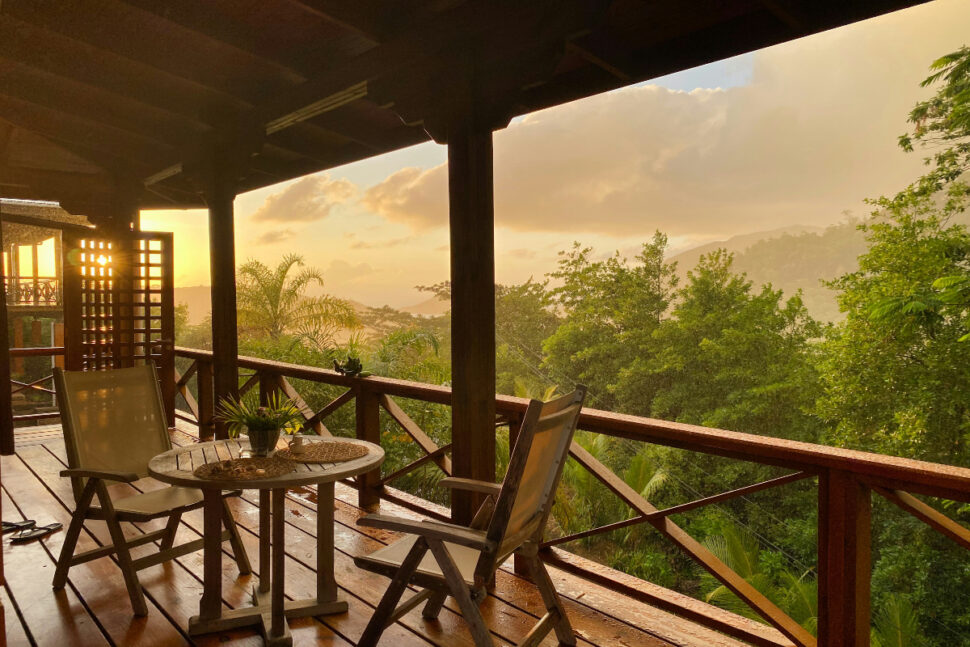
Best Time to Visit: May to November for dry weather and calm seas; December to April can be hot and humid with occasional rain showers.
Things to Do: Relax on the pristine beaches of Mahé, the largest island, or explore the secluded beaches of other islands like Praslin and La Digue. Go snorkeling or scuba diving in the crystal-clear waters teeming with colorful marine life. Hike through lush rainforests and explore hidden waterfalls on some islands. Go island hopping and discover the unique beauty of each island in the Seychelles archipelago.
Where to Eat: Savor fresh seafood dishes like grilled fish or lobster curries. Sample Seychellois cuisine with Creole influences, featuring tropical fruits, spices, and fresh ingredients. Enjoy tropical cocktails made with local rum and fresh juices.
Where to Stay: Choose from luxurious beachfront resorts offering all-inclusive packages, charming guesthouses on smaller islands, or self-catering villas for a more independent experience.

Best Time to Visit: May to September for dry weather and the best views of Victoria Falls; October to April can be wet with the falls at their most powerful.
Things to Do: Witness the awe-inspiring Victoria Falls, one of the Seven Natural Wonders of the World, from the Zambian side. Embark on a thrilling safari adventure in South Luangwa National Park, known for its abundance of wildlife, including lions, leopards, and elephants. Go white-water rafting on the mighty Zambezi River for an adrenaline rush. Explore the cultural heritage of Livingstone, a town named after the famous explorer.
Where to Eat: Savor Zambian cuisine like nshima (cornmeal porridge) with relish (stewed vegetables or meat). Sample fresh fish dishes from Lake Kariba. Enjoy a Zambian beer or a refreshing cup of local coffee.
Where to Stay: Choose from luxurious lodges with stunning views of Victoria Falls, comfortable safari camps in South Luangwa National Park, or guesthouses in Livingstone offering a budget-friendly option.
Safe Travels
This list just scratches the surface of the best countries to visit in Africa and the incredible experiences Africa has to offer. From the breathtaking landscapes and diverse wildlife to the rich cultures and warm hospitality, Africa is a continent that will leave a lasting impression on any traveler. So, start planning your African adventure today and discover the magic for yourself!
Subscribe to travel noire
Get more travel content
Subscribe to Travel Noire, a free daily newsletter that features the best of travel, destinations, and guides to the cities you love from a new point of view — yours.
By subscribing to this newsletter, you agree to our terms of service and privacy policy.
Popular posts
Trending stories in world travel
I've been on over 100 safaris across Africa and repeatedly see tourists make 11 big mistakes, from sleeping in to ignoring birds
- I've been on over 100 safaris and often see tourists make the same mistakes time and again.
- Some ignore birds, while others exit the vehicle to get closer to wildlife, which is dangerous.
- Here's my advice on what not to do on safari, plus tips to improve your chances of seeing wildlife.

I'm a travel writer living in Nairobi, and I've been on more than 100 safaris across Africa.
I currently live in Nairobi, Kenya, working as a travel writer and vlogger, and have been to about 15 countries in Africa over the last 10 years.
As part of my travels, I often go on safari where I'm always awed by how large elephants are, the cunning nature of hyenas, the agility of leopards, the social life of lions, and the beauty of lilac-breasted rollers.
I've been on well over 100 safaris for leisure or on assignment as a journalist, in countries like Tanzania, Uganda, Zambia, and my home, Kenya.
On many of those safaris, I've shared vehicles with other tourists, and met travelers from all over the world, from the United States to Russia and Europe. I've also observed some common mistakes that people seem to make when they take this type of trip.
Here are the biggest safari mistakes to avoid, plus my tips for how to maximize your experience.
Most often, I've observed tourists become disappointed when they don't see wildlife.
I've been to most of the wildlife parks in Kenya, like Amboseli , Samburu , Shaba , Tsavo East & West , Meru , and Lake Nakuru National Parks .
I always find the big cats impressive here, such as lionesses chasing a zebra through the plains, or a leopard hauling its prey up a tree as hyenas circle below hoping it falls.
On a recent safari, I observed two-month old lion cubs, still too young to eat meat, lapping up blood from a gazelle that their mother hunted and dragged under the shade of bushes. This sighting was, however, at the end of a three-hour morning game drive.
Whenever I'm sharing a vehicle with other tourists, particularly first timers, I see some becoming impatient after a few hours without such sightings.
It's understandable; you've come to Africa for the safari of a lifetime, and want to see and photograph it all. But as I've learned, you can't set up an appointment with wildlife. Sometimes, a leopard remains elusive.
I think you'll have a better time if you're able to relax and enjoy the sightings as they come.
In addition to being patient on drives, I don't think visitors communicate what they hope to see to their guide, or make enough attempts.
If there's an animal you really want to see, speak up.
Guides can use their expertise and knowledge of the landscape to drive to the areas where they know that you're more likely to spot the animals that you hope to see.
You should also plan to go on more than one game drive. For a two to three-day trip, I recommend going for both morning and evening drives, every day, to maximize your chances.
One of the biggest mistakes tourists make is thinking they can get out of the vehicle to take photos with wildlife. It could risk your life.
While on safari, I've seen tourists in other vehicles get out in areas to try and get close to wildlife where park rules prohibit them to do so.
You should always stay in the safari vehicle, and if you need to get out, communicate that to your guide who knows the landscape and will advise if it's safe.
Rather than risk your life, there are other places you can go if you want to get up close with animals.
In Nairobi, I like to spend time with orphaned baby elephants at Sheldrick Wildlife Trust and watch them mud bathe and guzzle milk formula. Another option I recommend is to feed pellets to Rothschild Giraffes at Giraffe Center.
And at Mosi-Oa-Tunya National Park in Zambia, visitors may join rangers to track the endangered southern white rhinos on foot, which will place you within a few feet of the animals.
Not only are experiences like these safe, but they still provide the thrill of an up-close encounter, and proceeds usually go back to the continued protection of the wildlife.
Often, I meet tourists who only go to the most popular parks, and in the high season. Then, they complain about how crowded it is.
Some of Africa's best-known parks are Serengeti National Park in Tanzania, Maasai Mara Game Reserve in Kenya, and Kruger National Park in South Africa. And I understand the popularity — all of these destinations have an abundance of wildlife and stunning landscapes.
According to Safari Outfitter & Beyond , who I've been with on safari a few times in Serengeti and Maasai Mara, the best time for a Kenyan safari is the high season from June to October, when sparse vegetation and limited water draws wildlife to waterholes making them easier to spot.
But because of this phenomenon, I've always found this time period to be busy and crowded, which can take away from the experience.
In my experience, guides tend to work collaboratively and radio one another whenever there's a sighting, and when word gets out that a coalition of cheetahs were spotted, soon there are 20 cars charging to surround them at the same time. I also find the parks become particularly busy during the annual wildebeest migration season, and lodges get fully booked as tourists travel to witness it.
I've seen first-timers then become frustrated that the experience isn't the remote safari they pictured.
If you prefer less crowds, choose a less popular park, or consider a visit at another time.
I've seen many tourists wrongly assume that Africa is hot all the time, and fail to pack warm clothing.
In my experience, visitors to Africa tend to have the perception that it will be really hot, all the time. I think this is probably because of documentaries and movies they might have watched where people are dressed as such, and that's how the landscape is portrayed.
But I've found that isn't always the case. I've experienced many cold nights in some parks, even if it's not the rainy season when it can be cold and wet.
According to Masai Mara , temperatures in that park can range between 52 and 82-degrees Fahrenheit, and I know it will feel quite cold when it hits that lower end.
I suggest that visitors bring warm clothing to layer like jackets, scarves, and even gloves. Plus, some safari vehicles are open on the sides, and in my experience, this can make it feel really cold when driving fast during the day, too.
Another big mistake I've witnessed is choosing not to wake up early for game drives.
Guides have explained to me that the best times for game drives are the cooler hours of the day, around sunrise and sunset.
They say this is because it's when the weather is more comfortable for animals. During later parts of the day, guides have said that animals prefer to stay tucked away under the shade to avoid the scorching heat. This means it's less likely you'll see much action if you choose to head out only in the afternoon.
To increase my chances of seeing wildlife, I choose morning drives that require wake-up calls as early as 4:30 a.m. On those drives, I've shared a vehicle with others where I heard them complain that it's too early.
It definitely is, and the roads can be rough, and the drives can be long and tiring, particularly if it's several days back to back. But I know morning is the best time to go if you want to see as many animals as possible.
I've spotted wildlife later in the day, too, but whenever I've come across a pride of lions around midday, for instance, they're usually sleeping.
Discuss with your guide to figure out a schedule that works best for you. If you can wake up early, though, I find the sunrises over the African bush are always so spectacular. Why would you want to miss such beauty?
Ignoring bird life is another commonly-made mistake.
It took me around 30 game drives to finally get into birdwatching.
I started off indifferent, but now I squeal with excitement when I spot a Marshall Eagle with its large wing-span perched atop a tree at Shaba National Reserve in Kenya, or if I've eyed a small gazelle, or a kettle of vultures stealing a zebra carcass from a hyena.
I wish I knew sooner that birds are really cool, and I think many visitors make this same mistake because they become too focused on just large wildlife.
I finally came to this realization thanks to helpful guides I met who helped me learn interesting facts about birds and their social life, and now I'm always left wanting to know more.
I don't think many people realize that there are many ways to do a safari.
With over 100 safaris under my belt, I've been on so many game drives that I started getting a little jaded about driving around and seeing animals from a land cruiser, every time.
So I decided to switch things up recently, and I don't think many people know there are other ways to see wildlife besides from a car.
I've now been on several hot air balloons, from which I've spotted elephants in Amboseli National Park with Mt. Kilimanjaro's snow-capped peak in the background. And it was from a balloon that I tracked black rhinos through the mud one rainy morning in Borana Conservancy .
I've also enjoyed camel-back safaris, boat cruises, and sunset walking safaris, and recommend working them into your itinerary to experience different perspectives.
Please stop bringing plastic bags and bottles into the parks.
Countries like Kenya and Rwanda have banned single-use plastics including water bottles, straws, disposable cups, and cutlery in protected areas like parks, forests, and beaches.
You're often not even allowed to bring your plastic bag carry-ons through the airports. According to section 144 of Kenya's Environmental Management and Co-Ordination act , if you're caught breaking this law, there are severe fines of one to four years in jail, or a $16,000 fine.
And while I haven't heard of cases of tourists being charged or fined, I still often see them trying to bring these items into the parks, where they're usually confiscated.
I think it's better to just plan ahead and adhere to the law, and also to make more efforts to be respectful of the land to preserve it for generations to come.
I wish lodge guests would be more considerate of others and keep the volume of their music down.
In my experience, many rooms at overnight lodges are located really close to each other.
In a few instances, I've struggled to sleep or relax as guests next to me played really loud music.
I can appreciate a good playlist as much as the next person, but I wish more tourists would be more considerate of other guests.
I find going to the bush to be a time for serenity and disconnecting from the bustle of city life. Returning to blasting music detracts from that feeling, in my opinion.
Instead, turn your music off and take your stay as a chance to listen to the sweet cacophony of nature. And should you strongly desire to still listen to Drake over the hippos grunting in the distance, please just keep your volume at a reasonable level.
Finally, I think too many tourists don't take advantage of the low season when it's much easier to plan a safari on a budget.
In the low season between March and May when there is often heavy rain, the roads get muddy and vegetation grows tall and thick.
In my experience, this draws less tourists, and as a result, lodges tend to reduce rates to attract visitors. I've found you can save a lot of money if you visit then instead of high season.
So if you're looking to go on safari on a budget and don't mind getting wet from time to time, you might want to come during this period, since I've seen firsthand that the wildlife is still visible. I also think it's a unique time since the vegetation is lush and green, the bird life is abundant, and new calves are birthed.
I've also seen that fewer tourist numbers means less congestion of vehicles in parks for a more isolated experience.
- Main content

IMAGES
VIDEO
COMMENTS
The Serengeti is one of Africa's finest safari destinations. Extending over 14,763km²/5,700mi² of undulating plains and isolated koppies (rocky hills), the Serengeti is Tanzania's oldest, largest and most famous national park. The Serengeti is renowned for hosting an annual migration comprising at least 2 million wildebeest, plains zebra ...
Serengeti National Park is renowned for its wildlife, and clocking in at over 5,500 sq. miles, there are plenty of predators in residence. From the safety of your vehicle, keep your eyes peeled for Africa's iconic Big Five: lions, elephants, rhinos, leopards and buffalo. Some animals, like the endangered black rhino, can be elusive, and many ...
Find out how to combine Wildebeest Migration safaris with Big 5 encounters and tropical island finales with our best Serengeti safari tours. Int Toll Free Numbers 1-866-438-8677. 1-888-360-2392; 1-800-619-441; 0800-404-9451 +27-21-481-4900 ... Our African Safari Experts are equipped with over two decades of first-hand knowledge and experience ...
4 Days Serengeti, Ngorongoro and Tarangire Fly-In Lodge Safari From Zanzibar. Price: $2300 per person. Tour Type: Lodge Safaris, Private Safaris, Fly In Safaris. Place Visited: Tarangire, Serengeti, Ngorongoro Crater, Zanzibar. Explore this Tour.
Serengeti is arguably the world's most famous national park - for good reason. This is where the Great Wildebeest Migration takes place each year and where some 3 000 lions and 1 000 leopards control the 15 000 square kilometres of plains and savannah woodland. This unique ecosystem is the only place on earth that can sustain the wildebeest ...
Use our FREE travel guide and safari reviews to learn about Serengeti's wildlife, best time to visit, climate and more! Menu. Safaris & Tours. Botswana (401) ... Philip is a renowned Africa expert and author of many Bradt guidebooks to African destinations, including the guide to Tanzania.
Experience thrilling Serengeti game drives and then return to the lodge for a luxurious respite at Four Seasons Safari Lodge Serengeti, Tanzania. ... Contemporary African-design elements and a shaded private terrace capture the essence of the untamed plains outside, while a deep soaking tub, a refrigerated bar and a flat-screen TV provide all ...
4-Day Serengeti Fly in, Fly out Safari Luxury Safari. $2,475 to $2,640 pp (USD) Tanzania: Private tour Luxury Lodge & Tented Camp. You Visit: Zanzibar (Start), Central Serengeti NP, Serengeti NP, Ngorongoro Highlands, Zanzibar (End) Safari Soles. 5.0 /5 - 246 Reviews. Top Rated Operator.
Private concessions and conservancies. Scenery. Wildebeest Migration. Wildlife and safari. [email protected]. Go2Africa House, 12A Portswood Road. V&A Waterfront, Cape Town 8001, South Africa. Migrating wildebeest, dramatic river crossings & all the big predators - it doesn't get much better than a Serengeti safari - let the experts take you.
Tanzania Safari: Embark on an unforgettable adventure with the best Serengeti Great Migration safari, where you'll witness one of the world's most awe-inspiring. Menu. Safaris & Tours. Botswana (363) ... SafariBookings is the largest online marketplace for African safari tours. Easily compare offers from top-rated tour operators.
Estimated reading time: 18 minutes. The Serengeti is undoubtedly one of the world's most celebrated national parks and a perfect snapshot of true African wilderness. Its great rolling grasslands and golden savannah give you an awe-inspiring sense of space and support large populations of zebra, buffalo, elephant, giraffe, gazelle and antelope ...
Where is the Serengeti National Reserve located? The Serengeti National Reserve is located in Northern Tanzania, East Africa.It covers an area of approximately 14,750 square kilometers and is part of the larger Serengeti-Mara ecosystem that extends into neighboring Kenya.The Serengeti-Mara ecosystem is one of the largest and most protected ecosystems on earth, spanning 40,000 square kilometers ...
The Serengeti ecosystem is a geographical region in northern Tanzania, bordering Kenya, Lake Victoria, and the Ngorongoro Conservation Area. It's also a UNESCO-listed World Heritage national park that offers year-round safari adventures. The wonder and excitement of a Serengeti safari can be enjoyed in the low season when fewer tourists crowd ...
Serengeti is probably one of the most well-known safari destinations in Africa. It has been awarded the best national park in the world multiple times and is known to be the place to witness the greatest wildlife show on earth, the Great Wildebeest Migration. ... If you are looking for the cheapest Serengeti safari tours and have limited time ...
See All Reviews. [email protected]. Go2Africa House, 12A Portswood Road. V&A Waterfront, Cape Town 8001, South Africa. The utimate bush-to-beach itinerary. Enjoy front-row seats to the Wildebeest Migration in the Serengeti before capping your Tanzania safari in secluded location.
The Safari Includes A Serengeti Safari, Hot-Air Balloon Ride Over The Savanna. Notice of Right to Opt Out of Sale/Sharing. Some states provide residents (or, in some cases, their authorized agents ...
Tanzania is a true year-round safari destination. The wildebeest migration mass on the short grass plains of the southern and eastern Serengeti from November to May, moving towards the western corridor towards June as the rains finish. From July to September, the herds head north into Kenya's Masai Mara. In October, the skies open once more ...
4. Sanctuary Kichakani Camp. Settle in for an armchair safari with a sundowner | Sanctuary Kichakani Camp. View the most climactic moments of the Great Migration in the lap of luxury at Kichakani Camp. The resplendent mobile camp prides itself on providing prime viewing spots to nature's best show.
The Safari Comfort Accommodation in Africa Safari Serengeti Ikoma is spacious, 50 m2, and furnished with a king-size bed or two single beds. On request another single bed can be placed in the room. The accommodation has a permanent bathroom with walk-in shower, western toilet and a washbasin. The comfortable sitting area in the room and having ...
The Kusini Plains is a remote and very serene corner of Tanzania's south-west Serengeti, perfectly positioned to access the Ngorongoro Conservation Area, as well as the Serengeti National Park - two spectacular game-viewing areas encompassing high concentrations of cheetah, honey badger, golden-backed jackal, and hyena. The surrounding short ...
Trekking Safari Camp and Serengeti Walking Camp provide access to remote parts of the Serengeti, following the migrating herds. The lightweight mobile camps have comfortable mattresses and mosquito mesh sides/tops. For camps & lodges at the best prices and our famous ready-made safari packages, log into our app.
Africa Safari South Serengeti is a comfortable accommodation, located in the Ngorongoro Conservation Area and offers easy access to the crater, while at the same time being on the south side of Lake Ndutu, which is in the Serengeti National Park. The best of both worlds! The nearby airstrip offers connections to the other major airstrips and ...
Dunia Camp's prime position in the south-central Serengeti National Park allows guests prime access to the game laden plains and the annual wildebeest migration. This camp's rustic nature and secluded charm make it a favorite for African safari wildlife enthusiasts looking to split their time between abundant game viewing and peaceful relaxation.
An Africa safari trip promises an enchanted world of discovery, where each expedition and place holds the potential to reveal a captivating tale. Every area of this enormous continent, from the ...
Books on Tanzania and Africa in general; Are you planning a Lake Natron Trip? Are you thinkg of taking a young child on safari; Ellie's Blog Great description of some popular camps and the Eastern Serengeti; Shep's Blog Great information on recent (2021) off the beaten path travel; Lodges and Camps Close to KIA and Arusha National Park
Best Time to Visit: June to October for the Great Migration in the Serengeti National Park; December to February for warm weather on the coast. Climbing Mount Kilimanjaro is best attempted during the dry season (December to February or June to September). Things to Do: Witness the awe-inspiring Great Migration in the Serengeti National Park, a spectacle that has to be seen to be believed.
Some of Africa's best-known parks are Serengeti National Park in Tanzania, Maasai Mara Game Reserve in Kenya, and Kruger National Park in South Africa. And I understand the popularity — all of ...